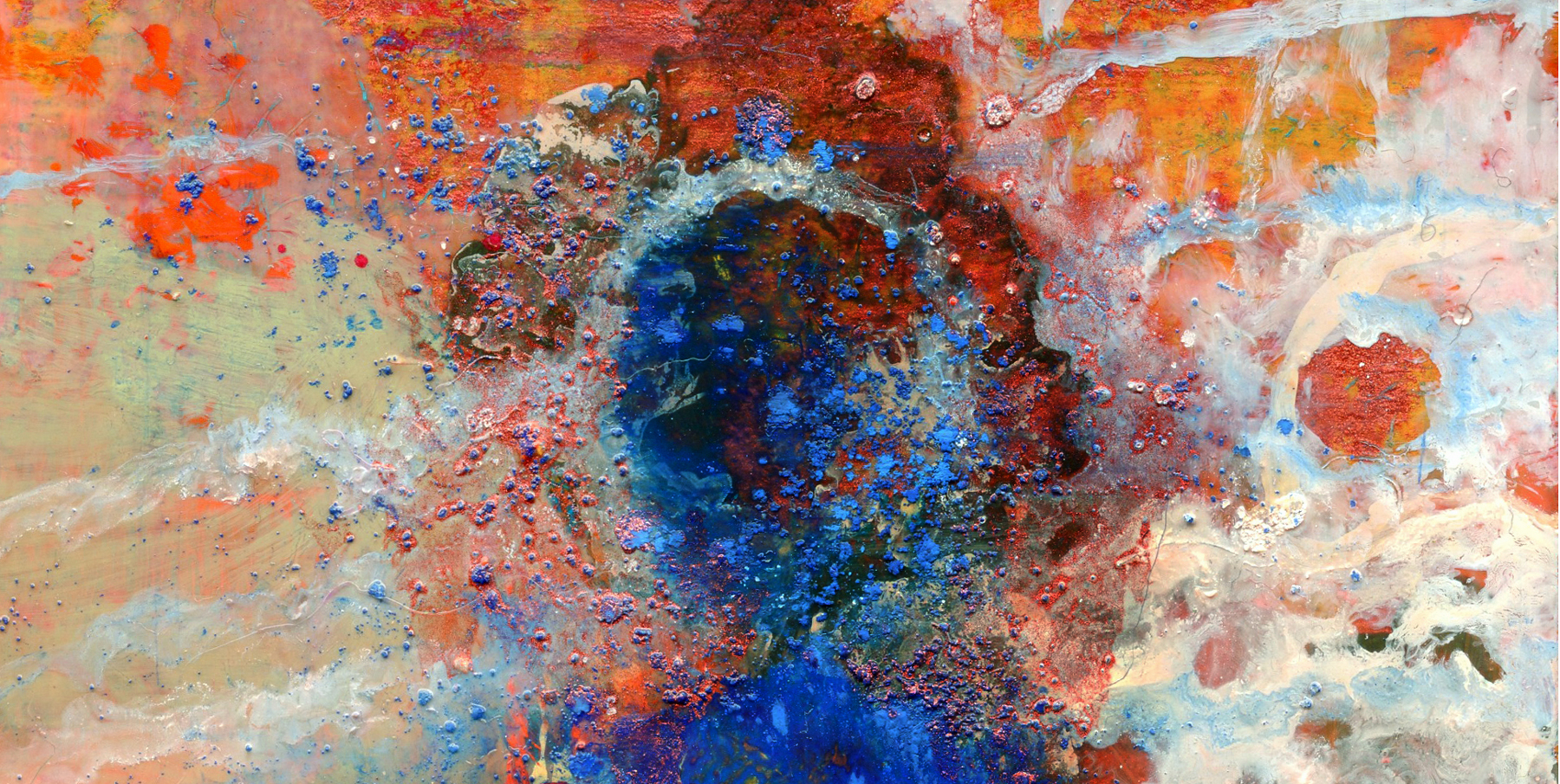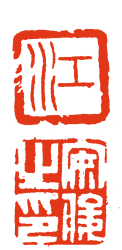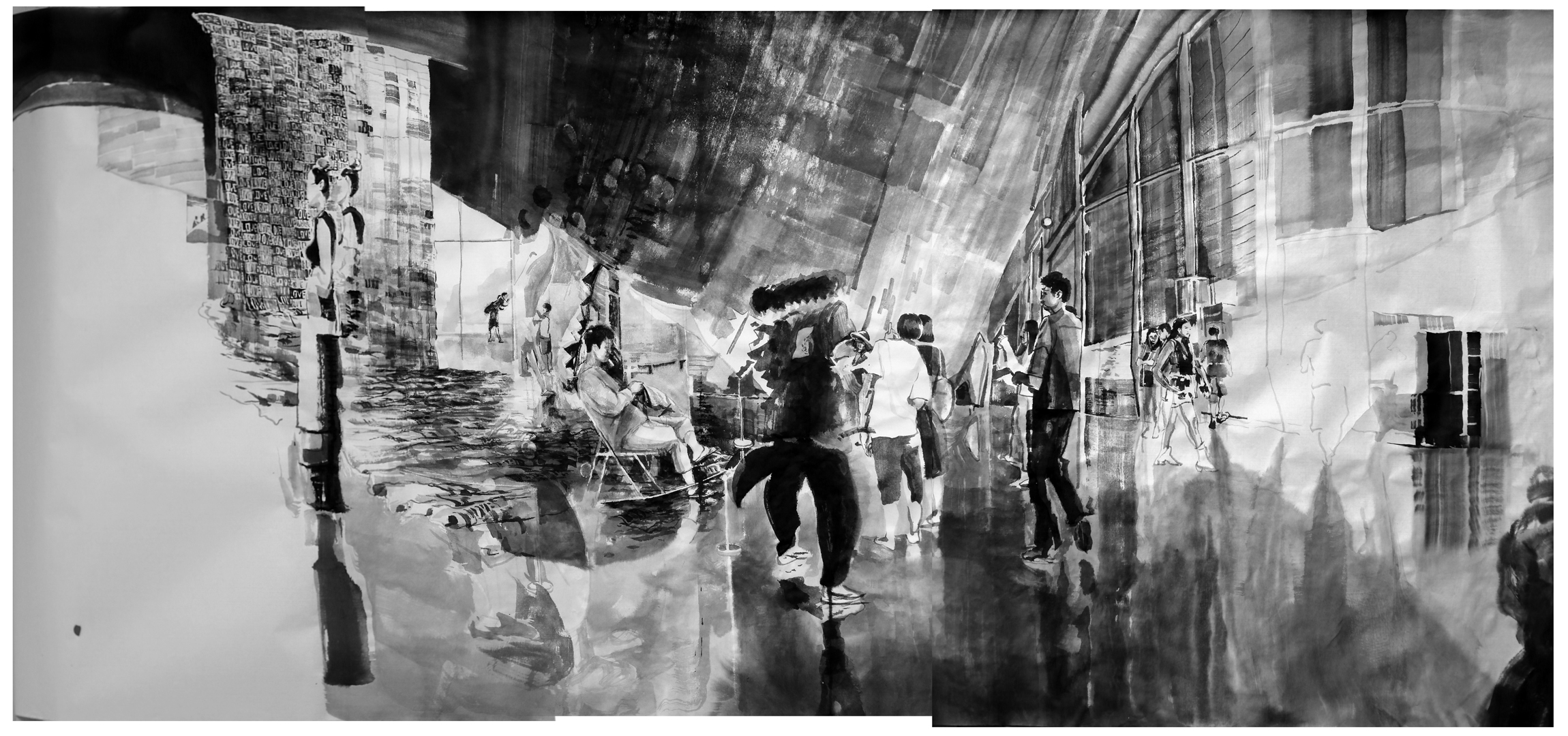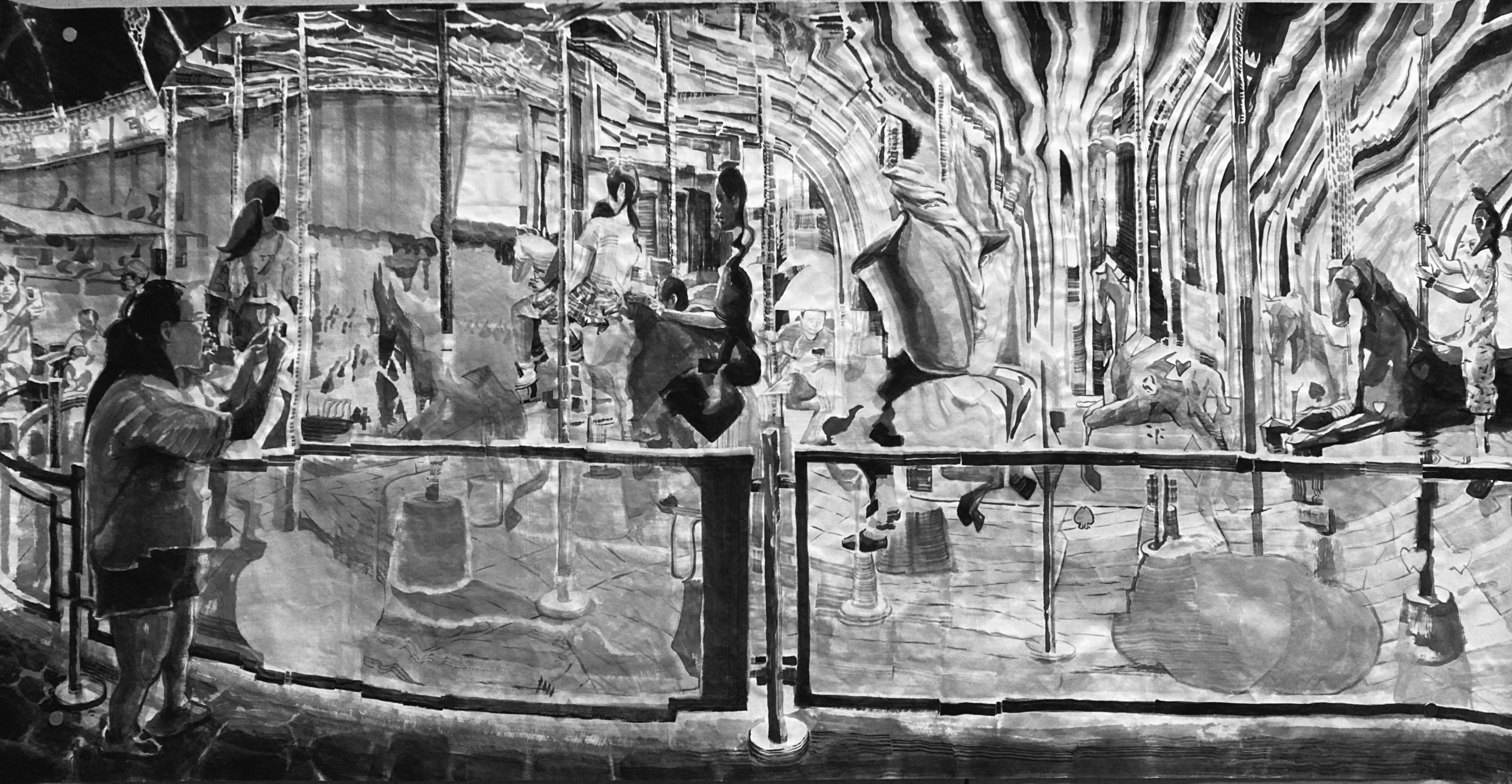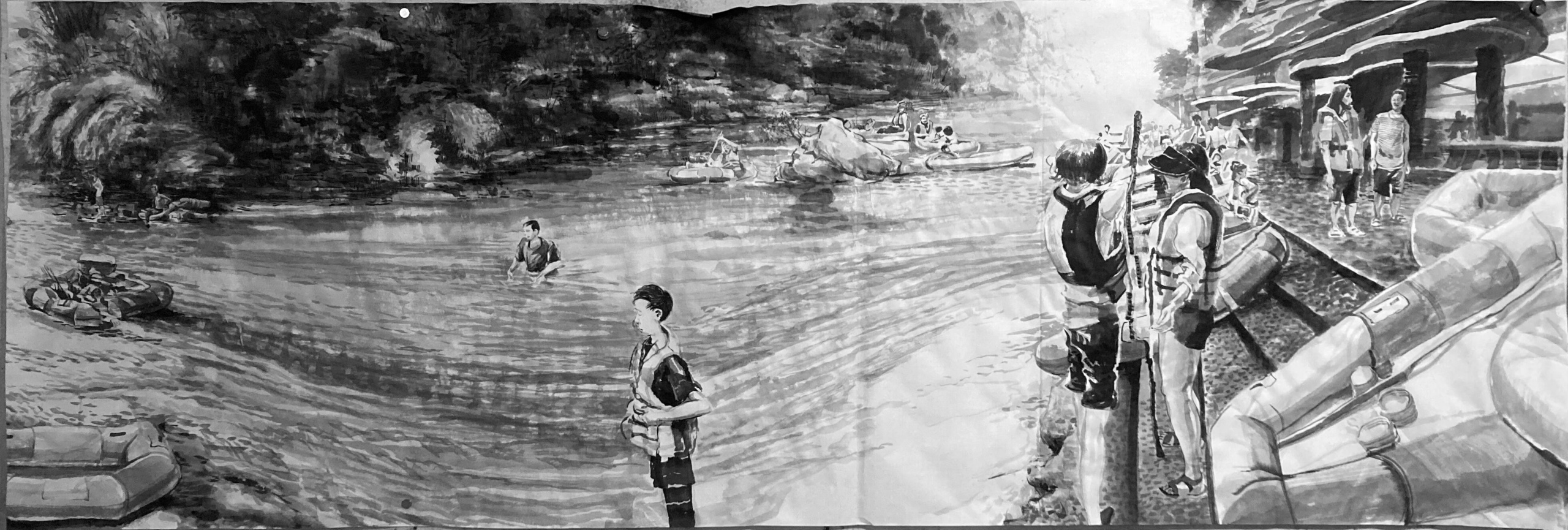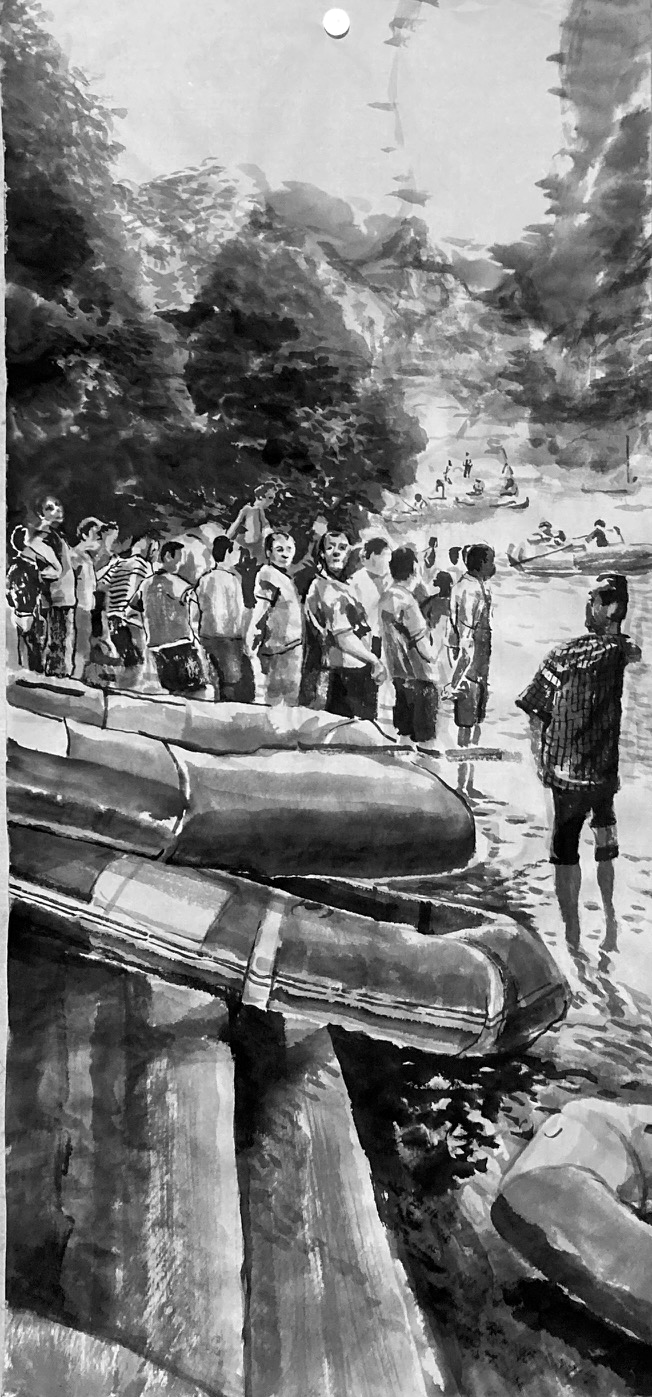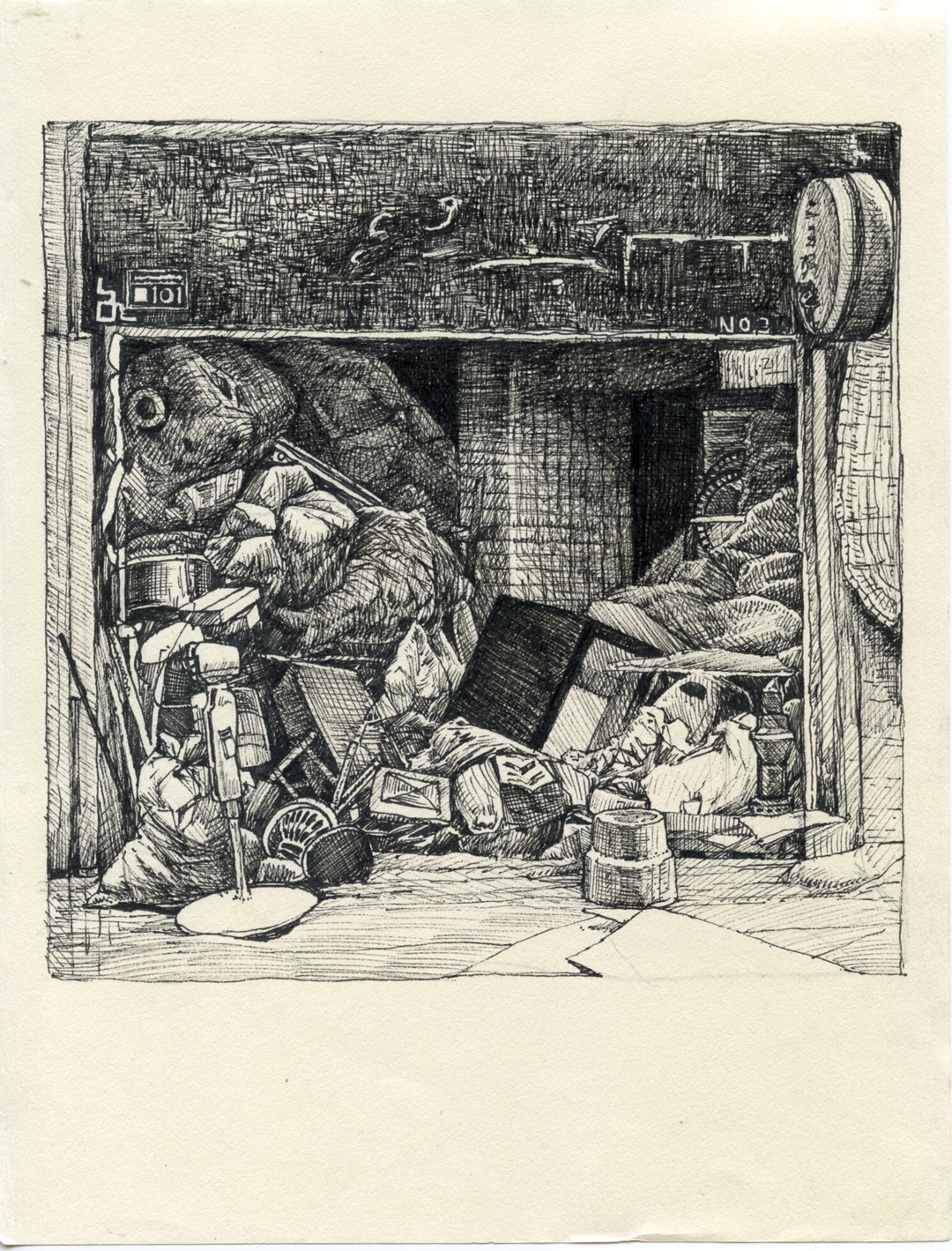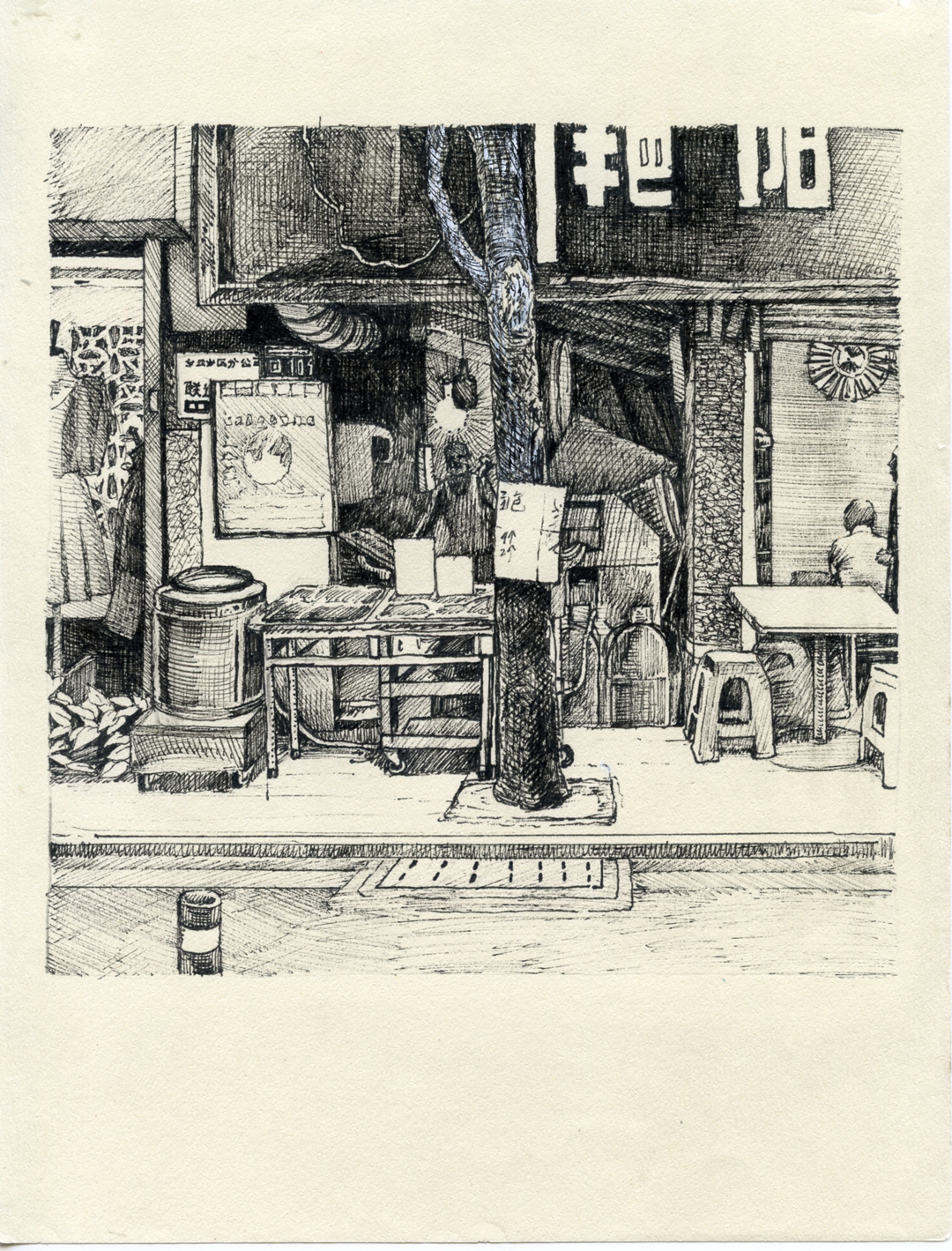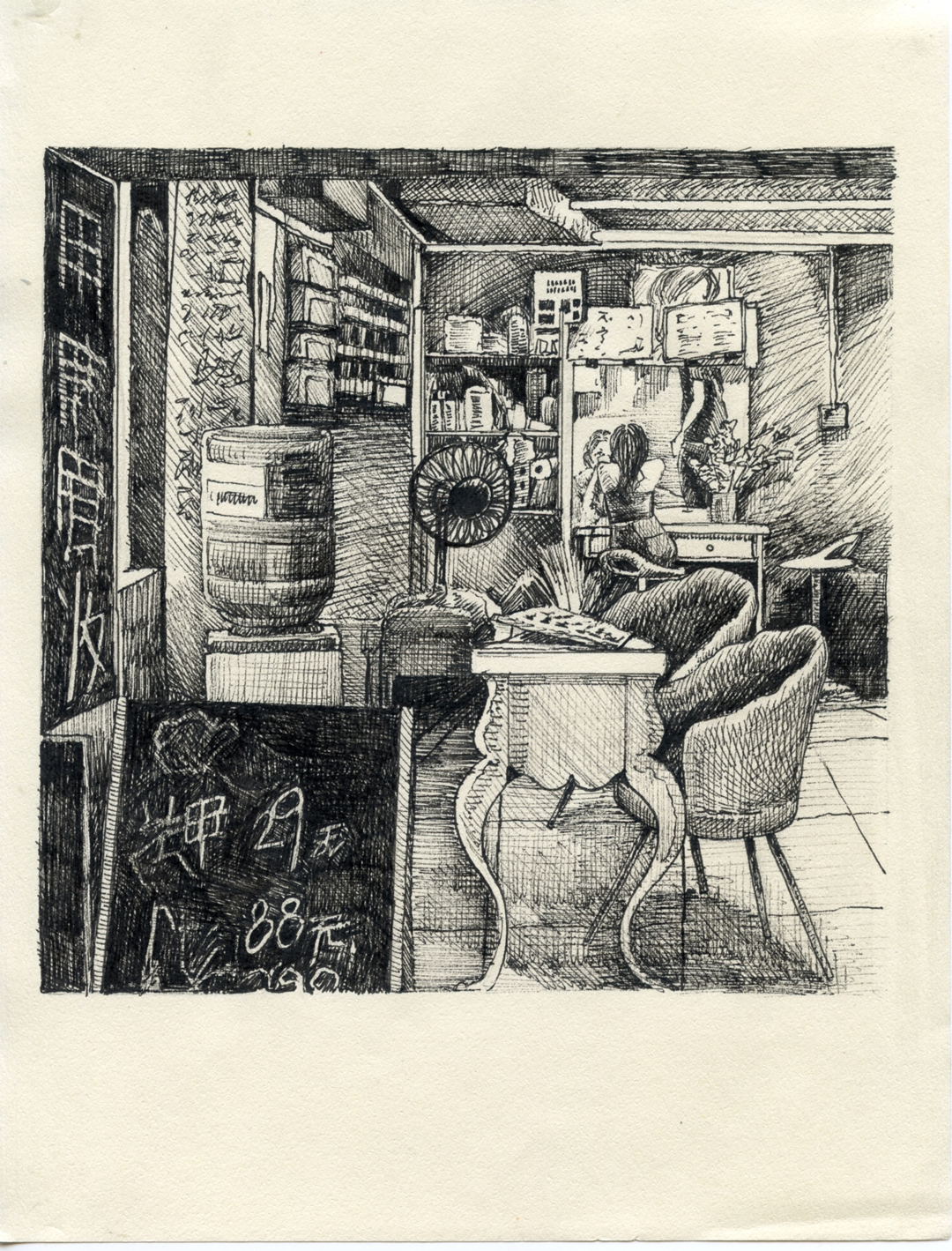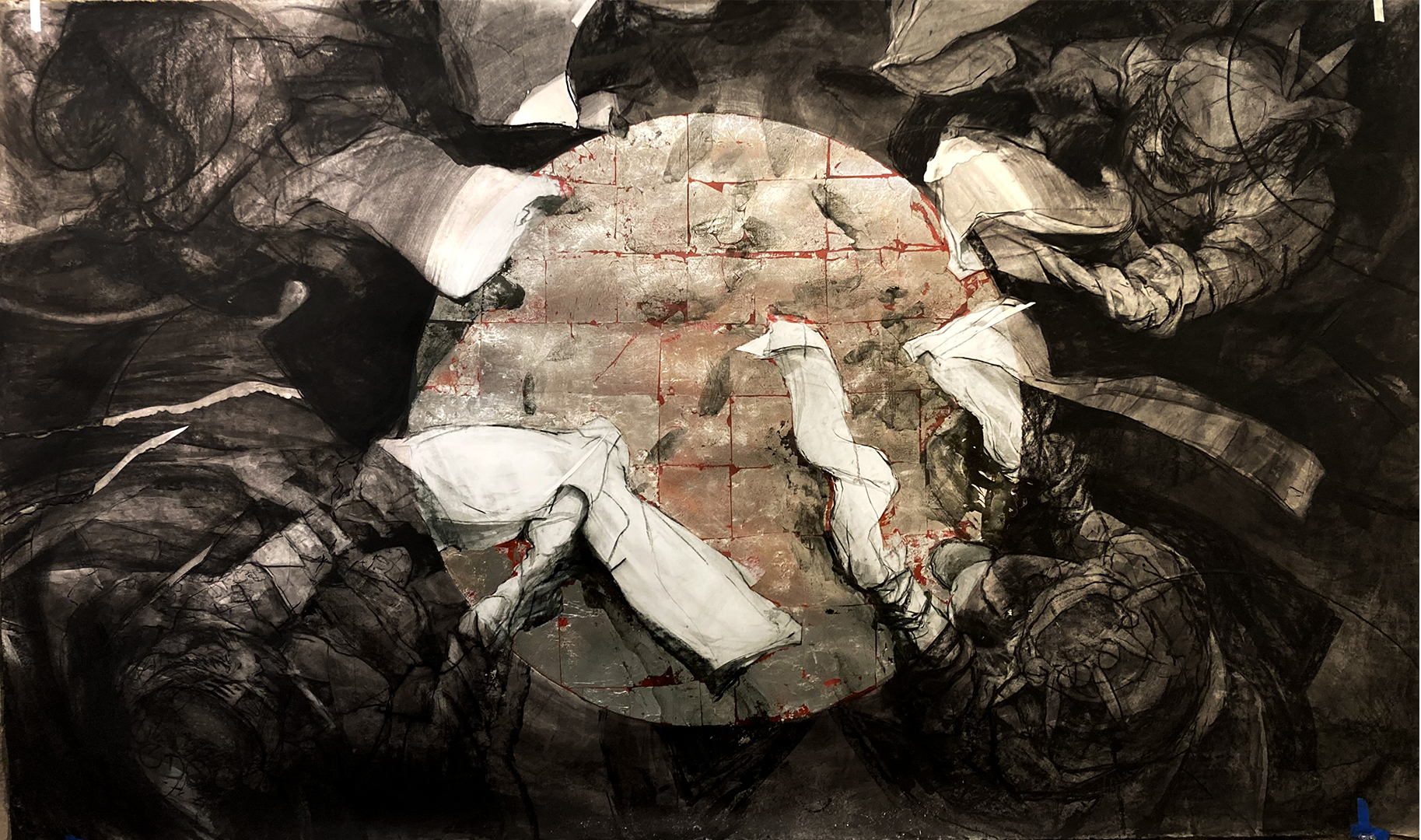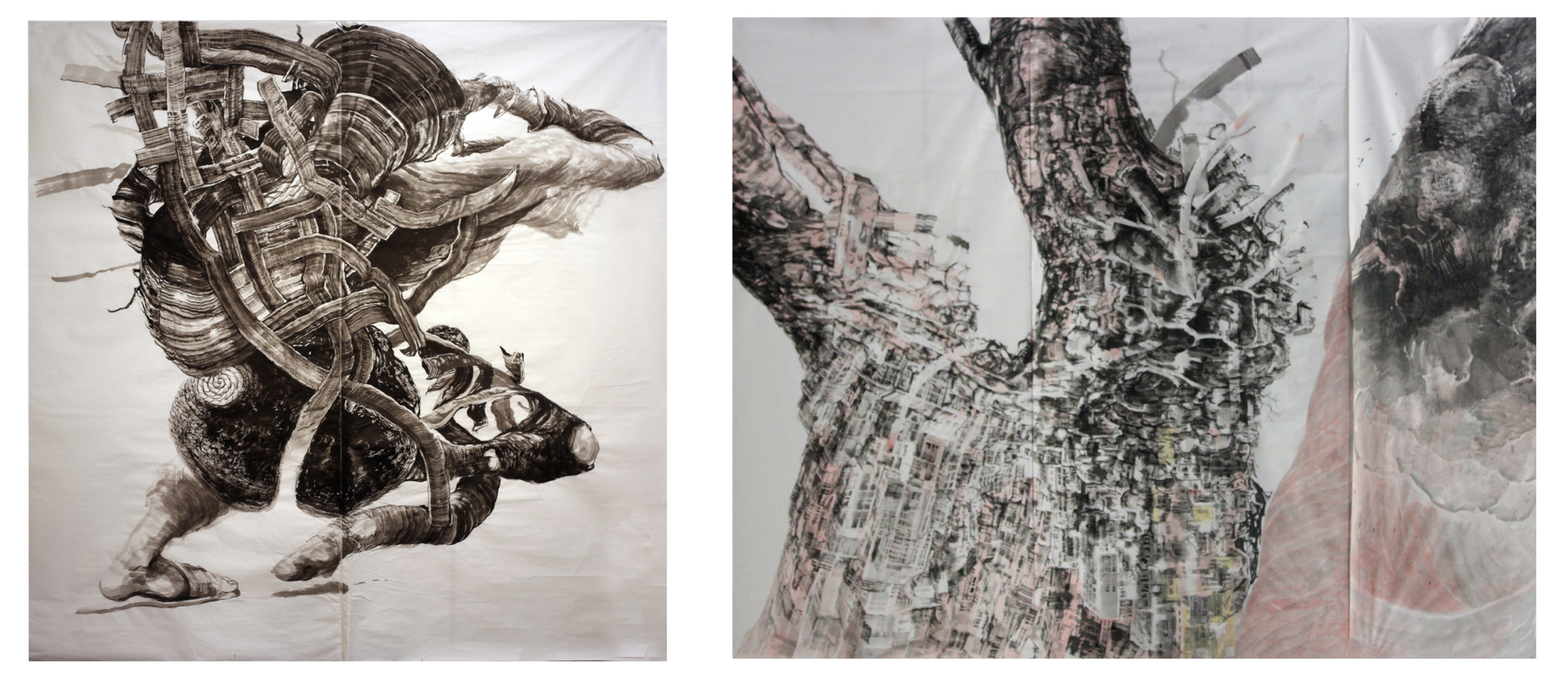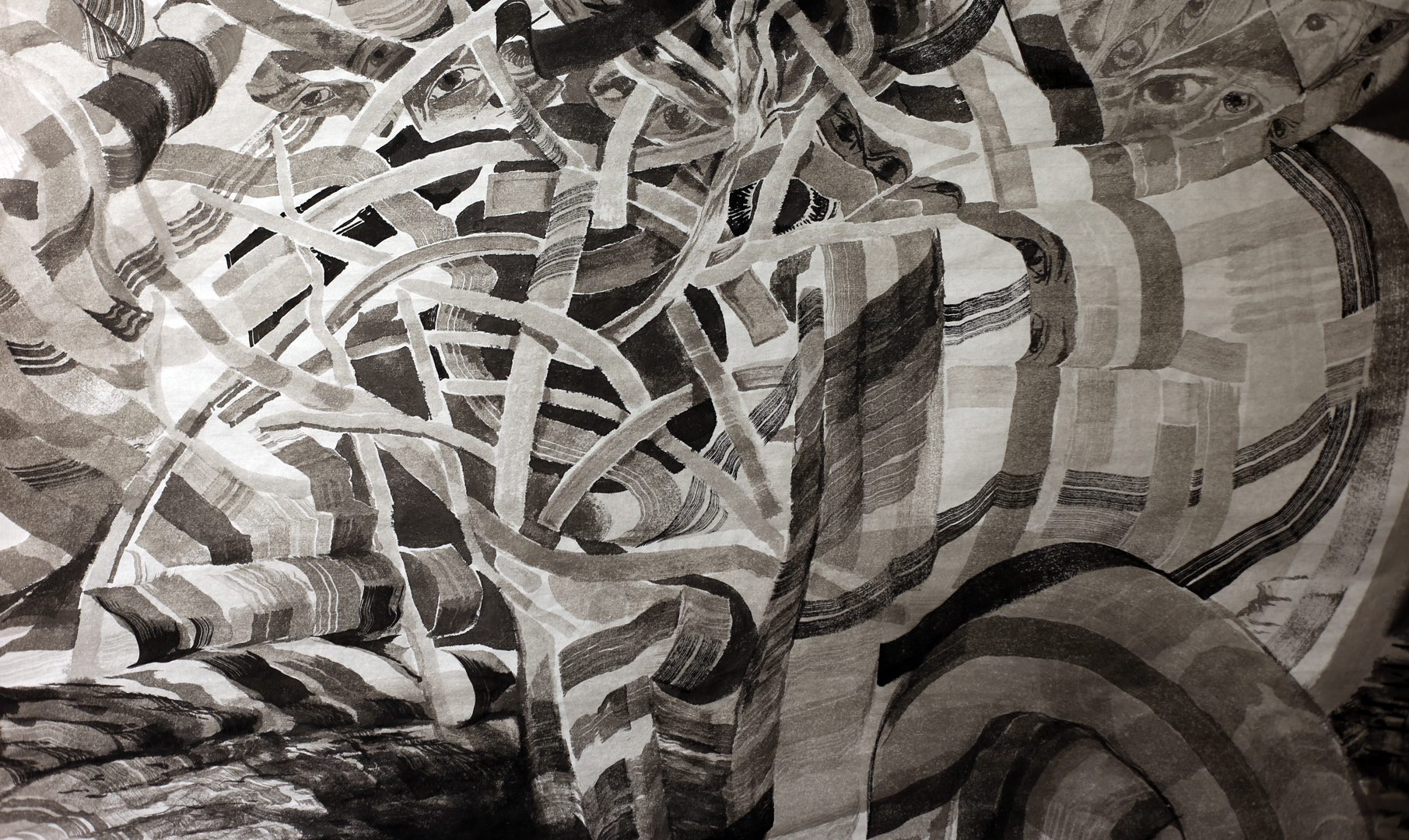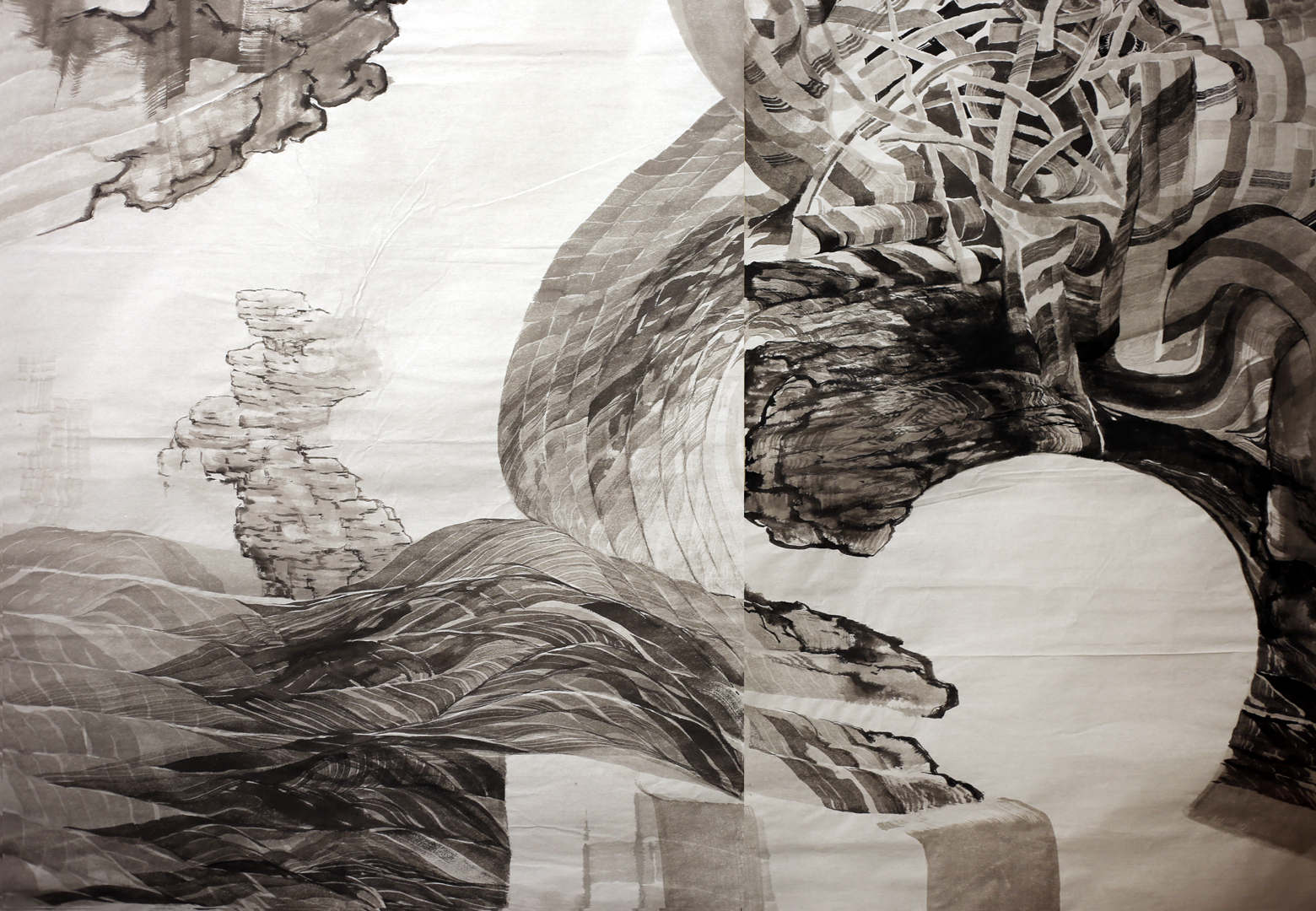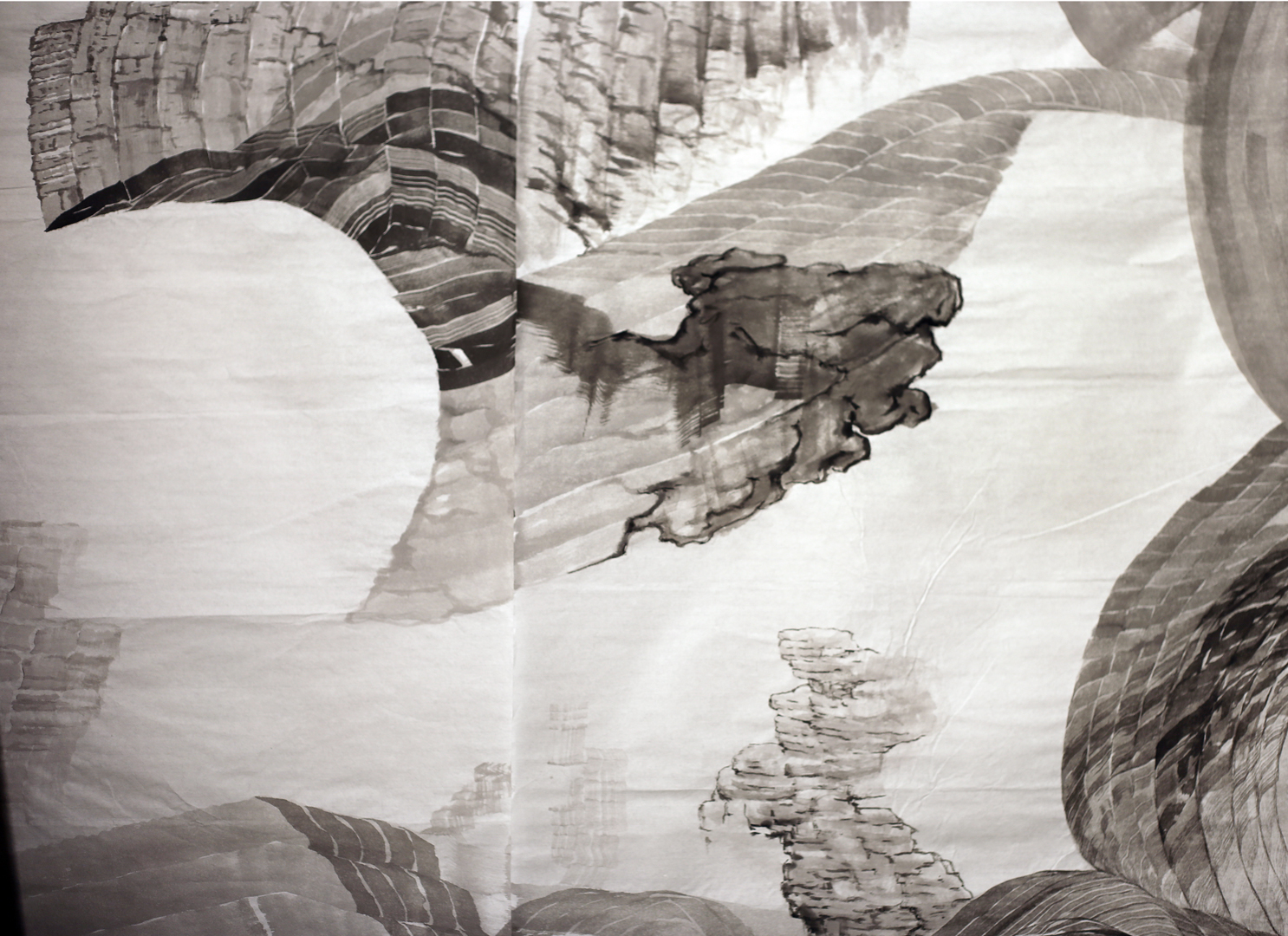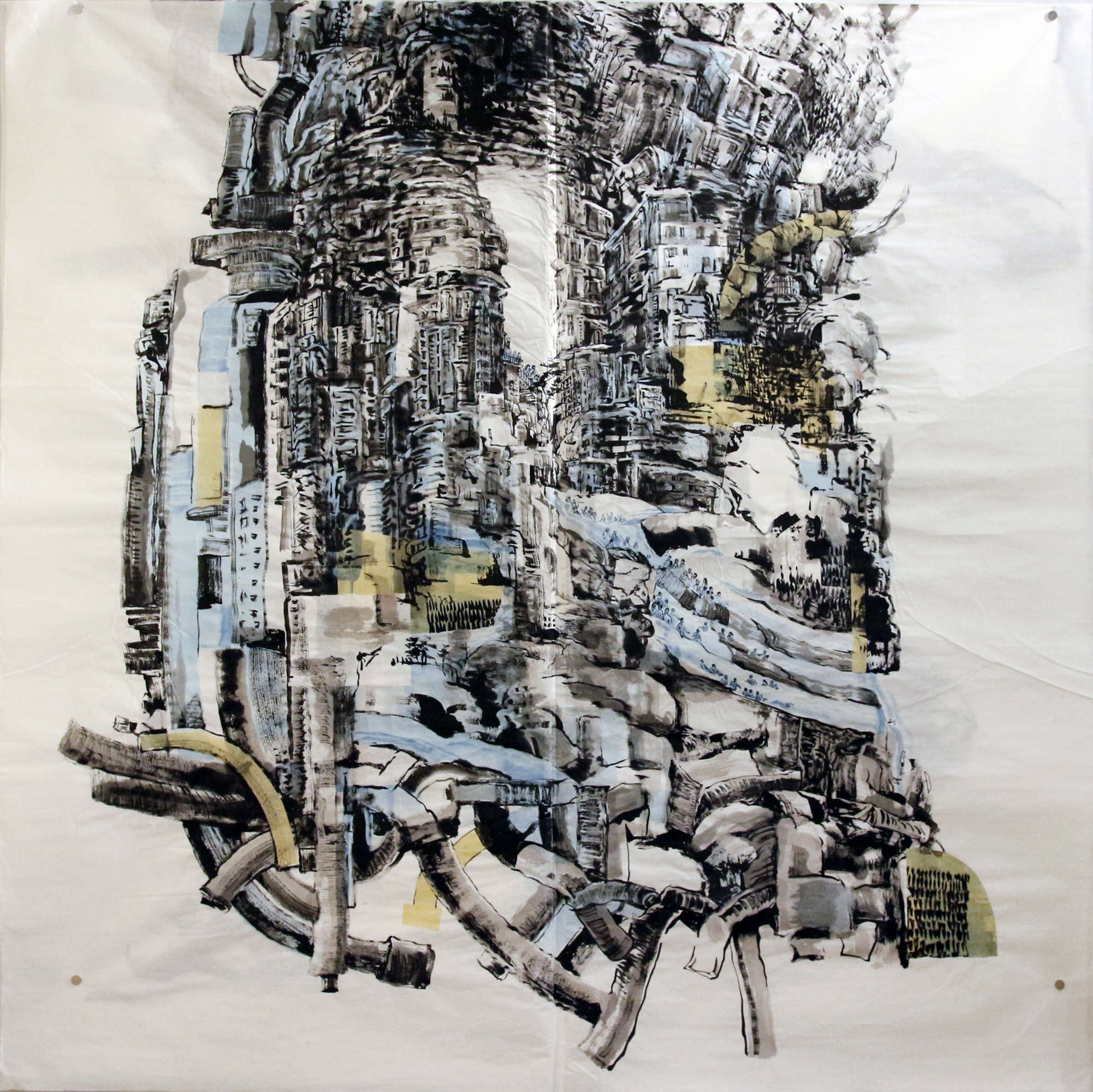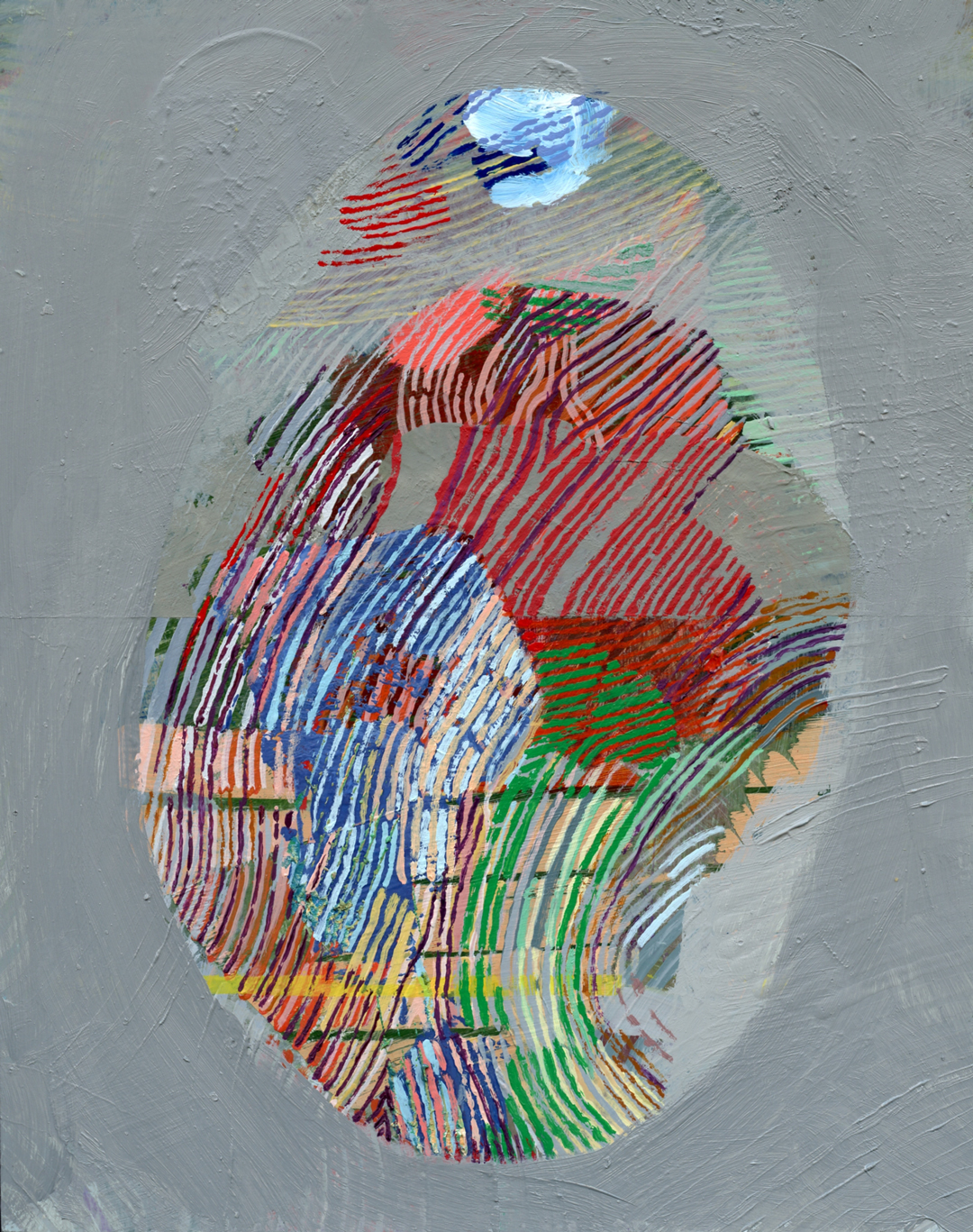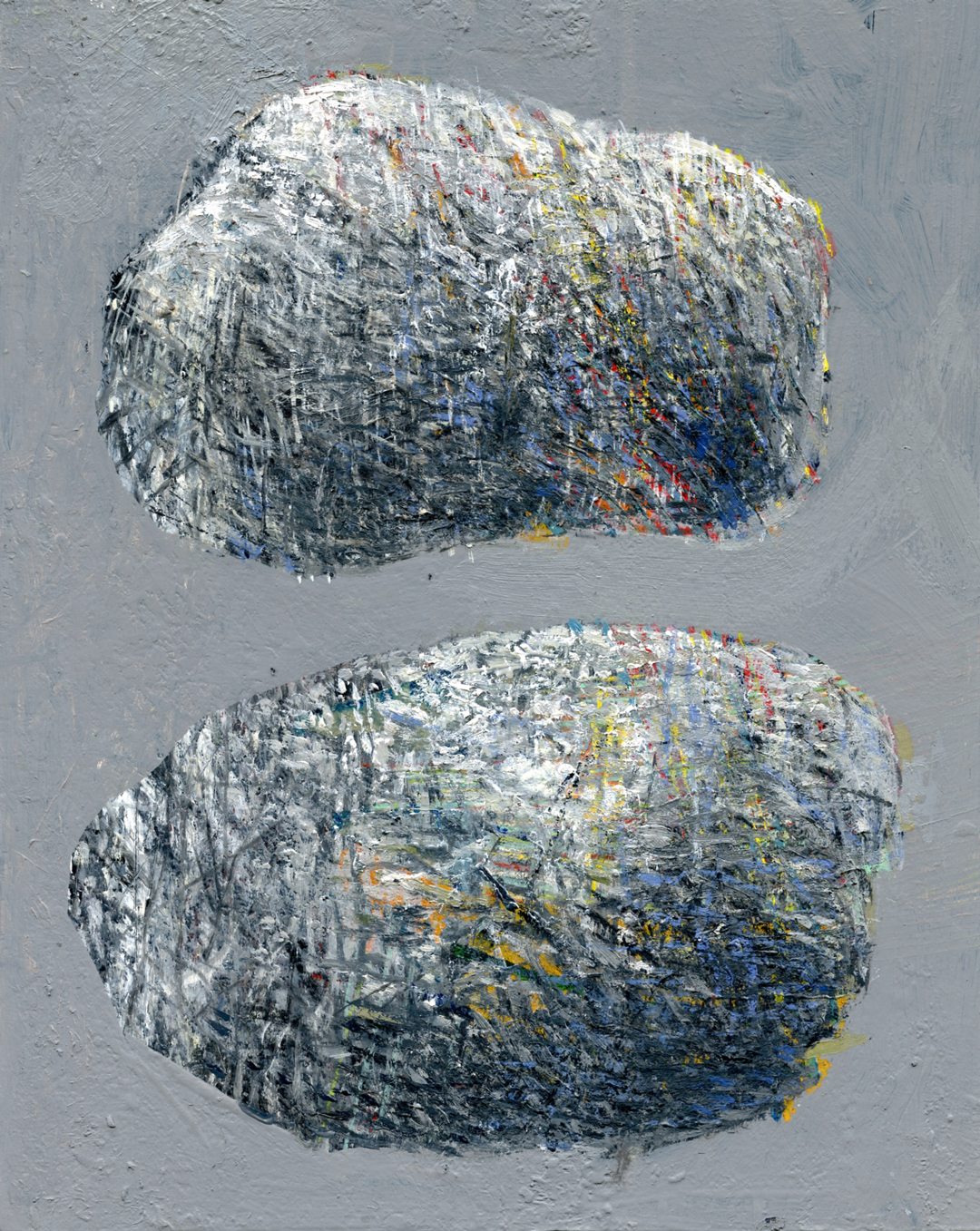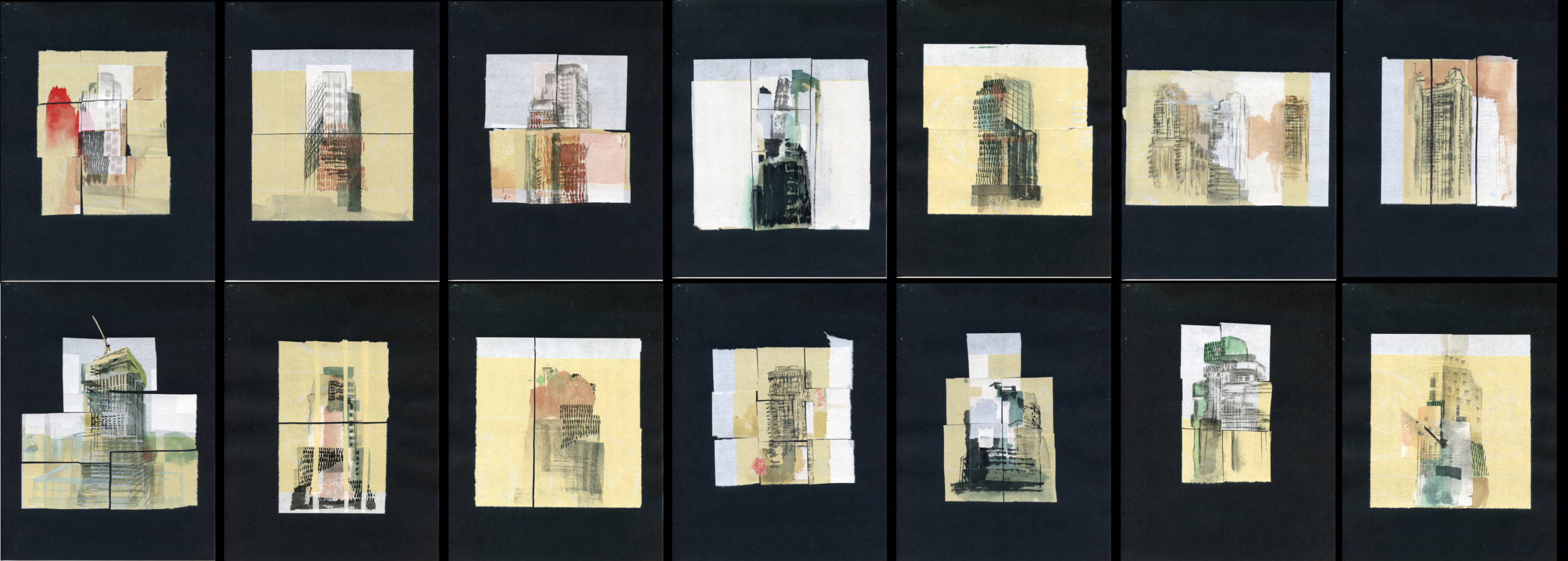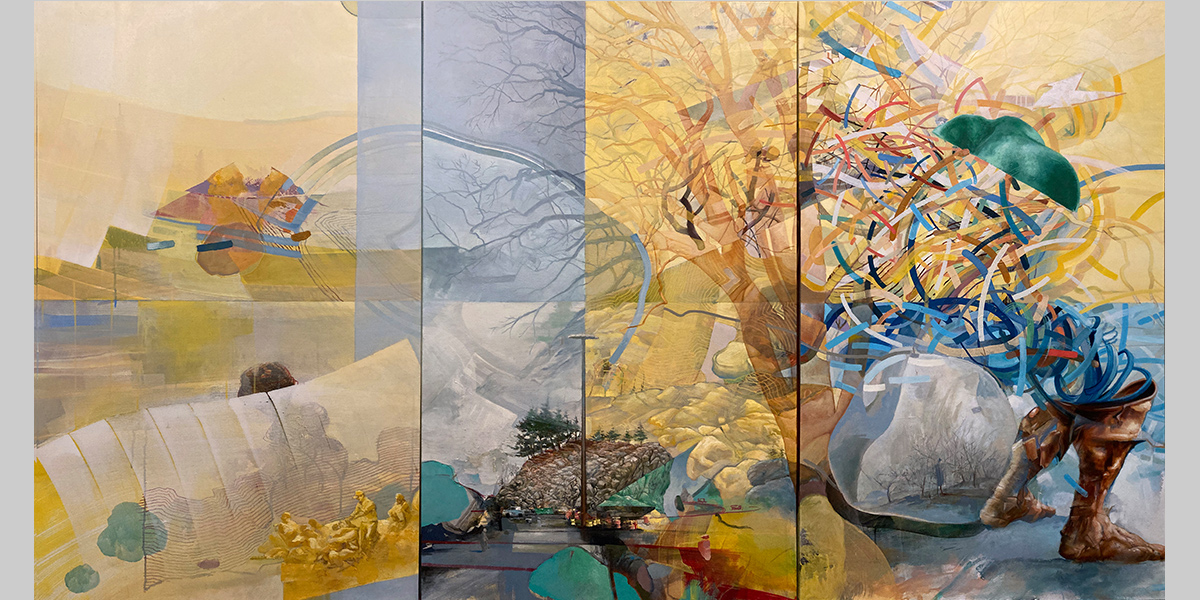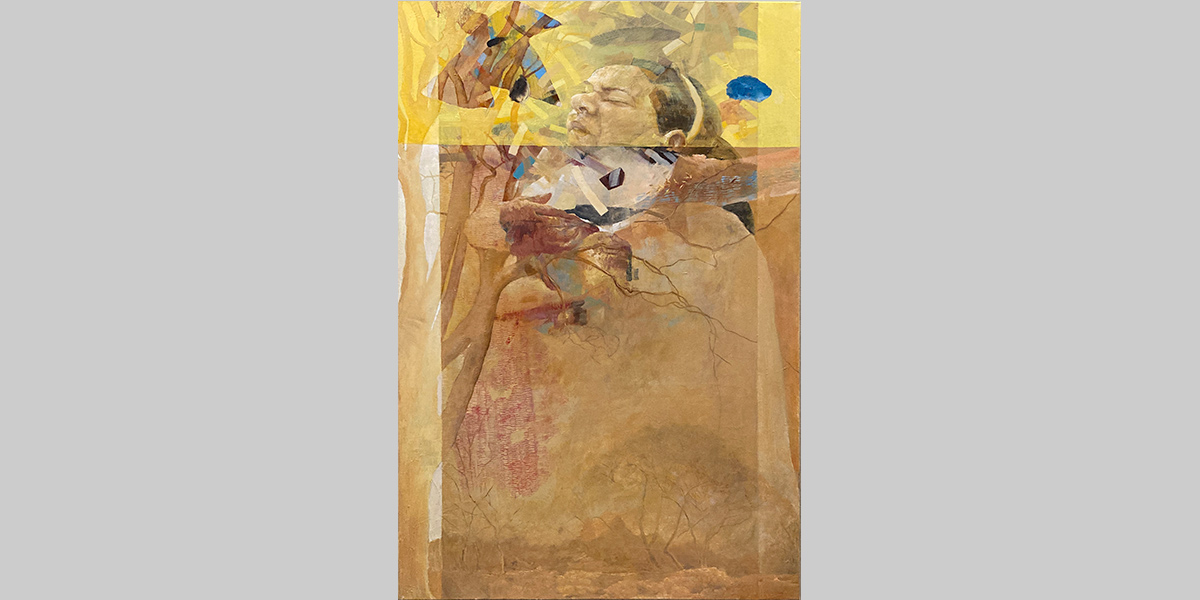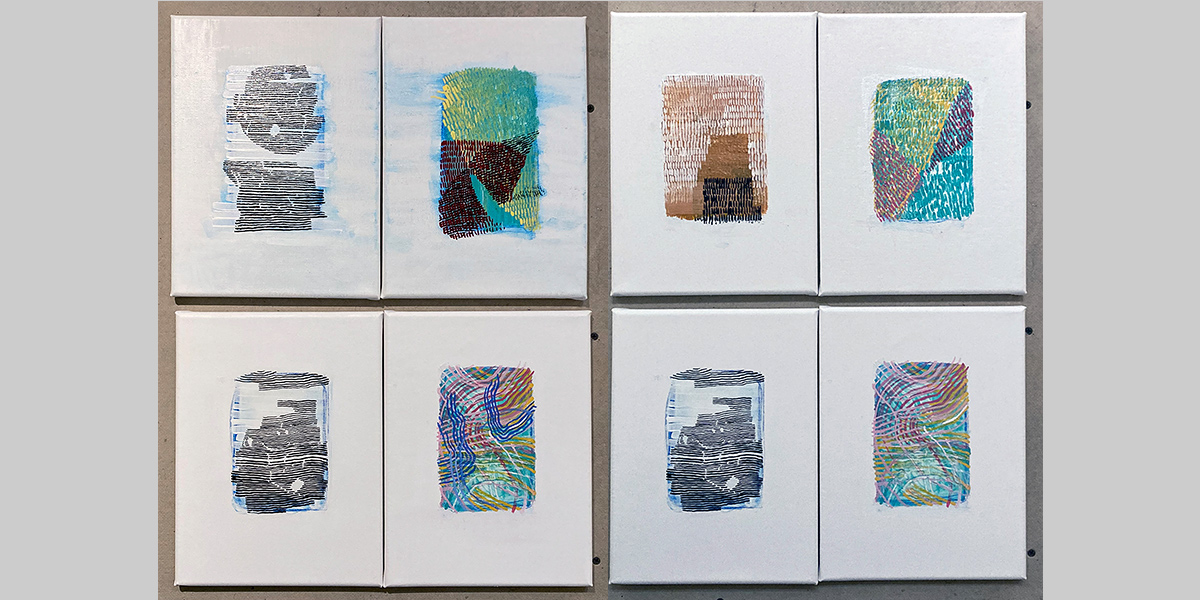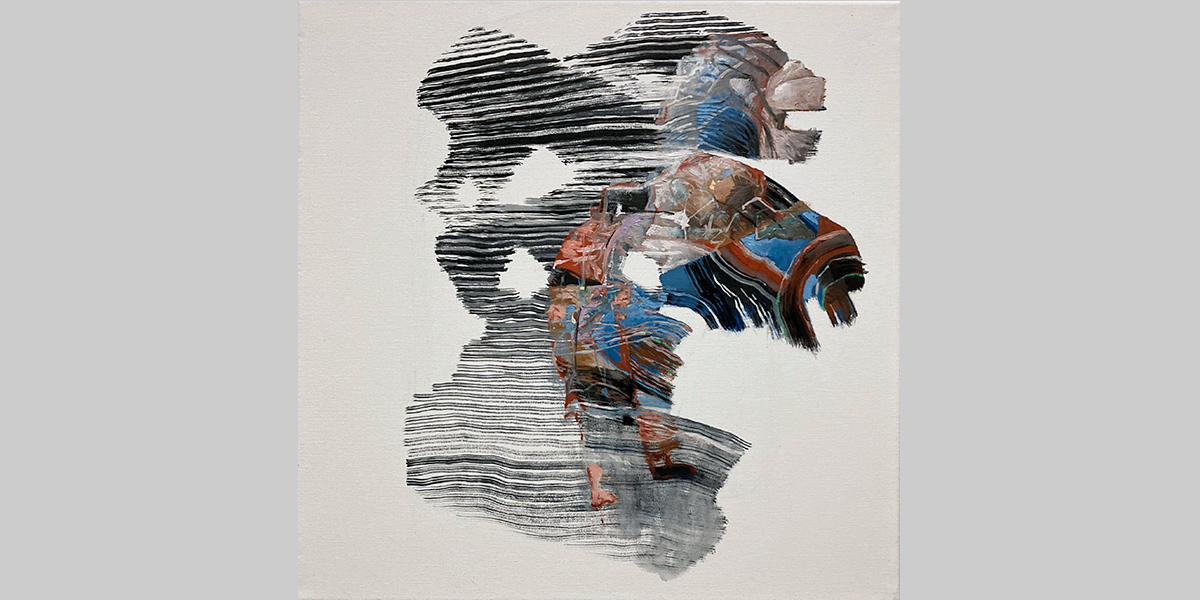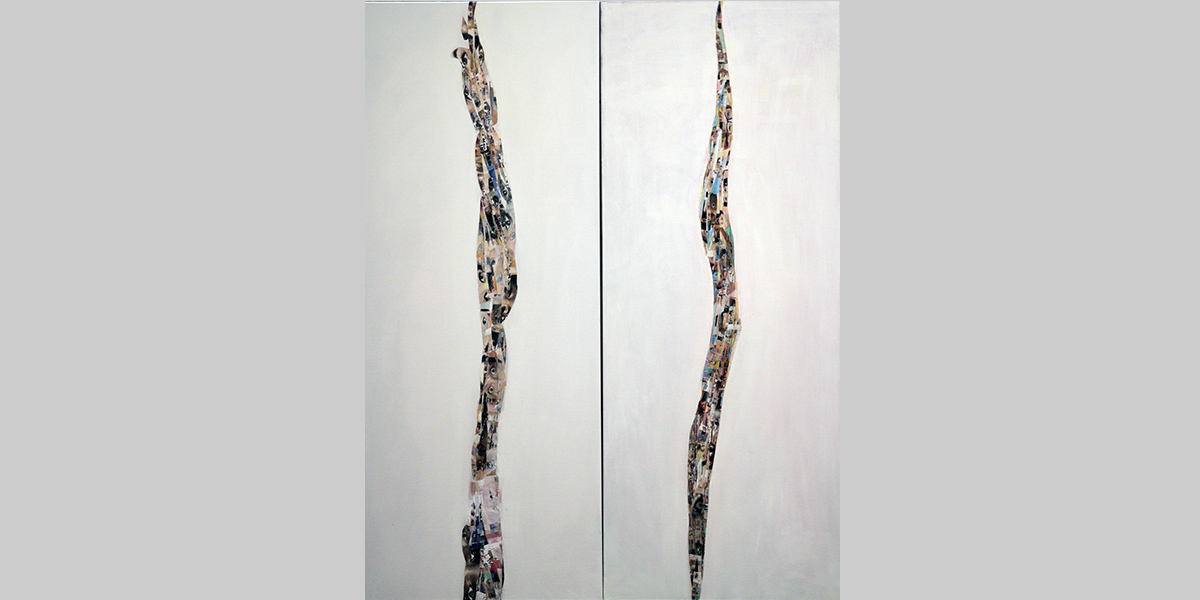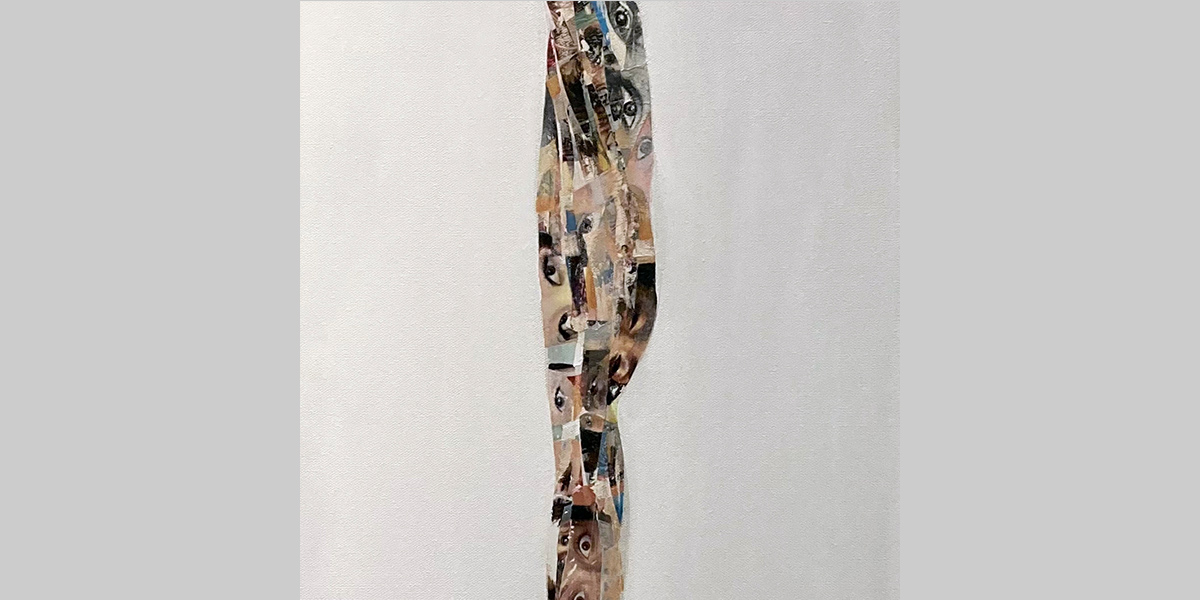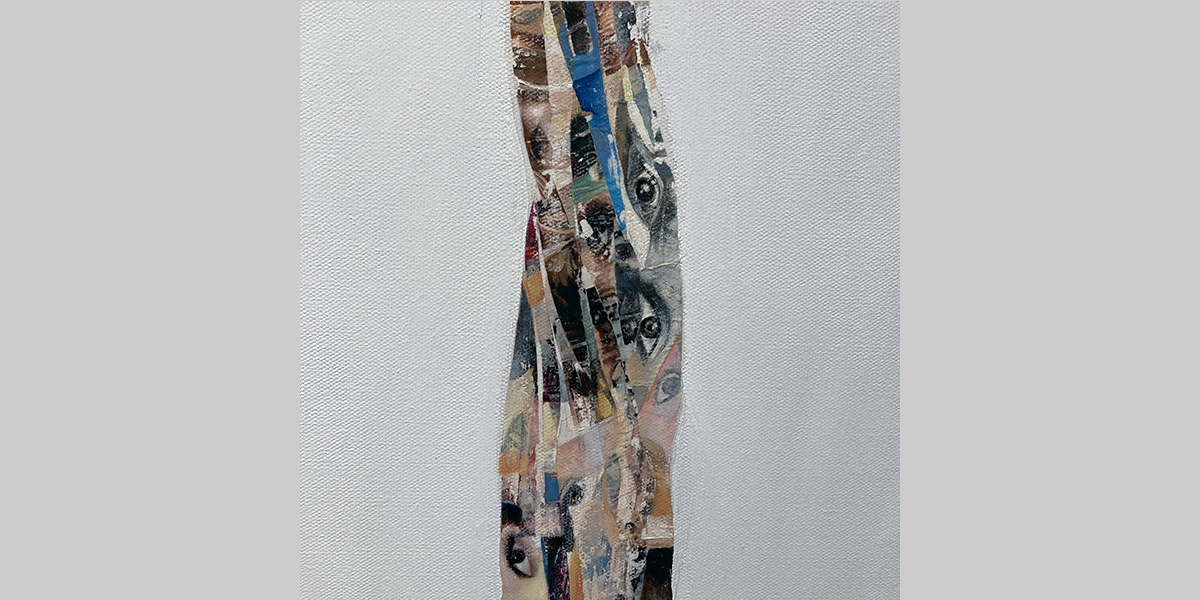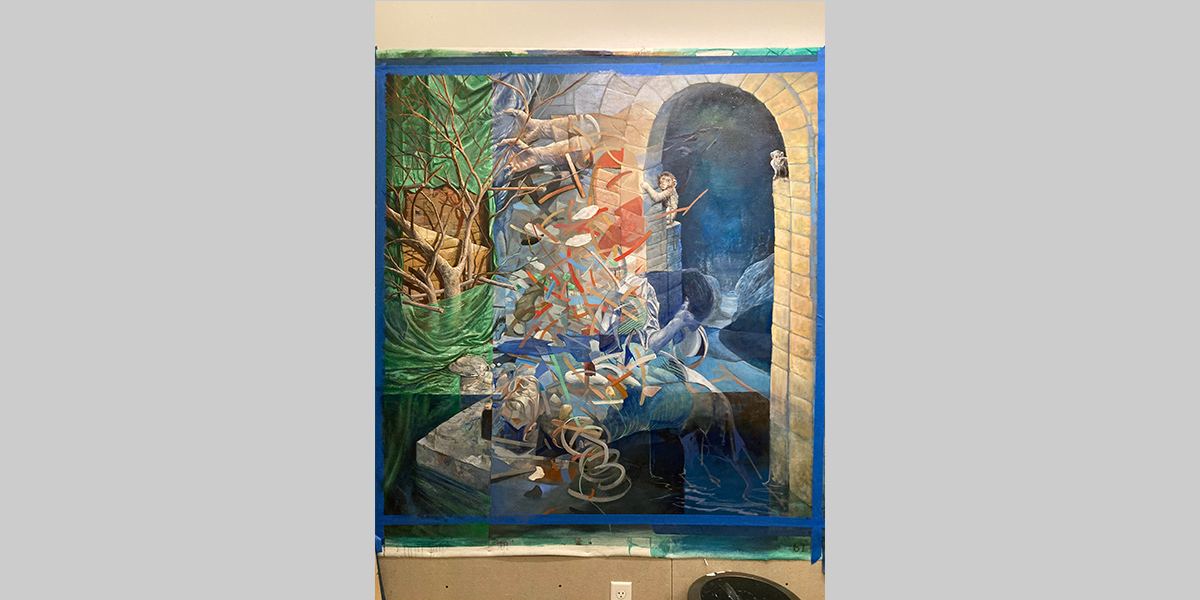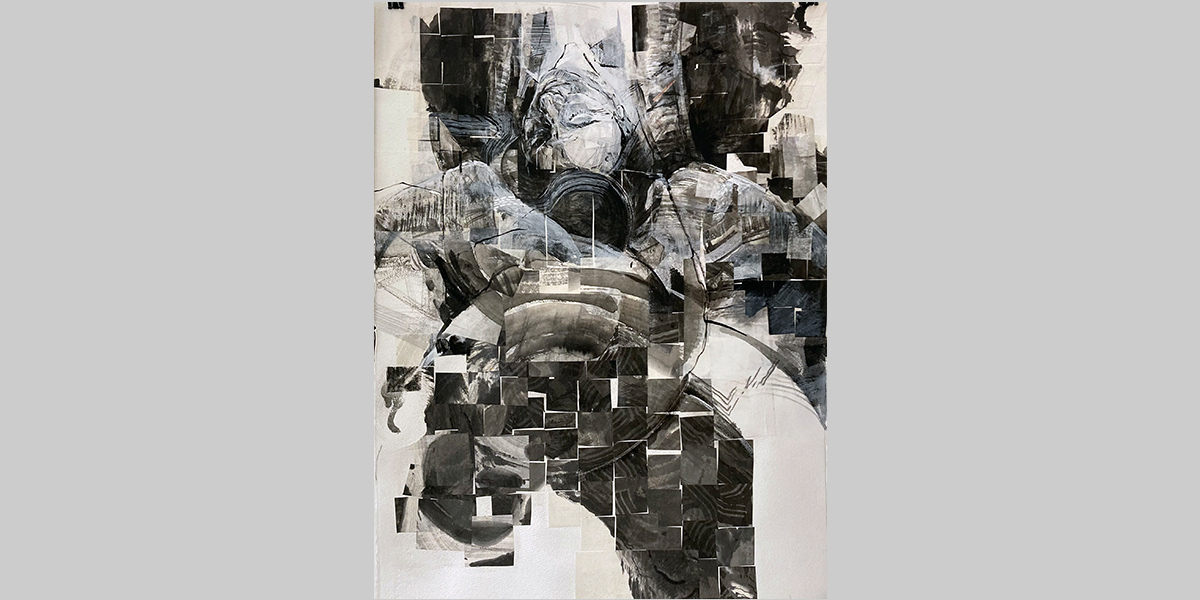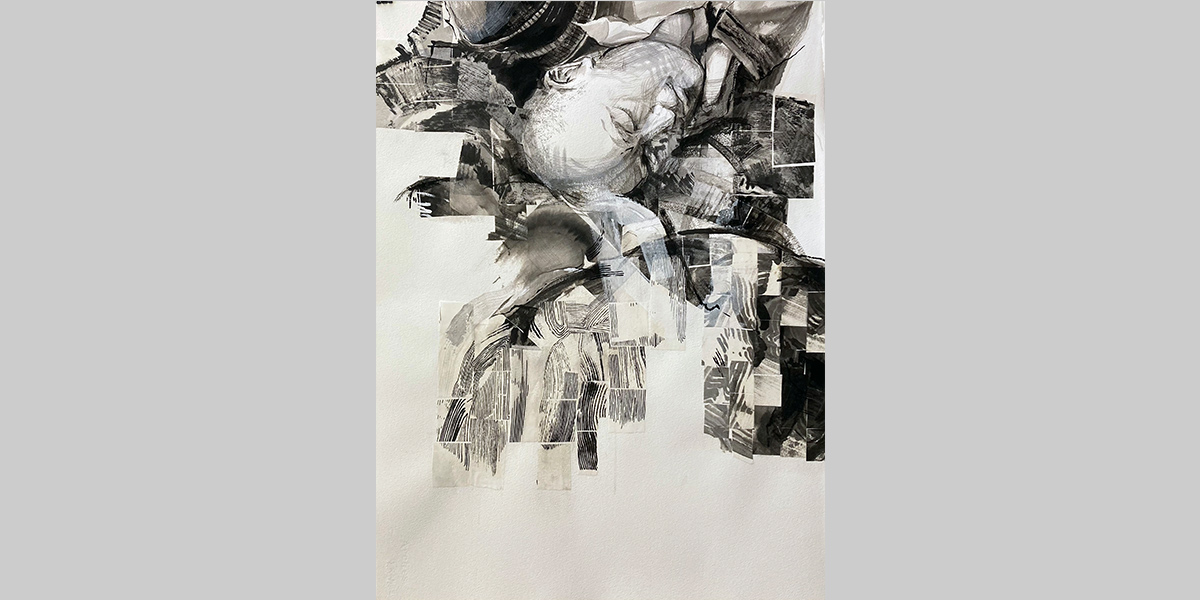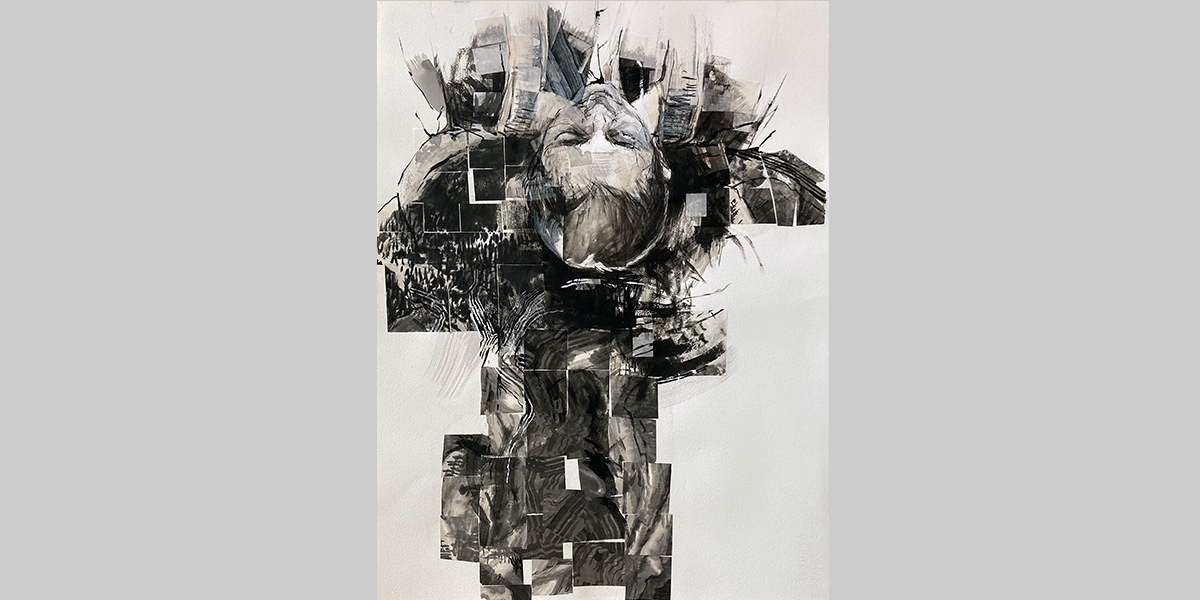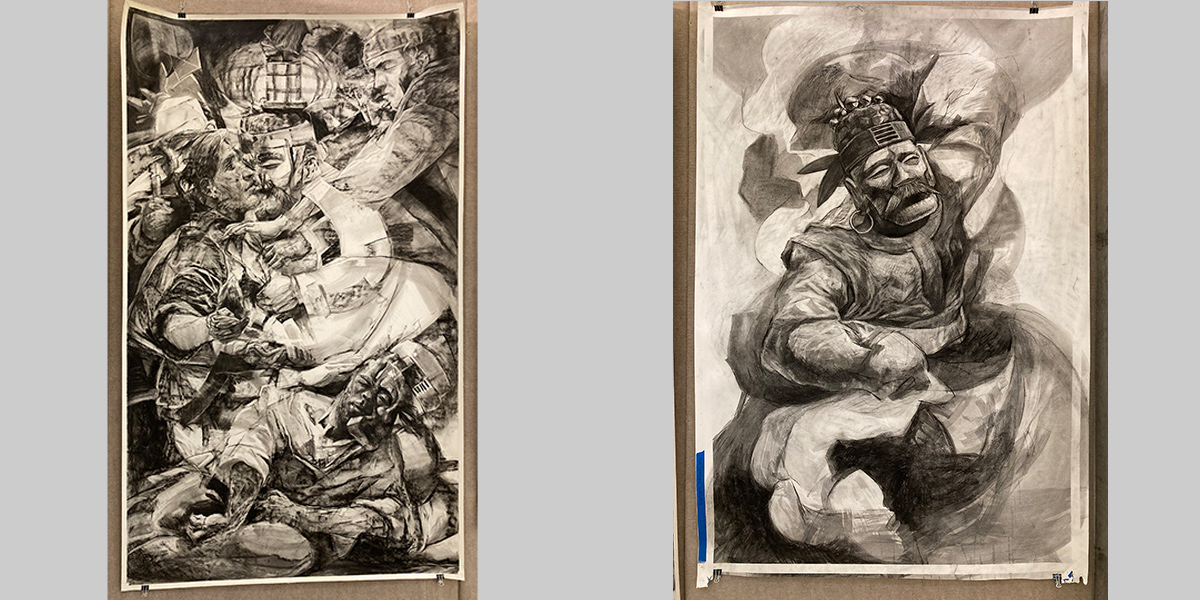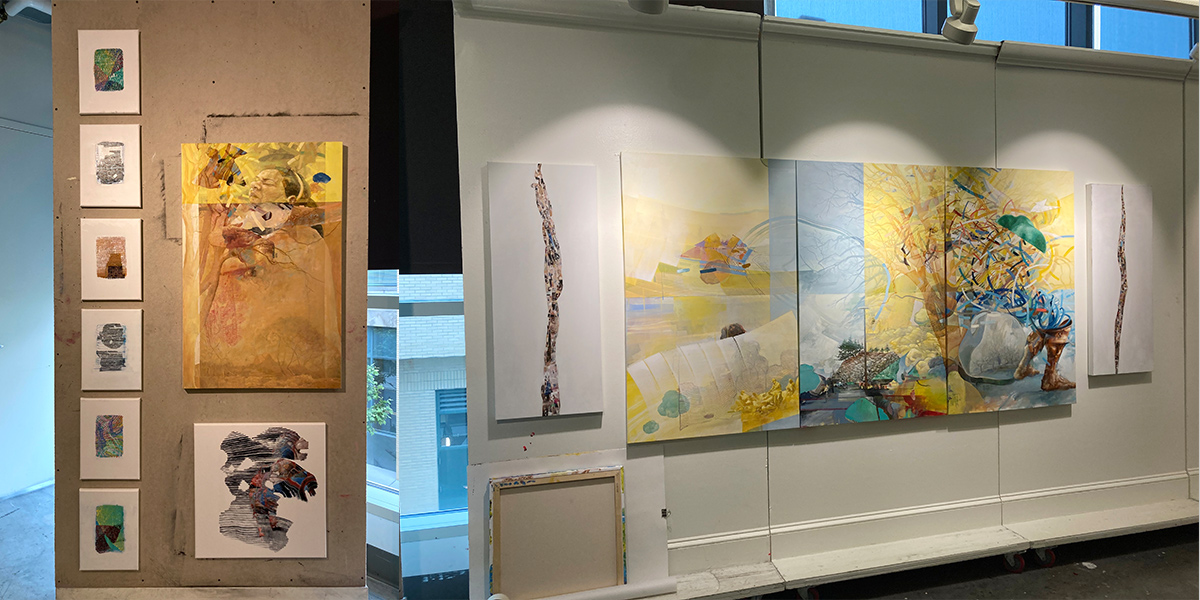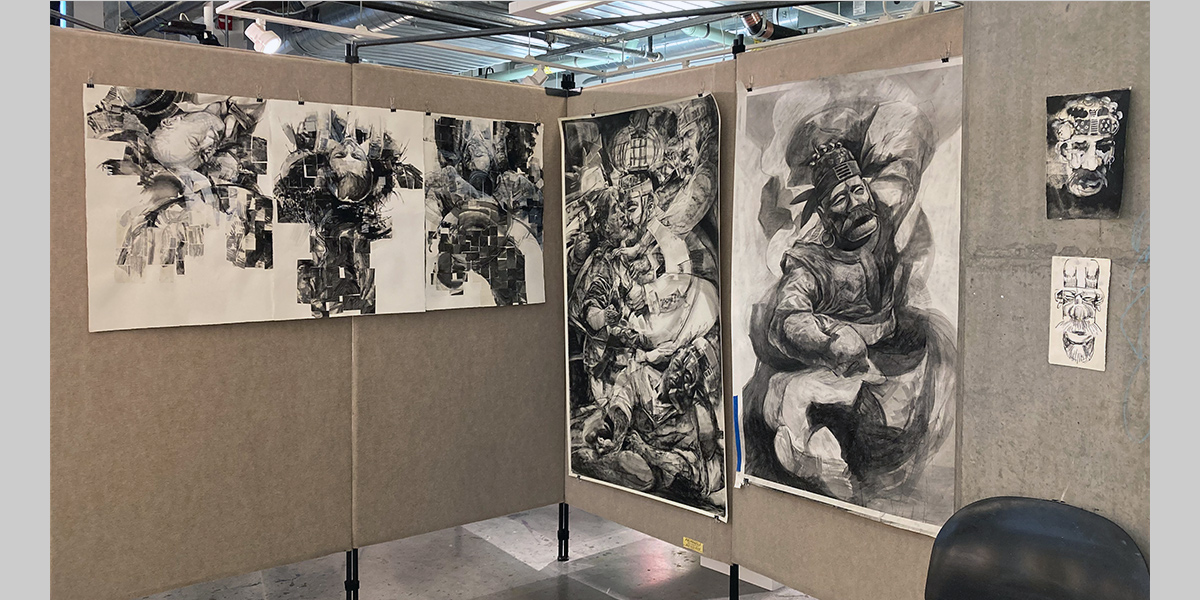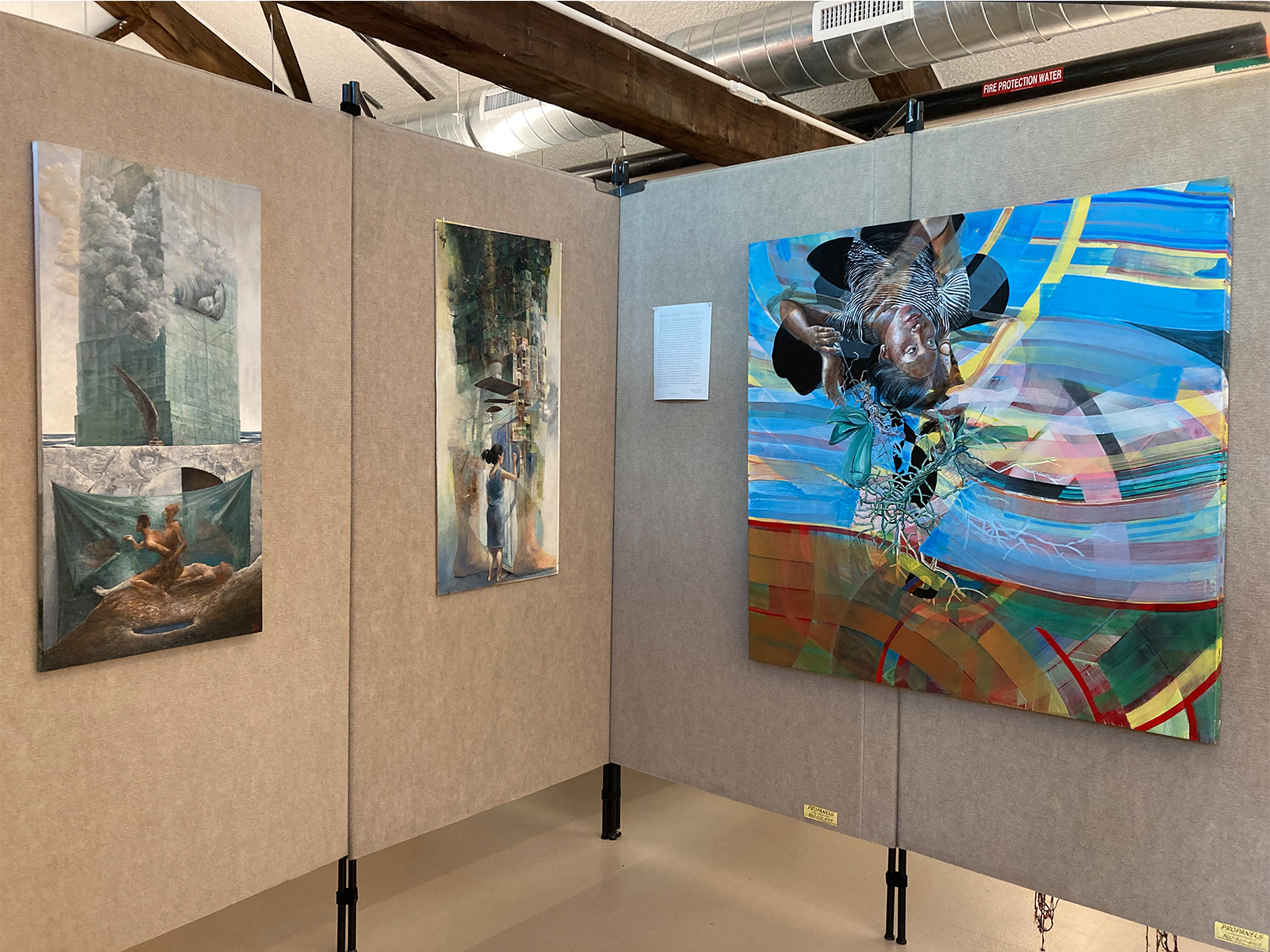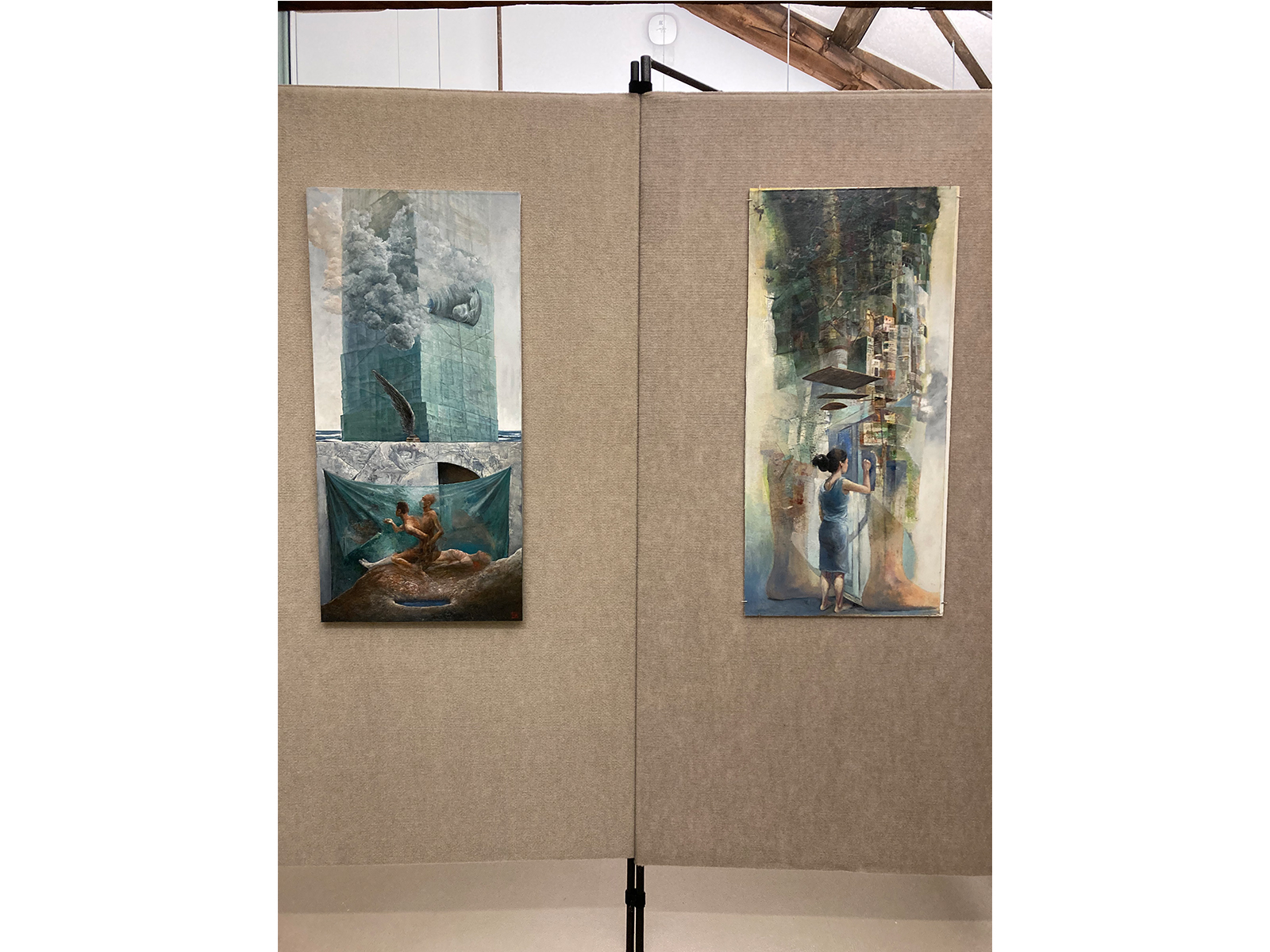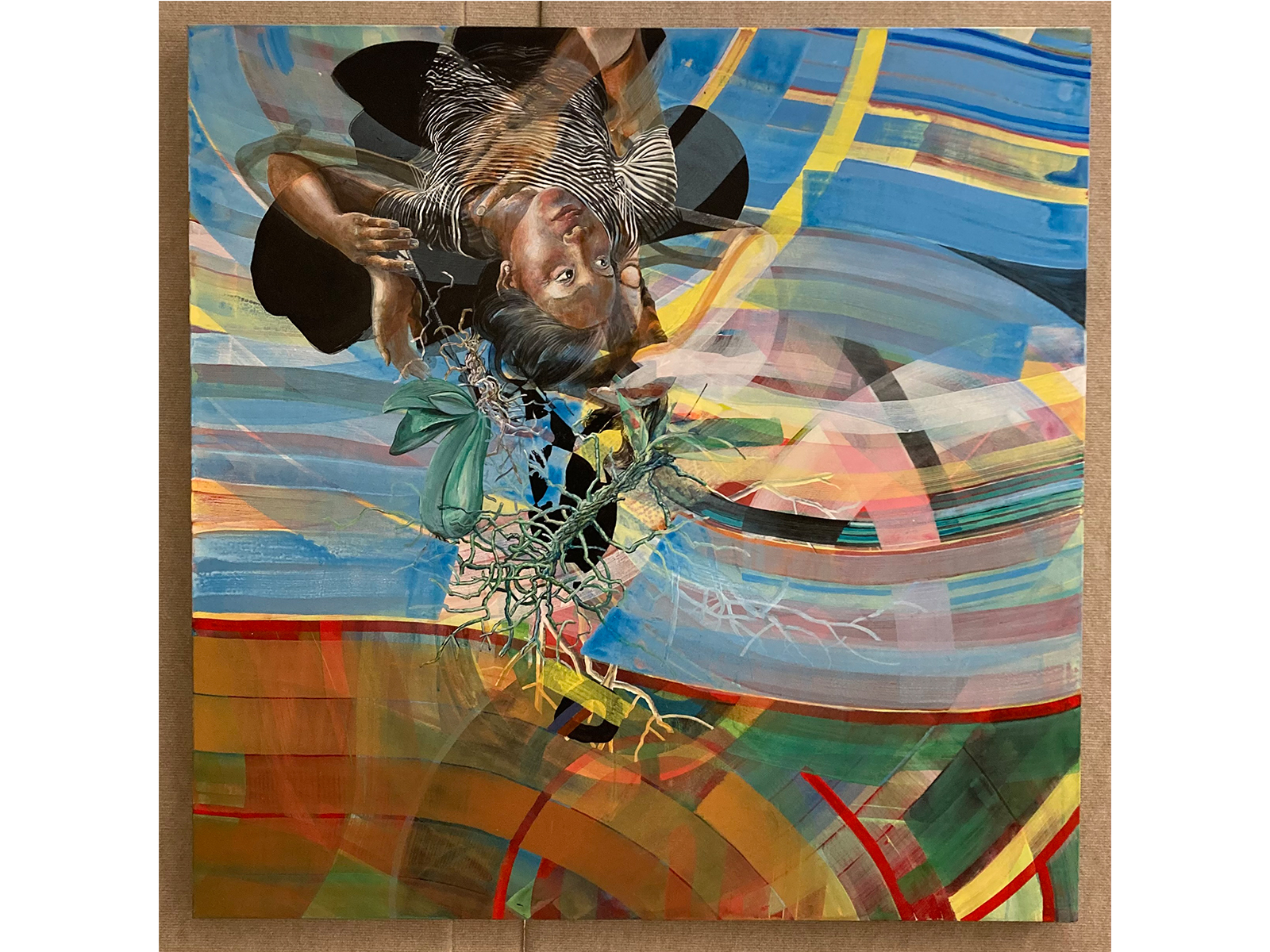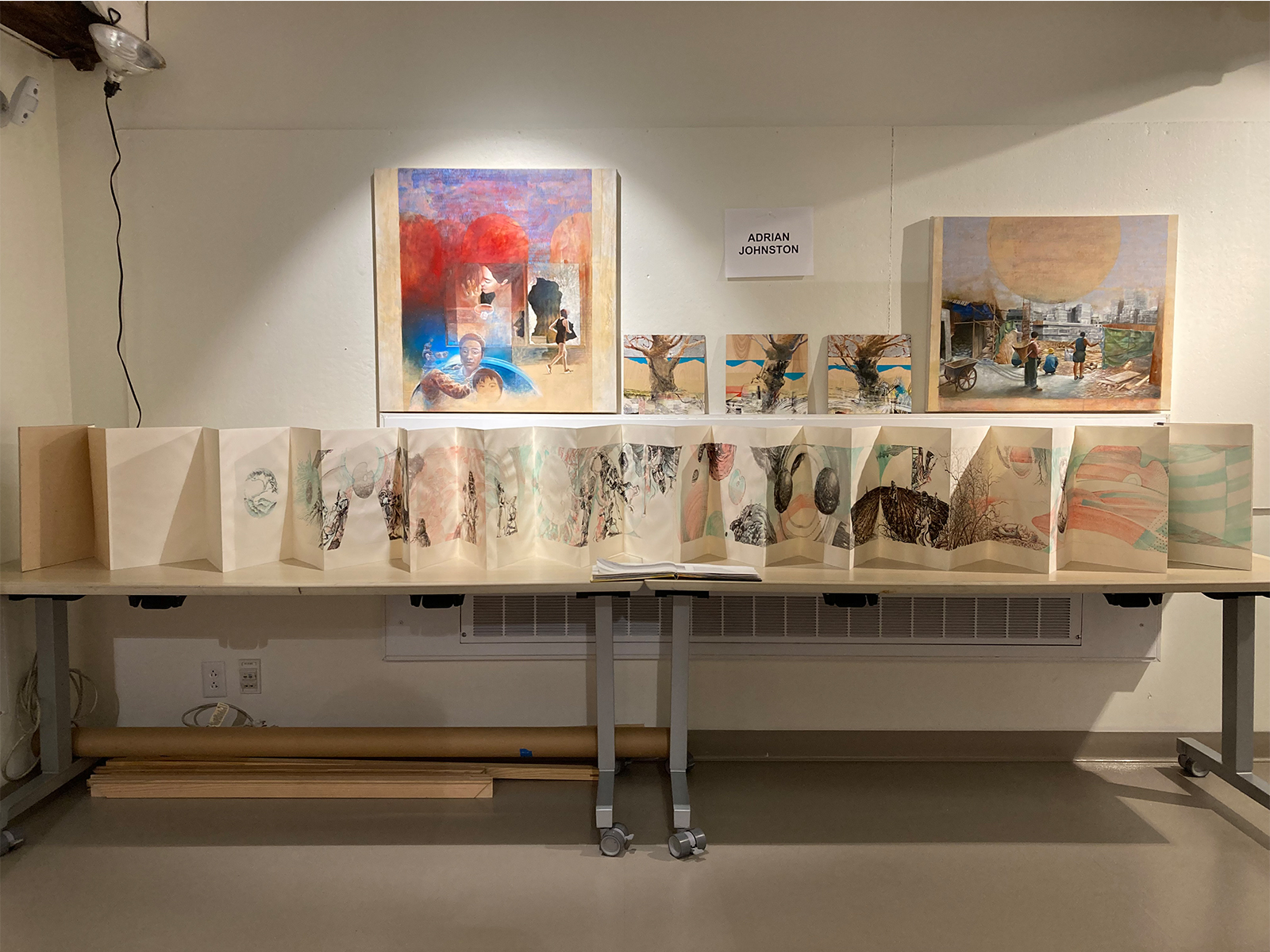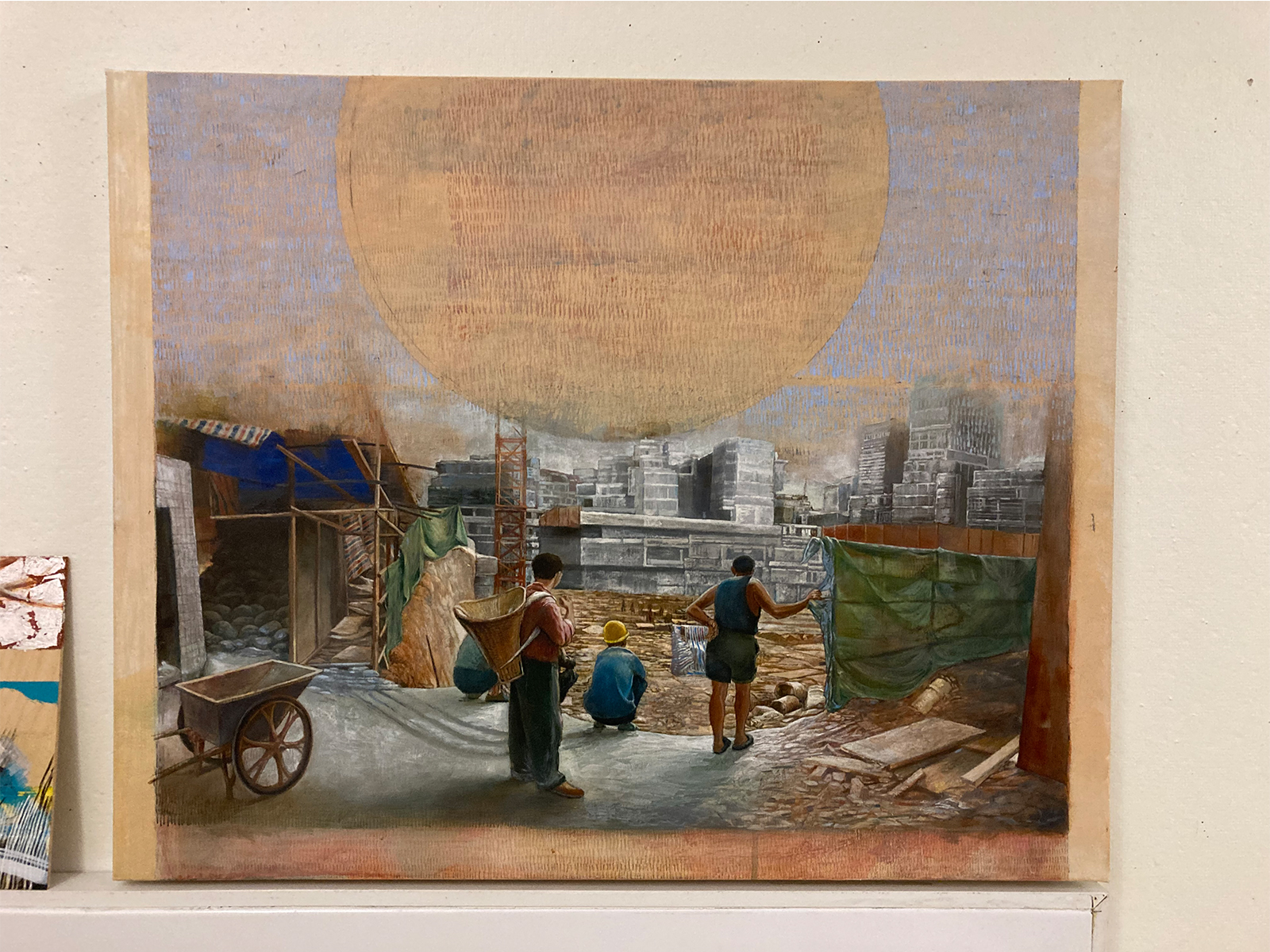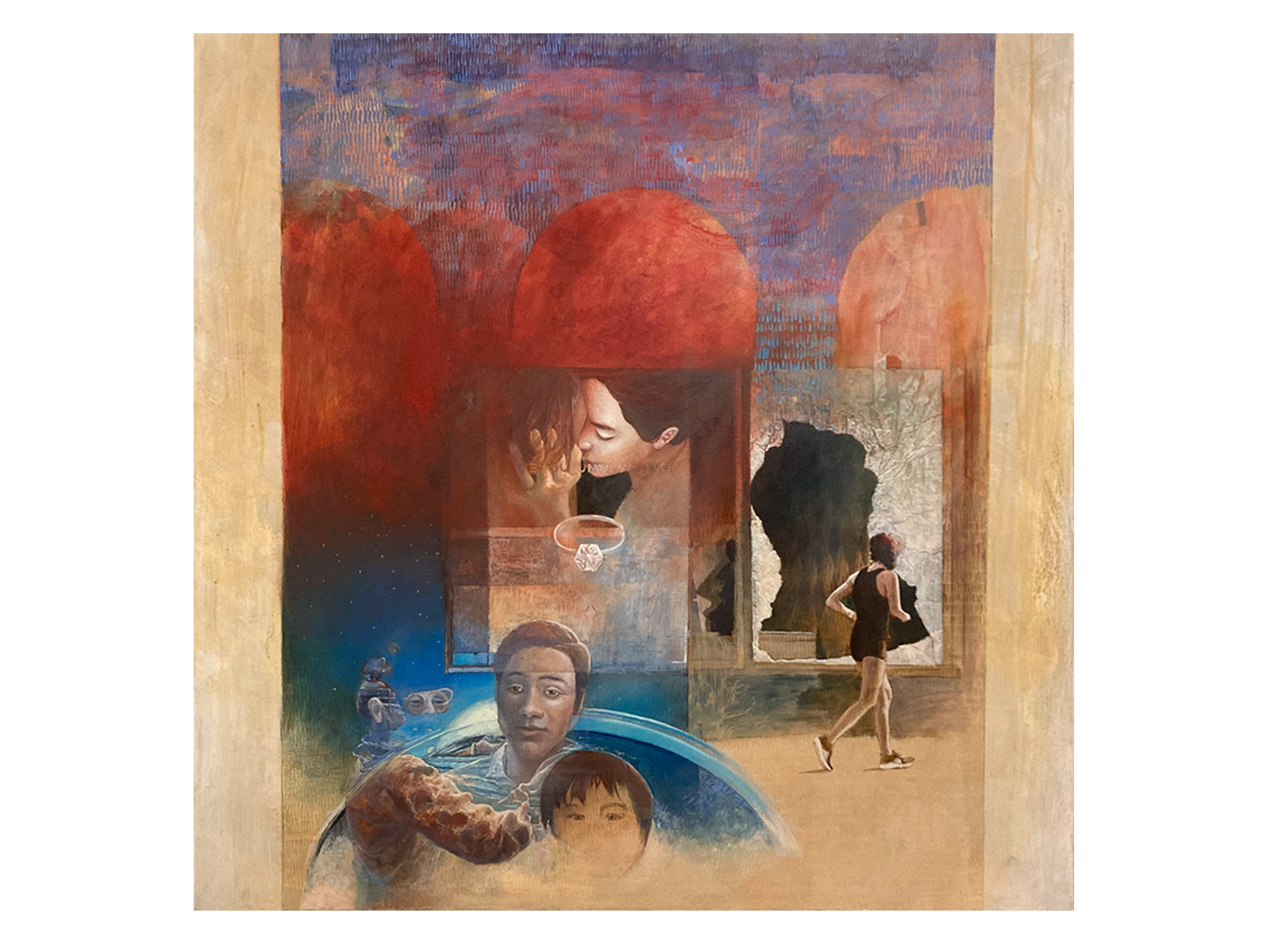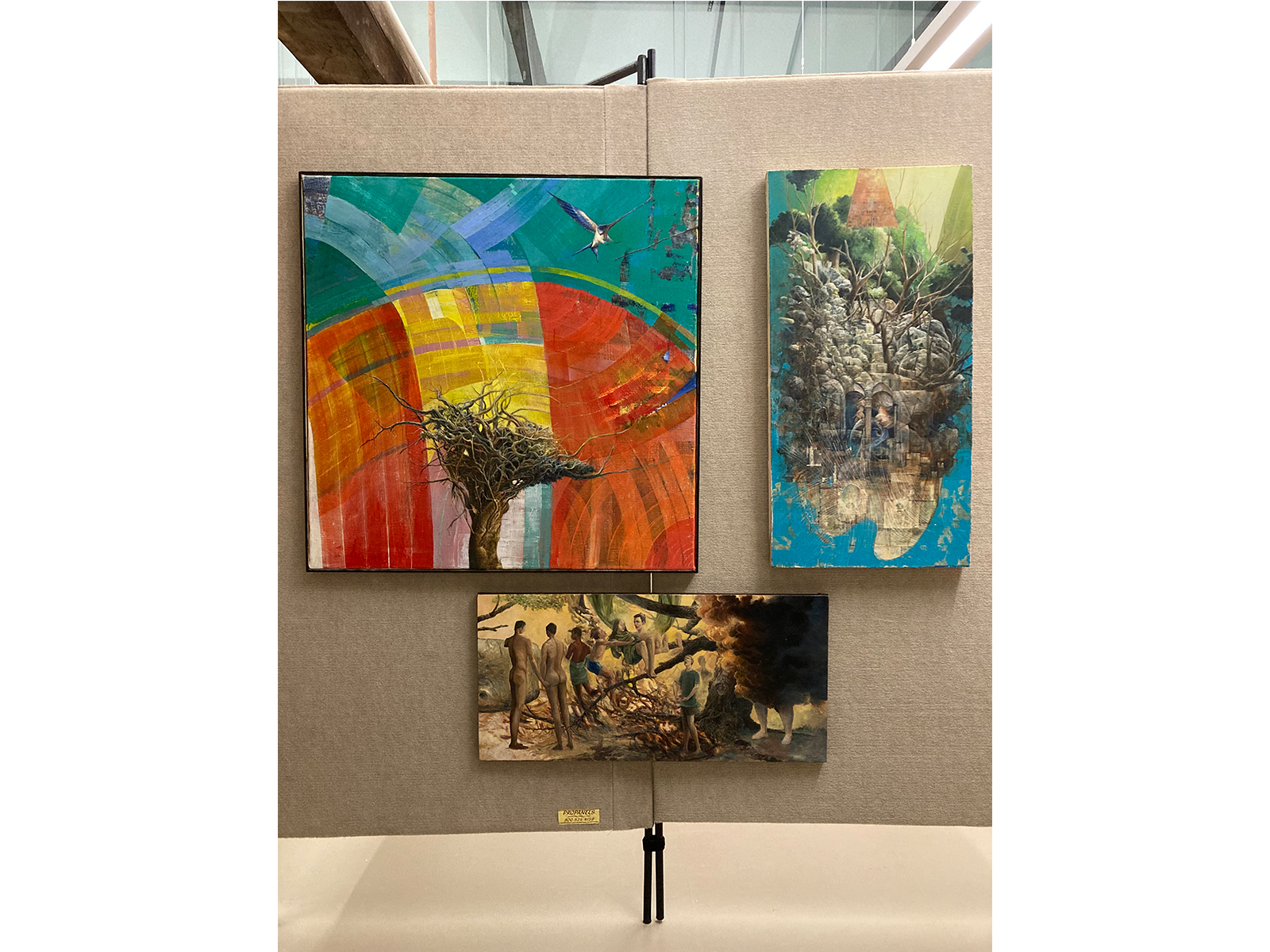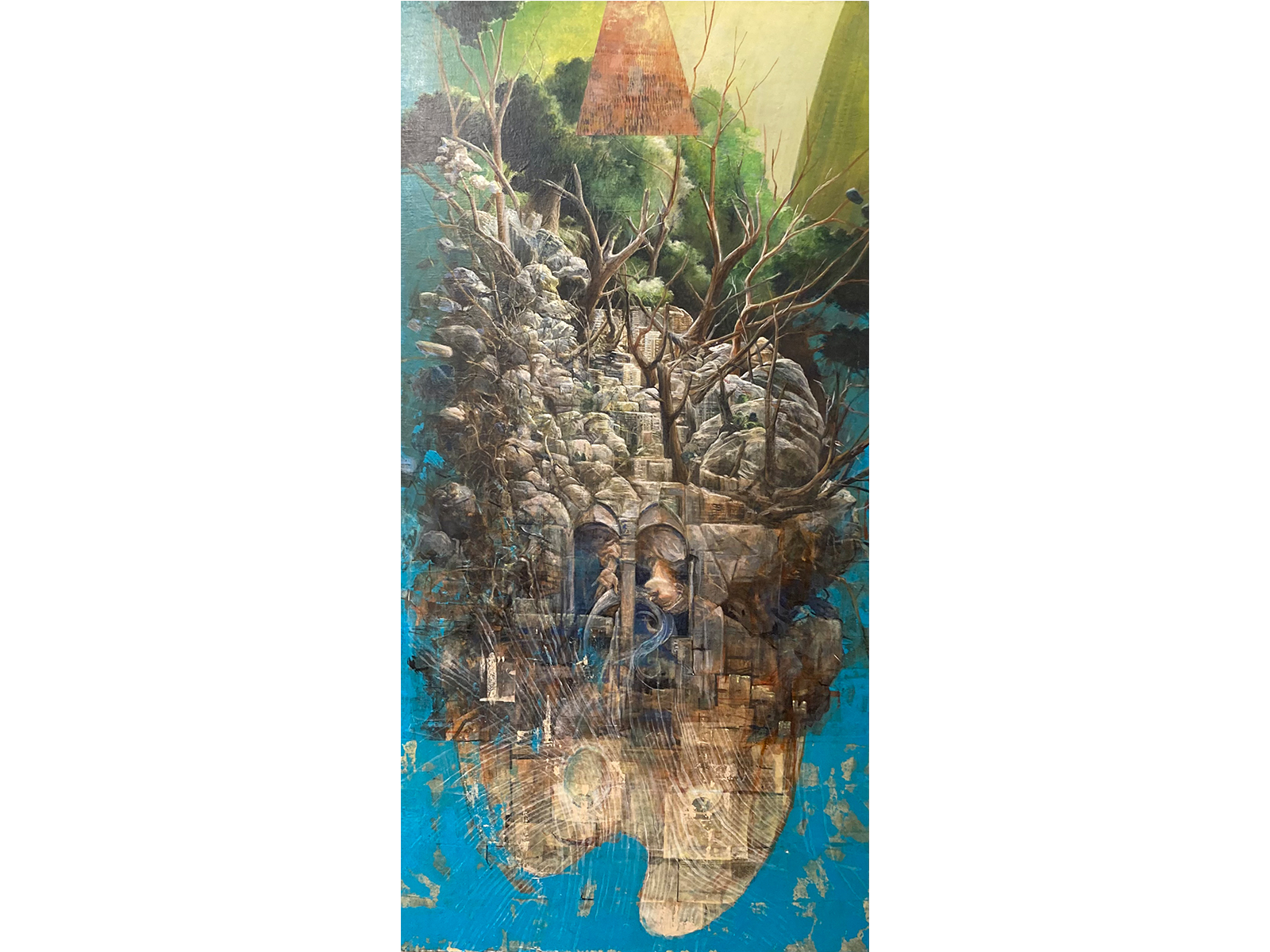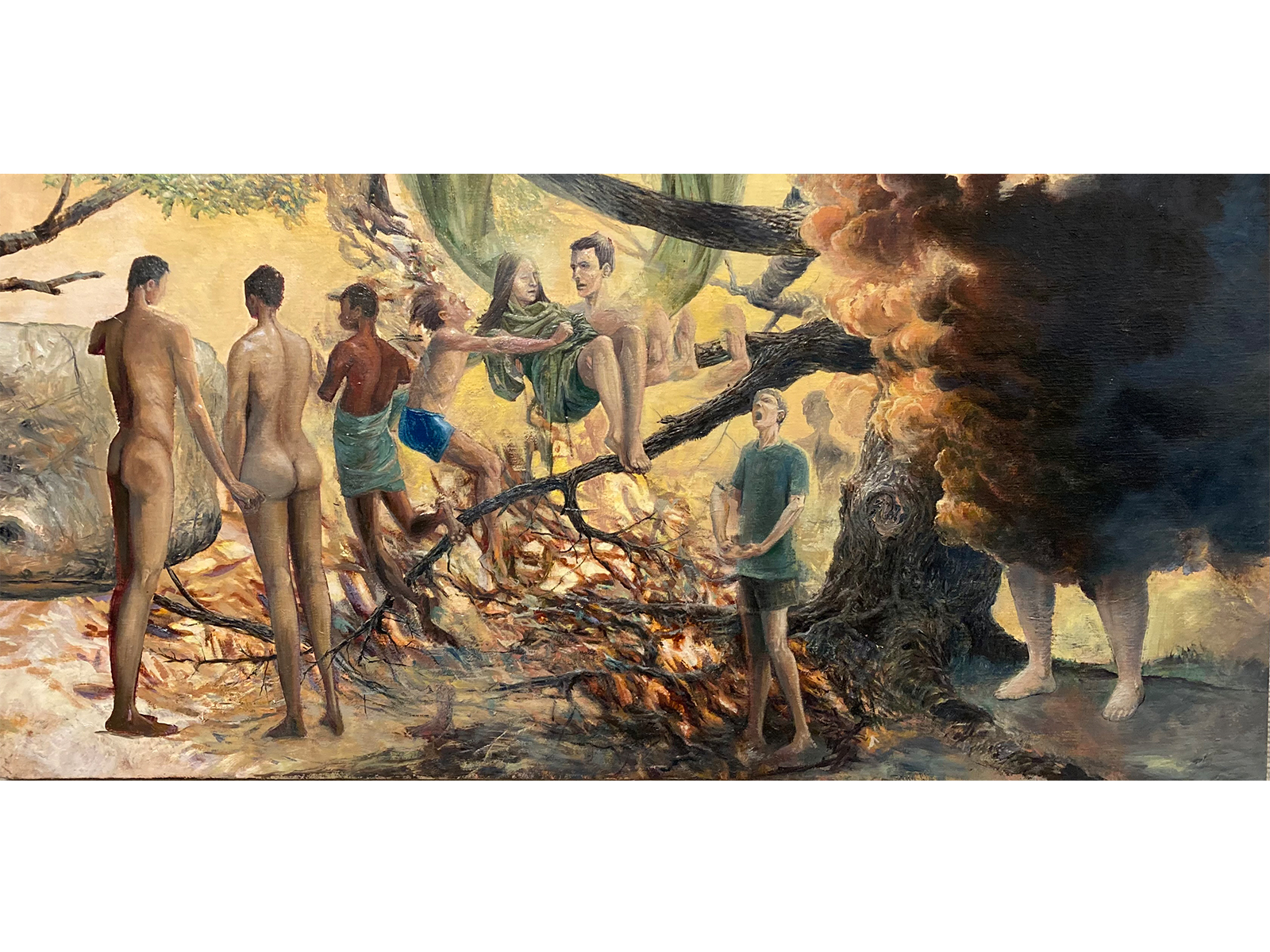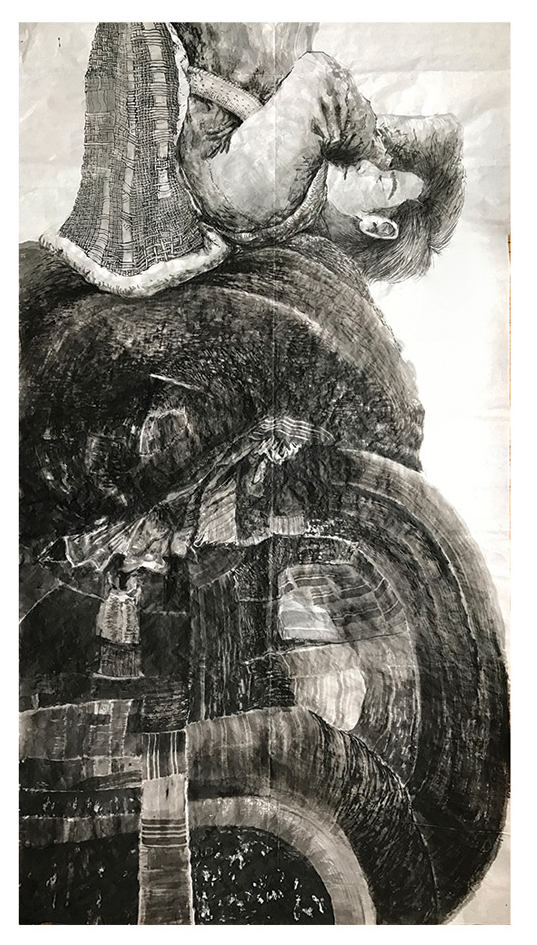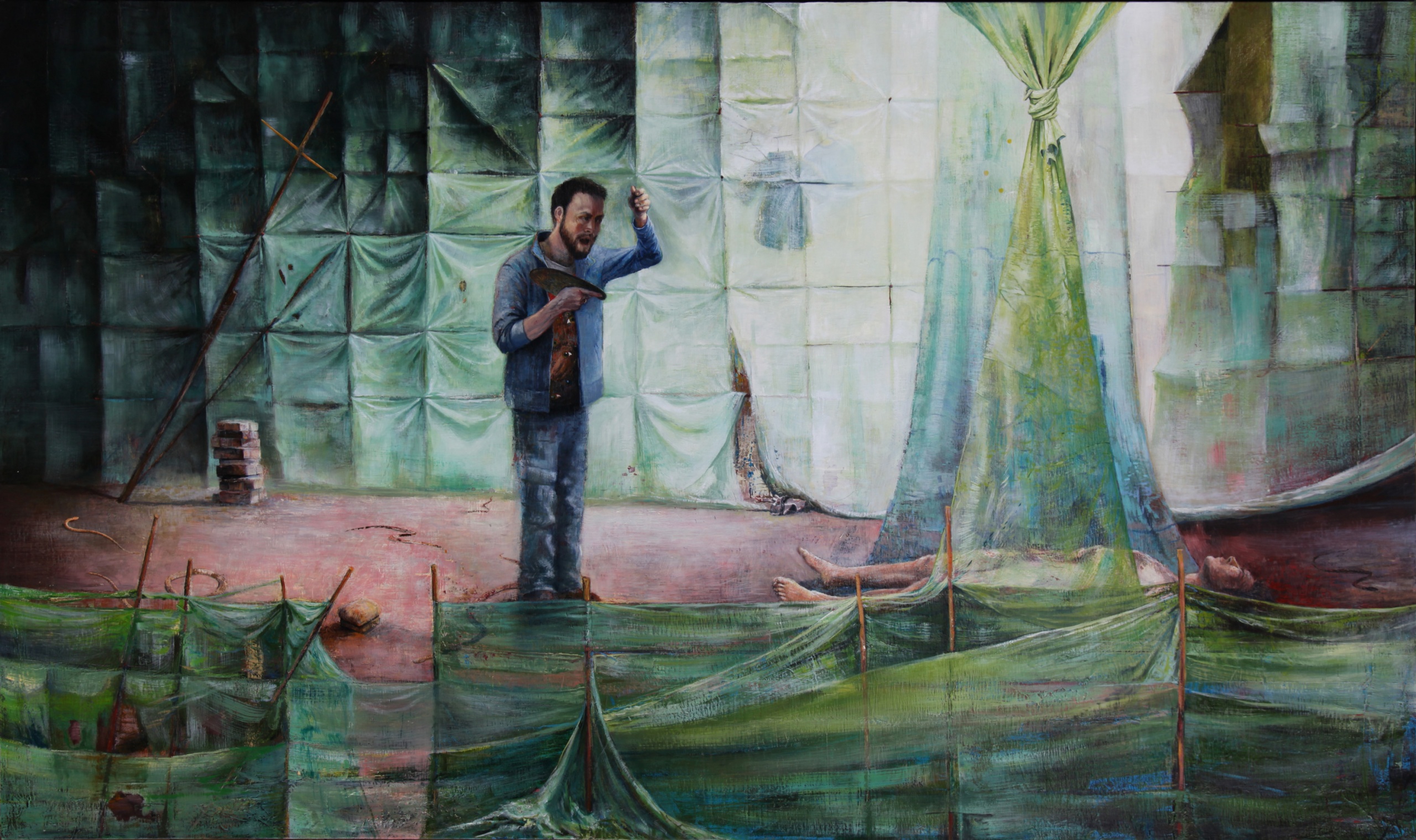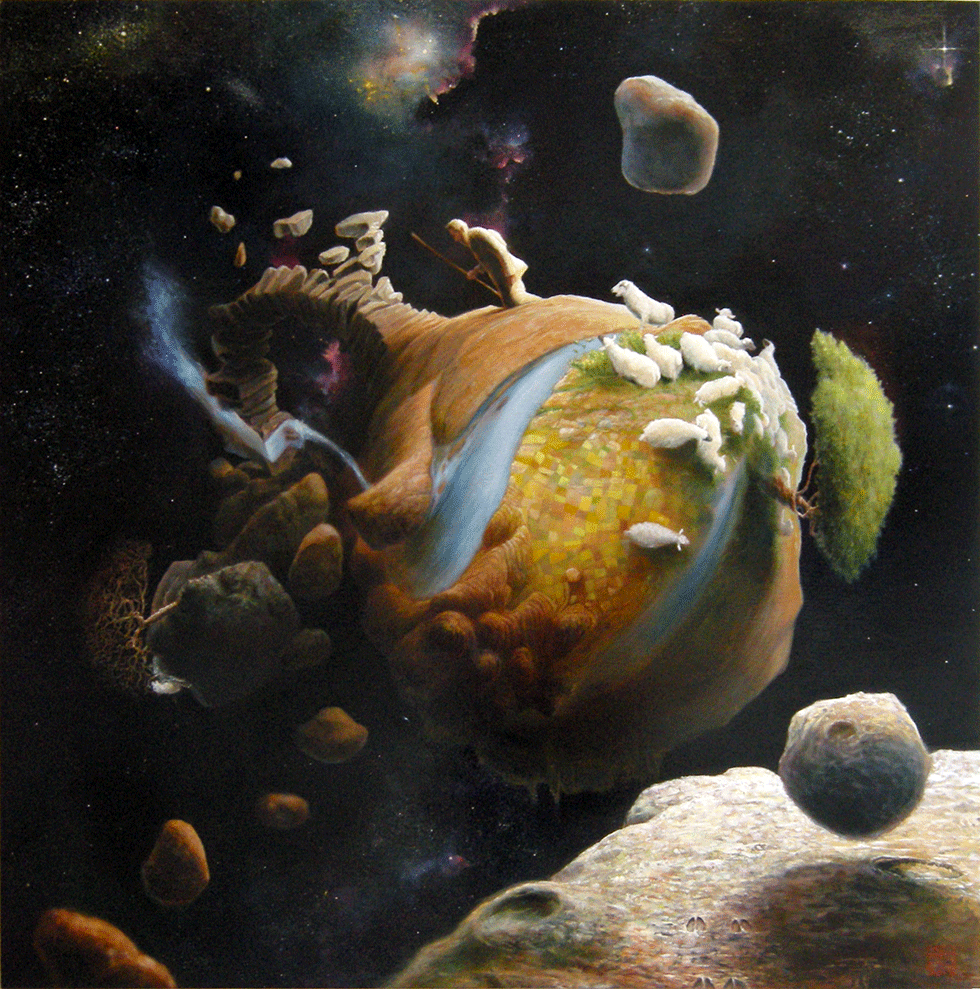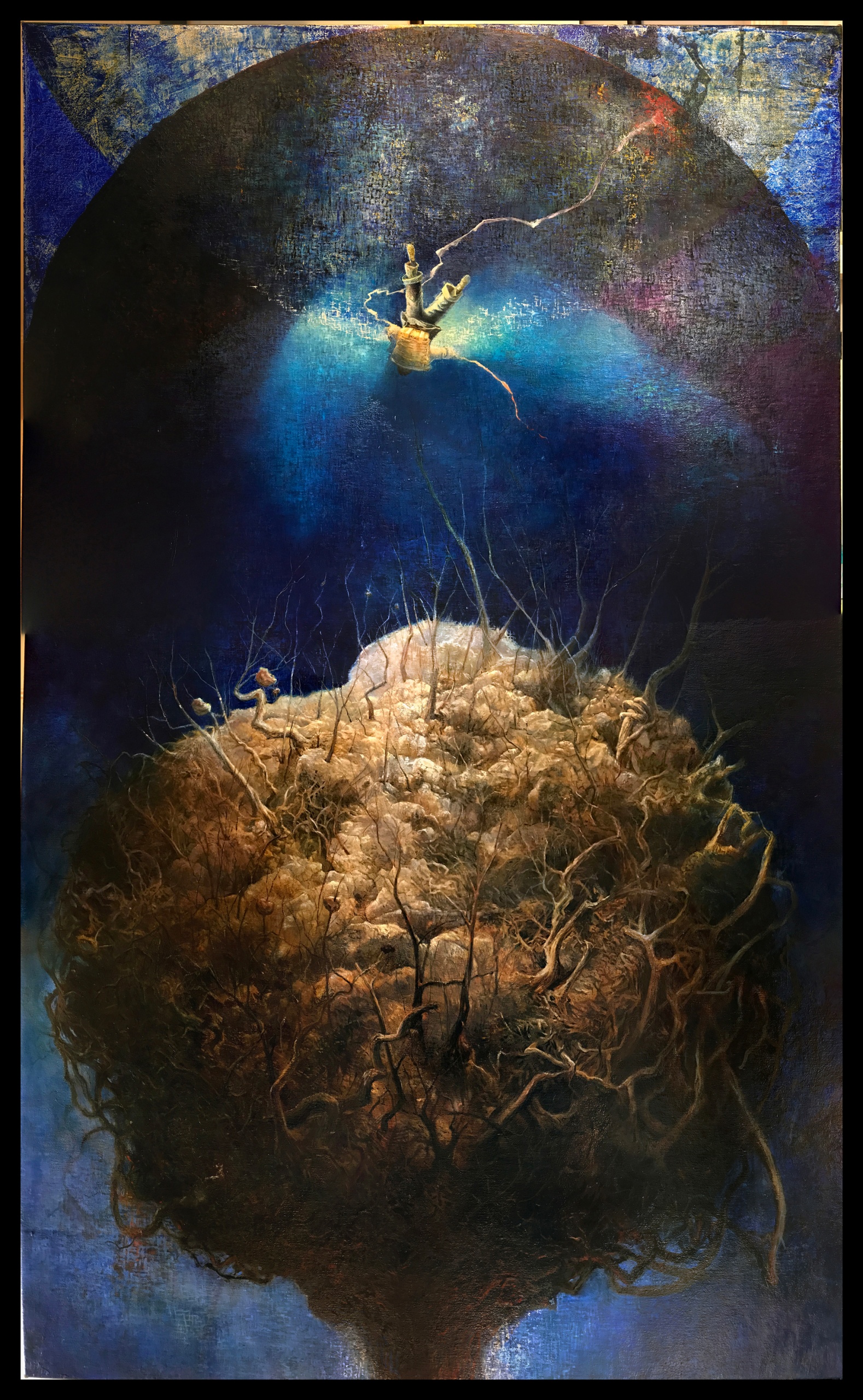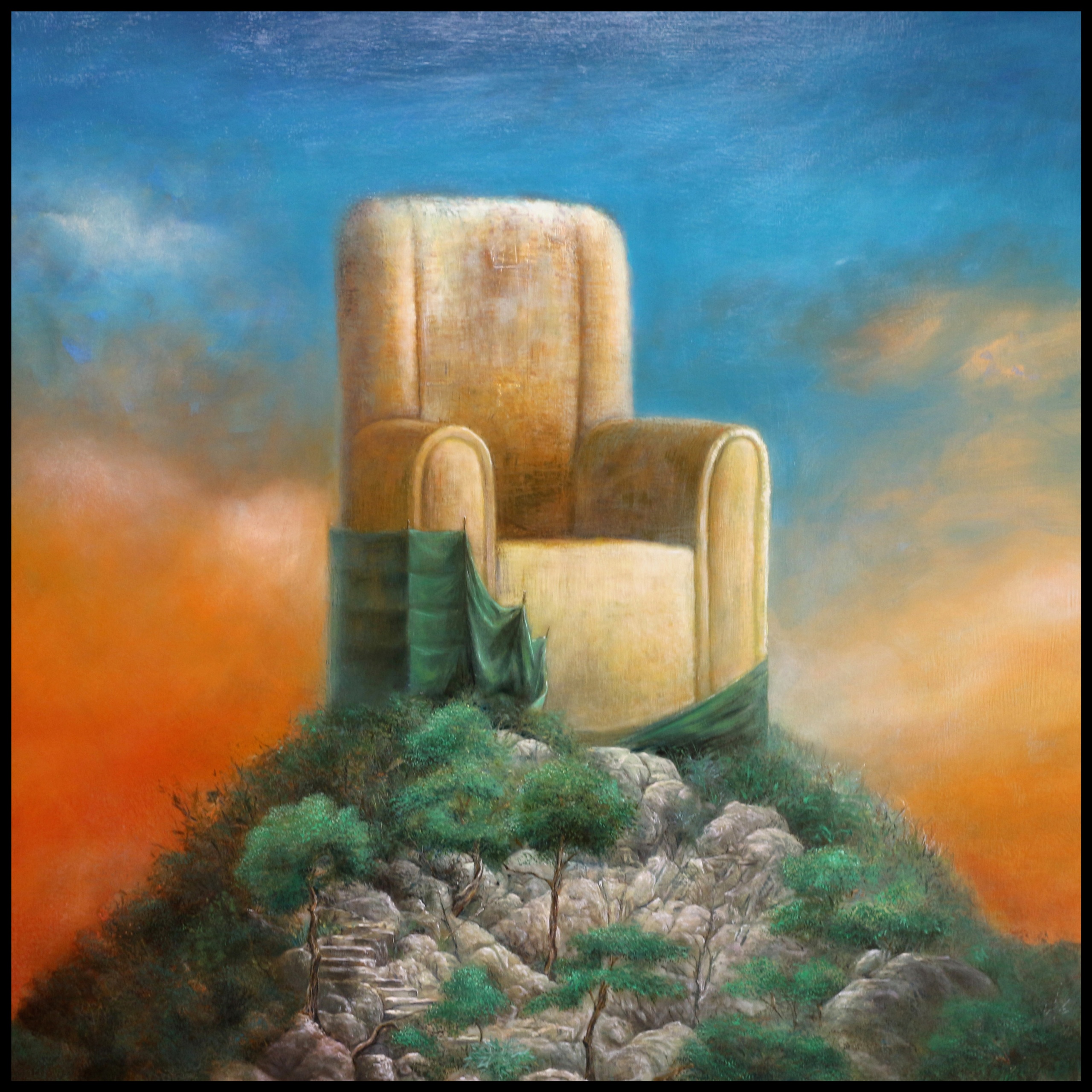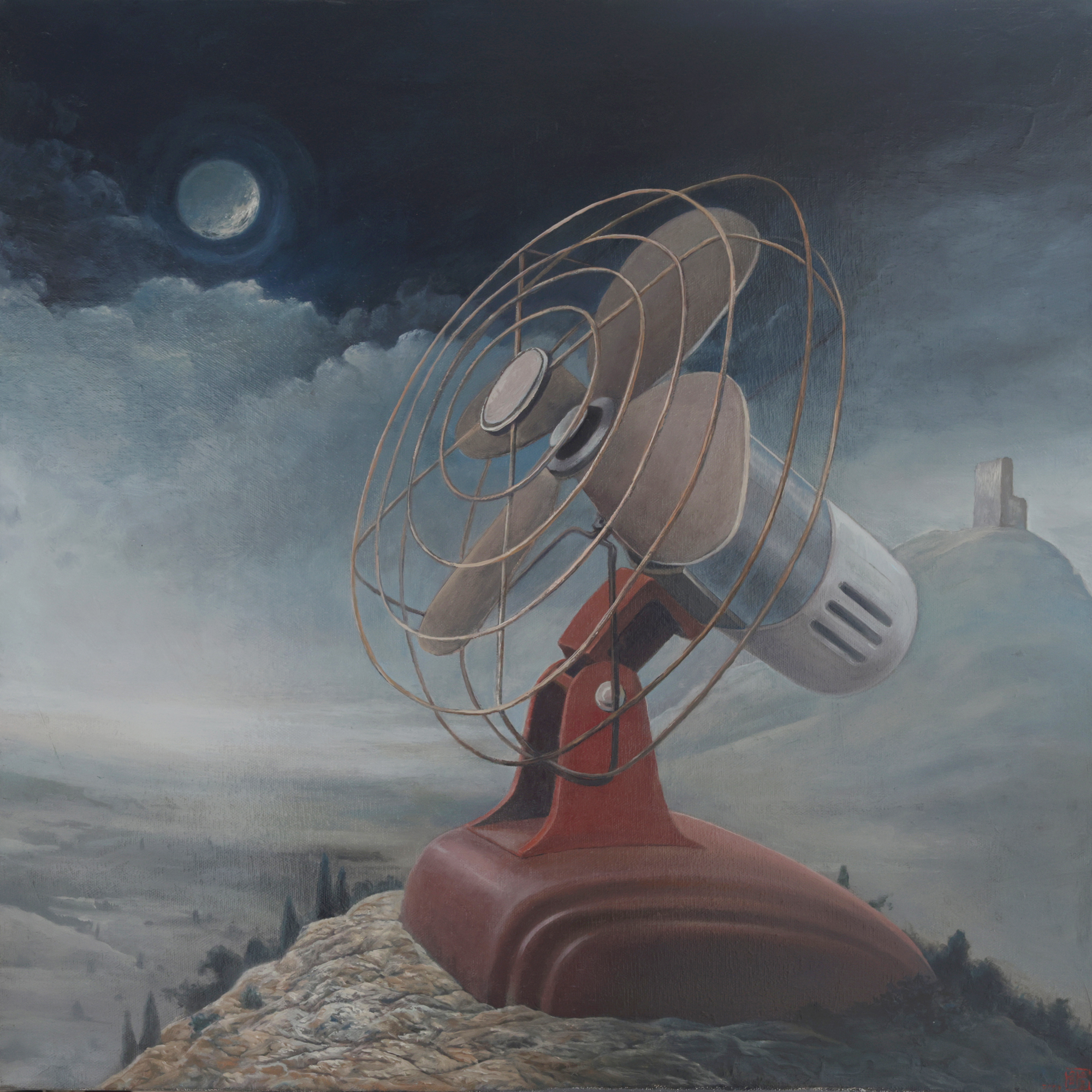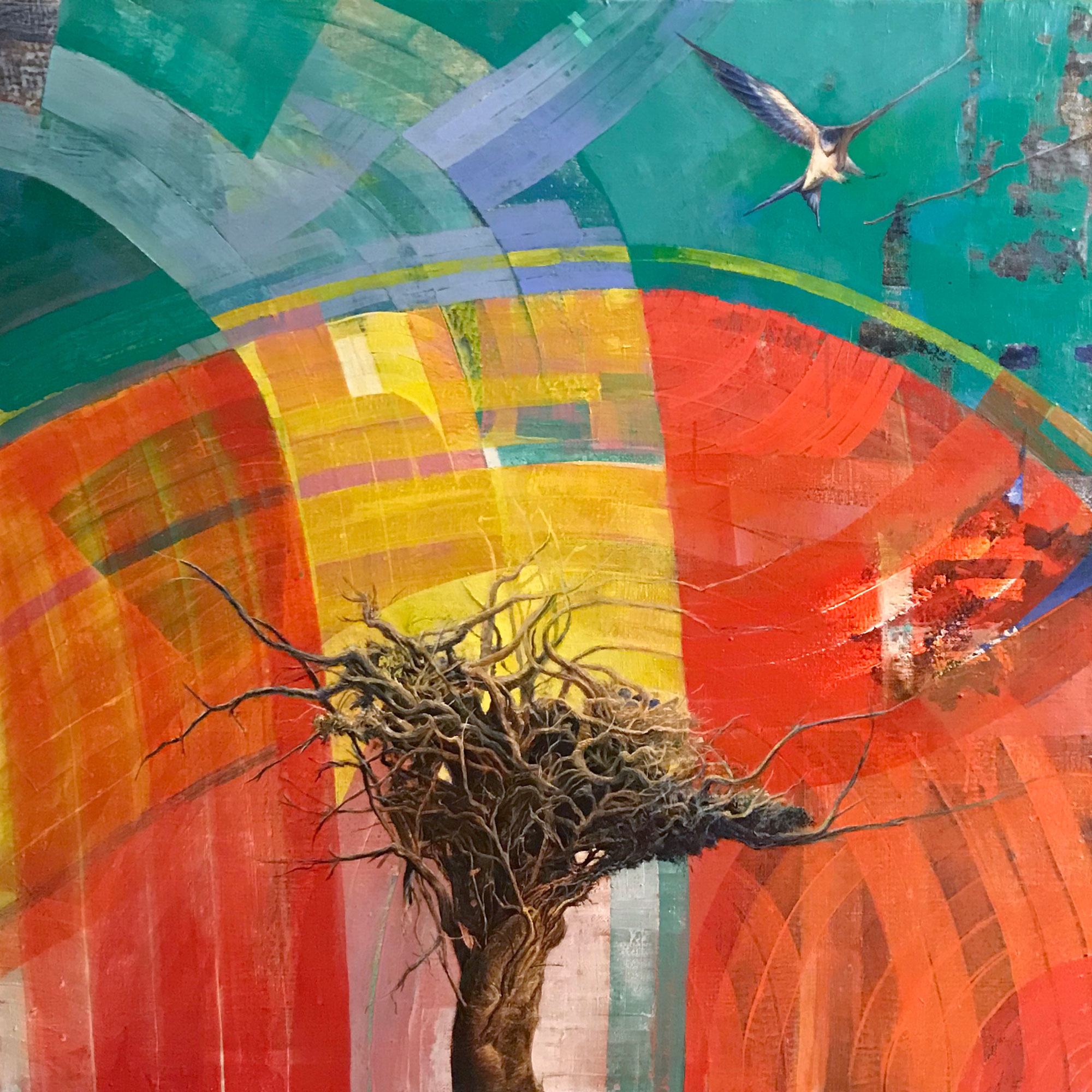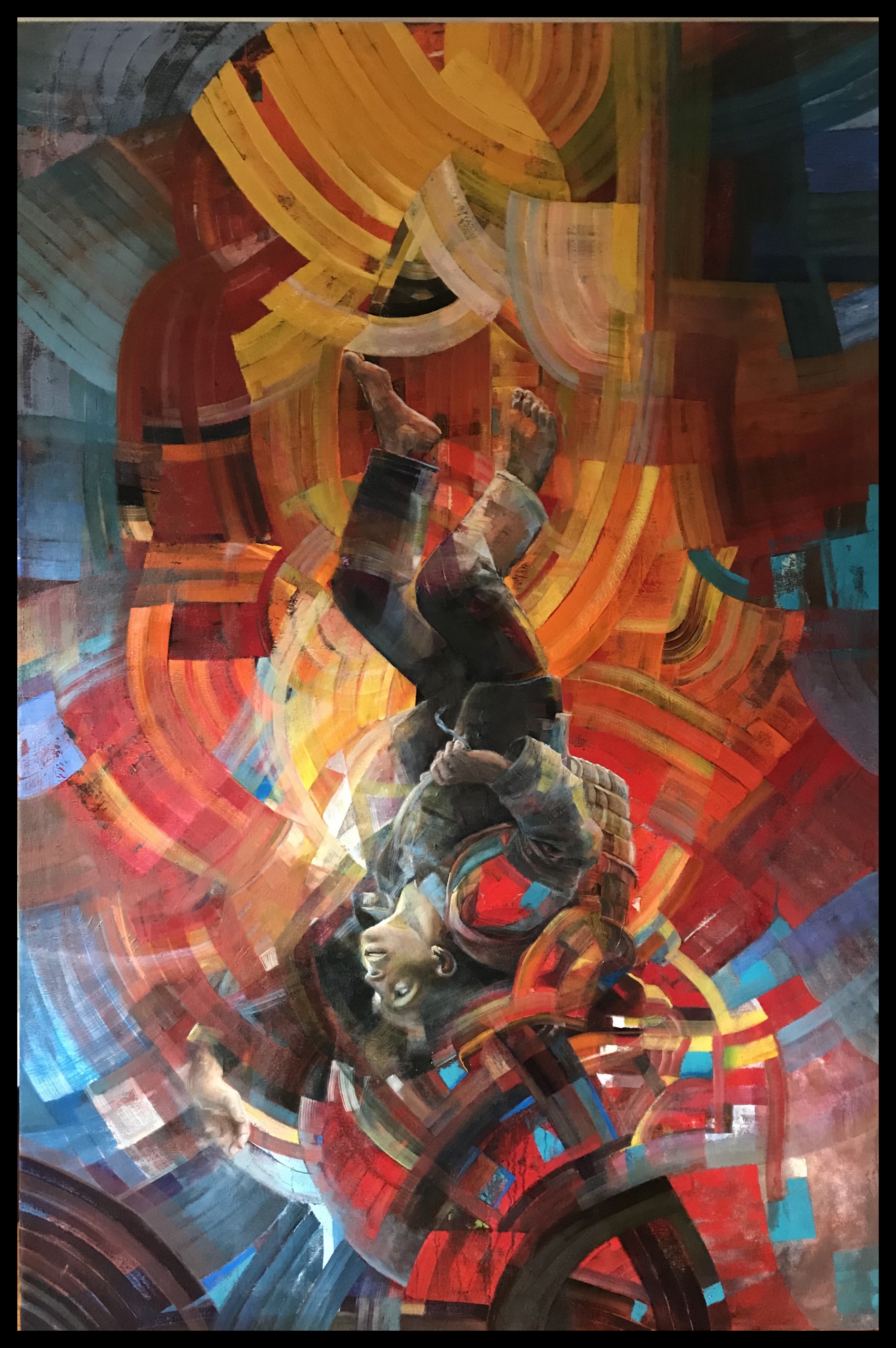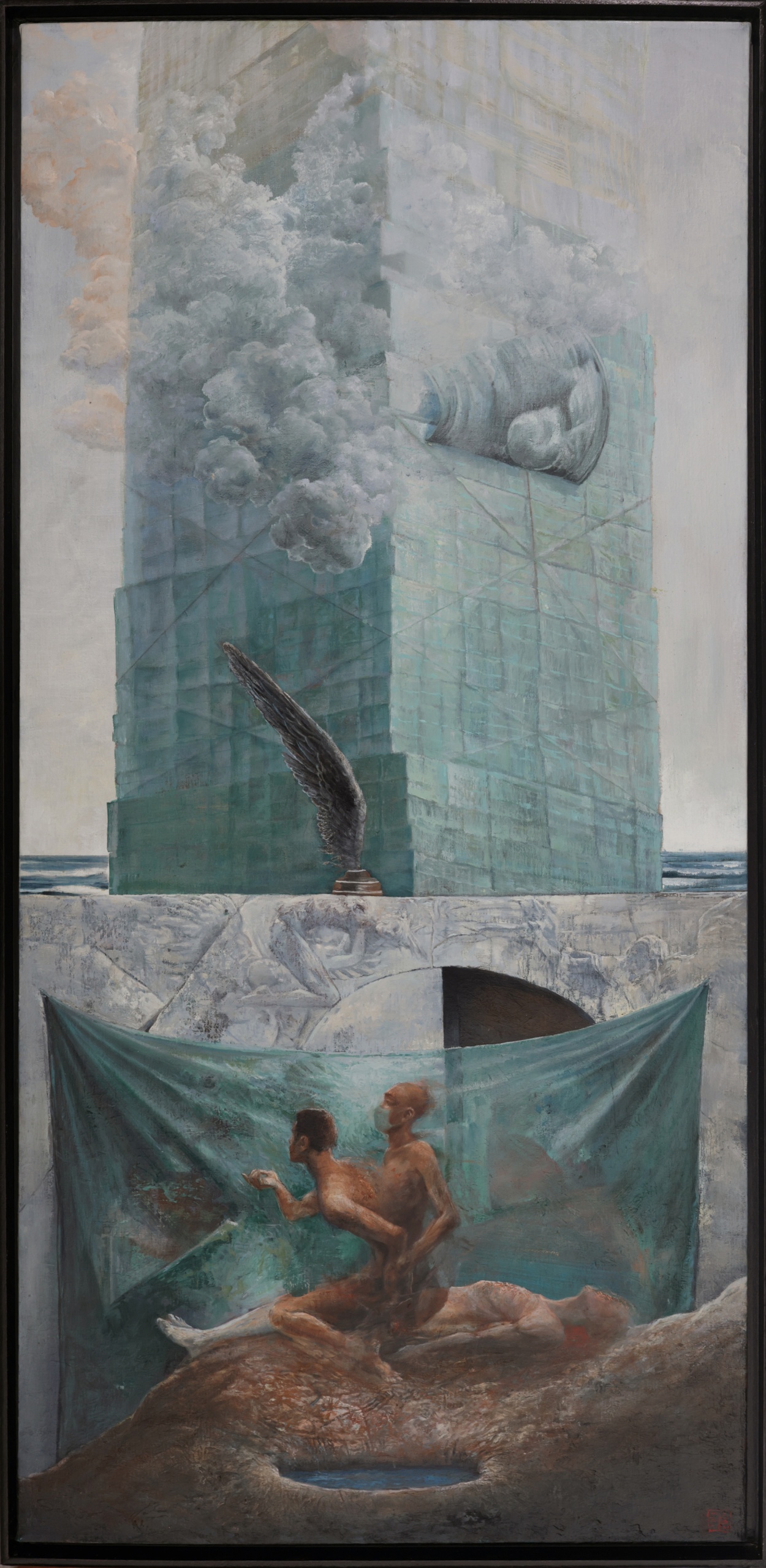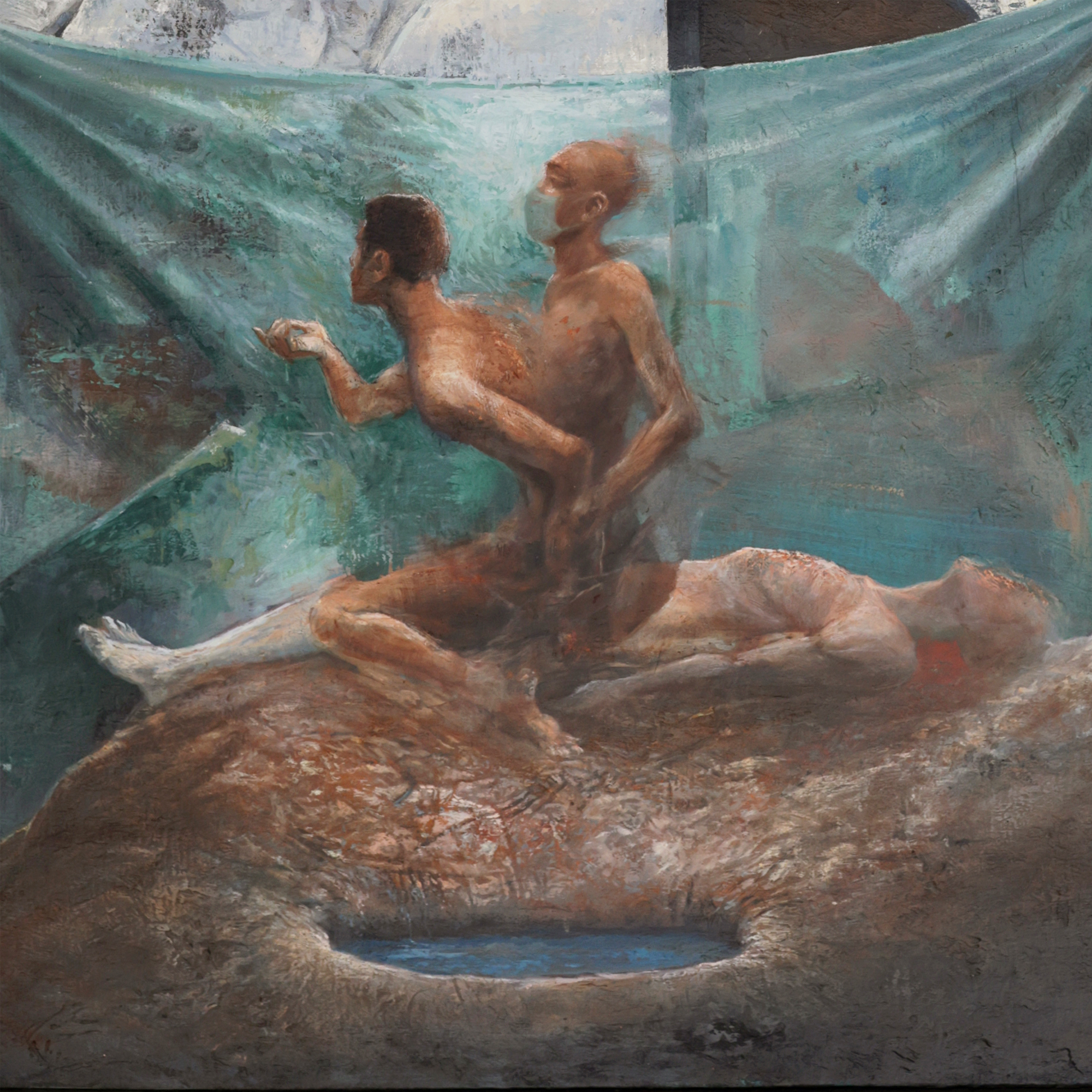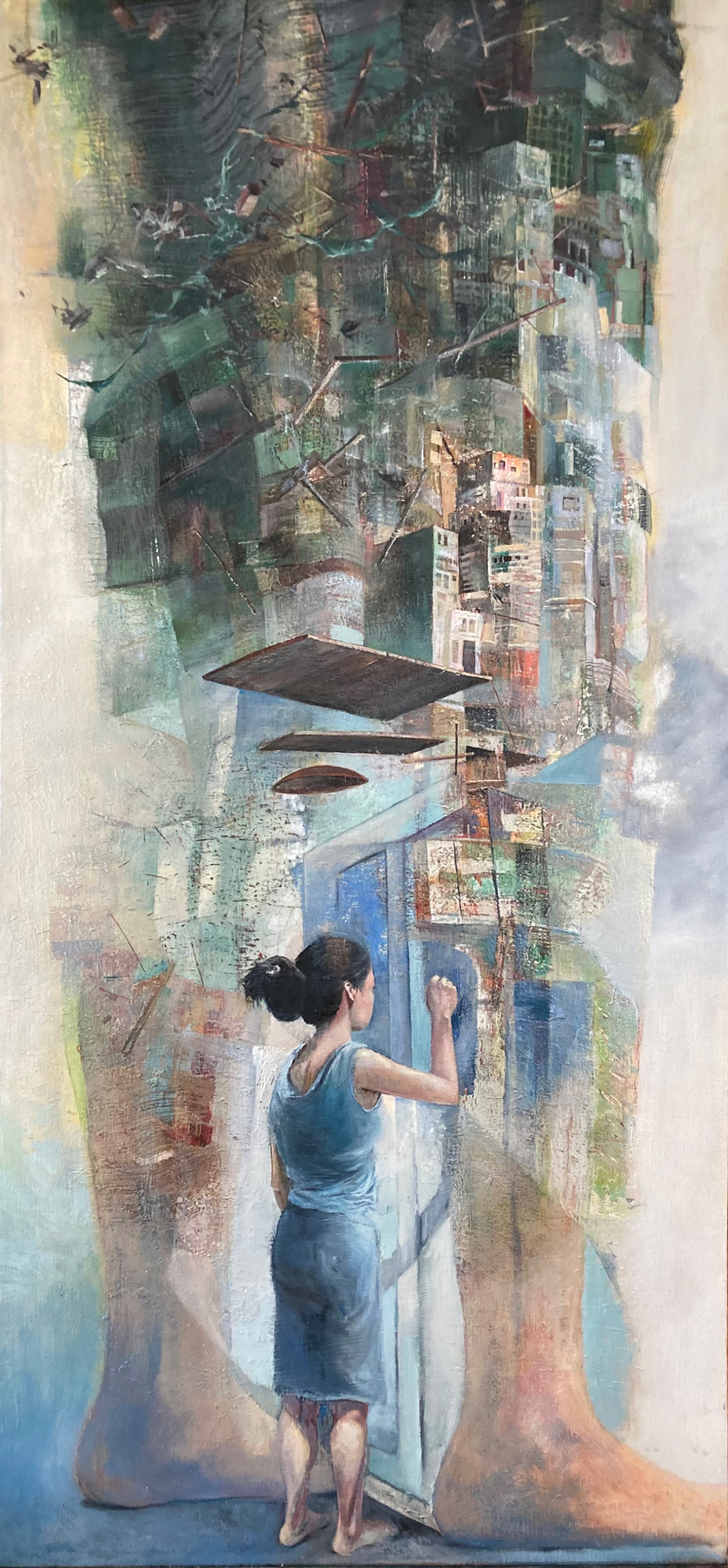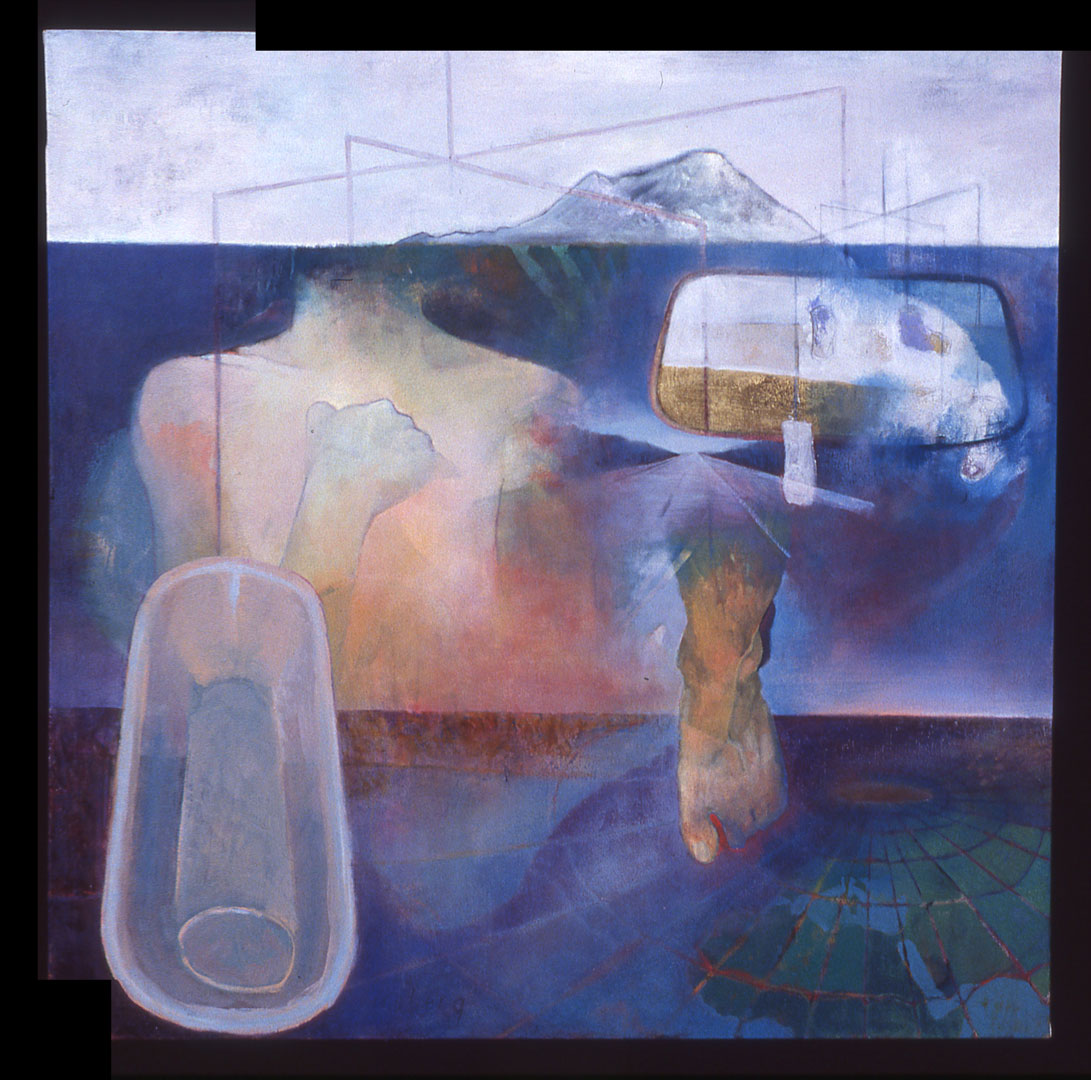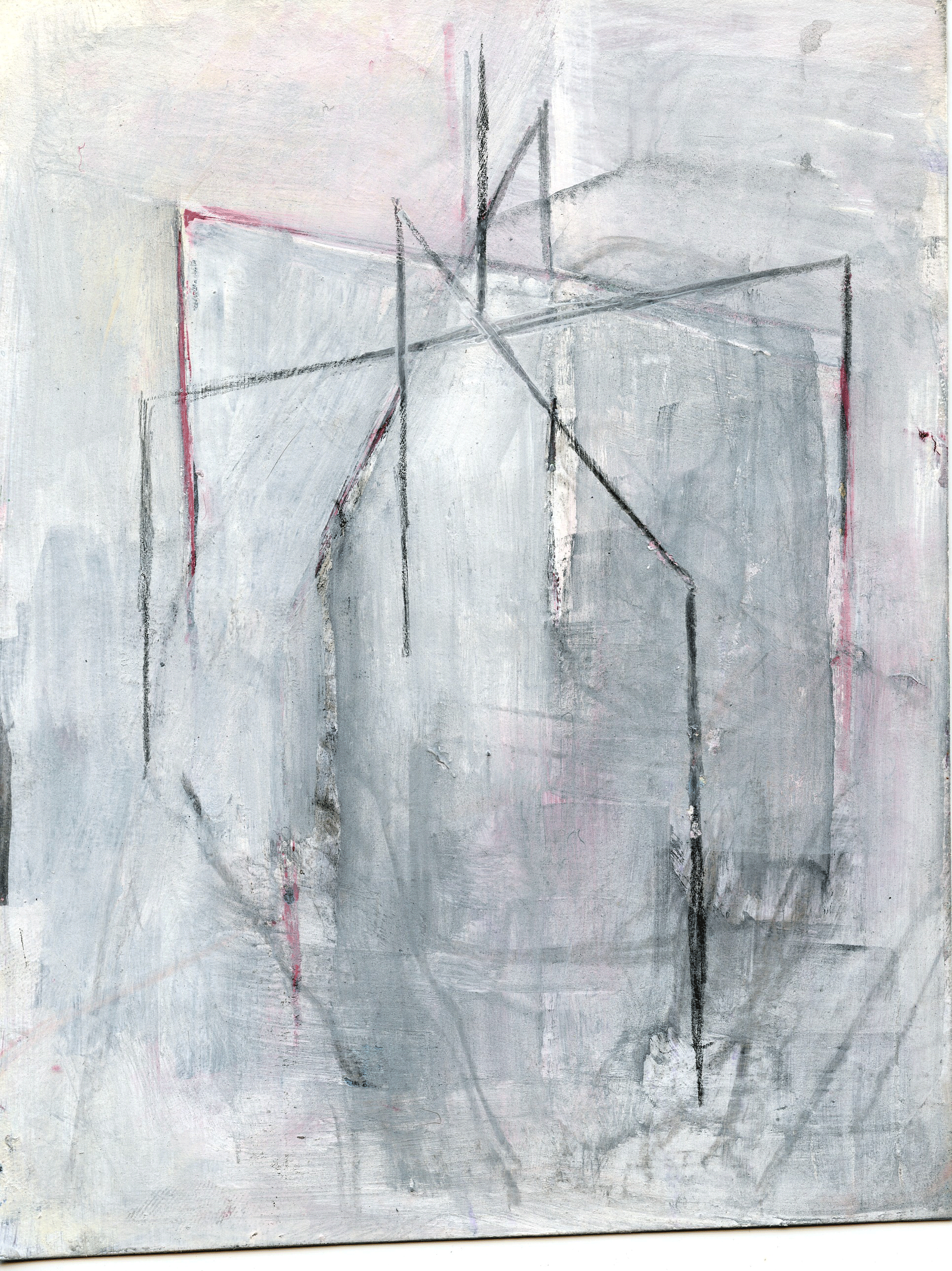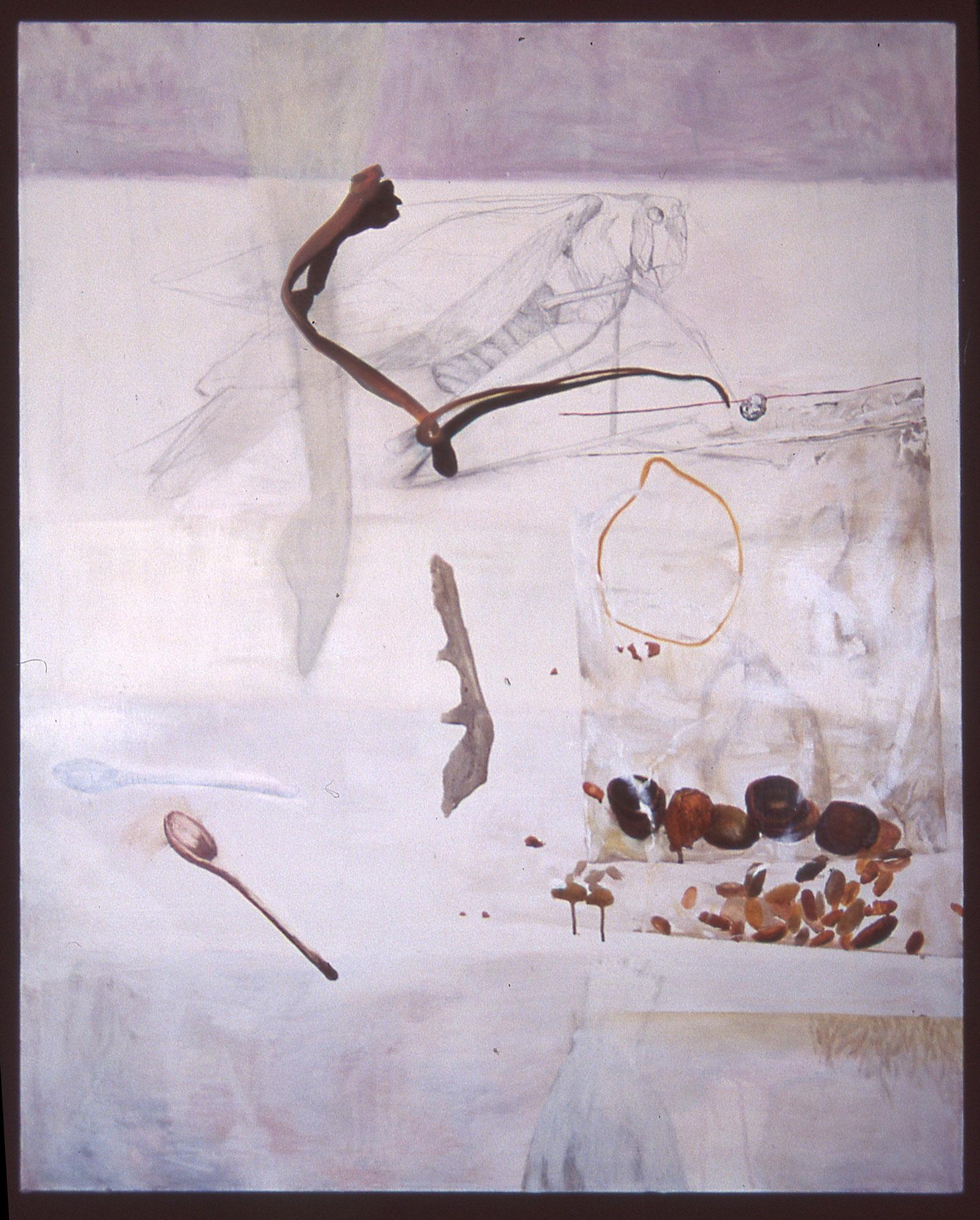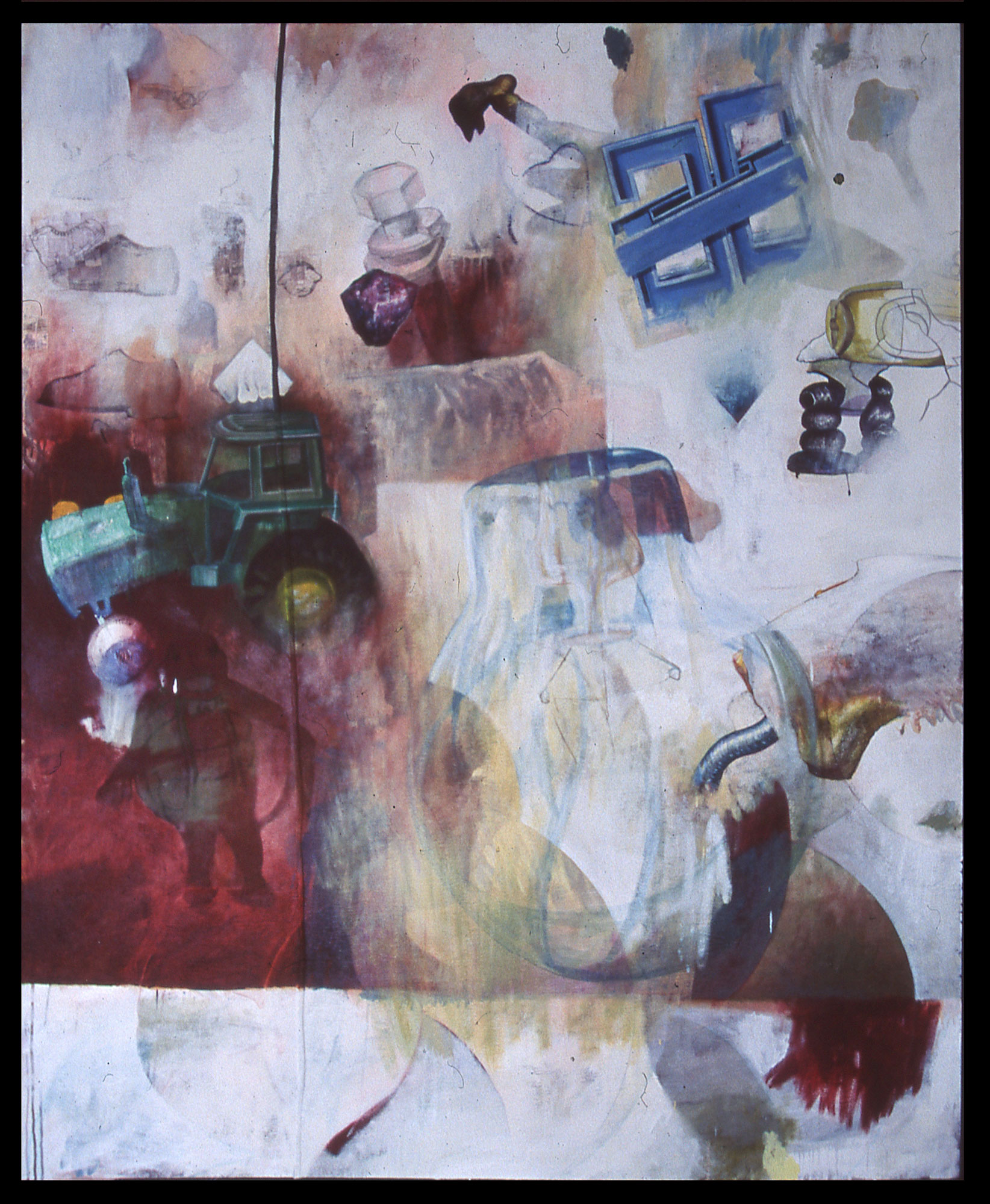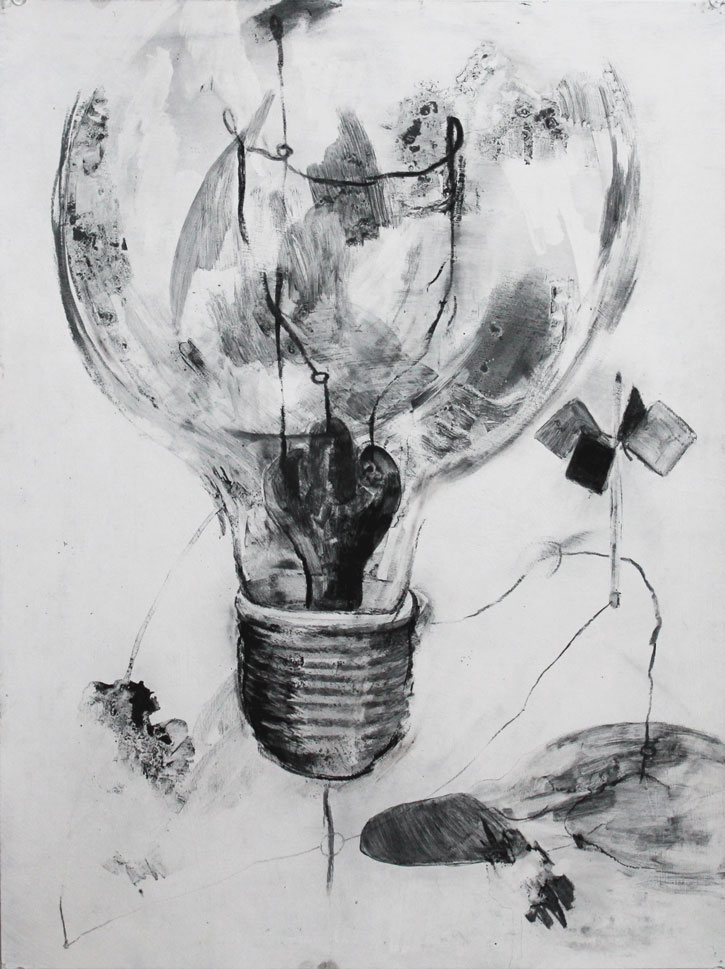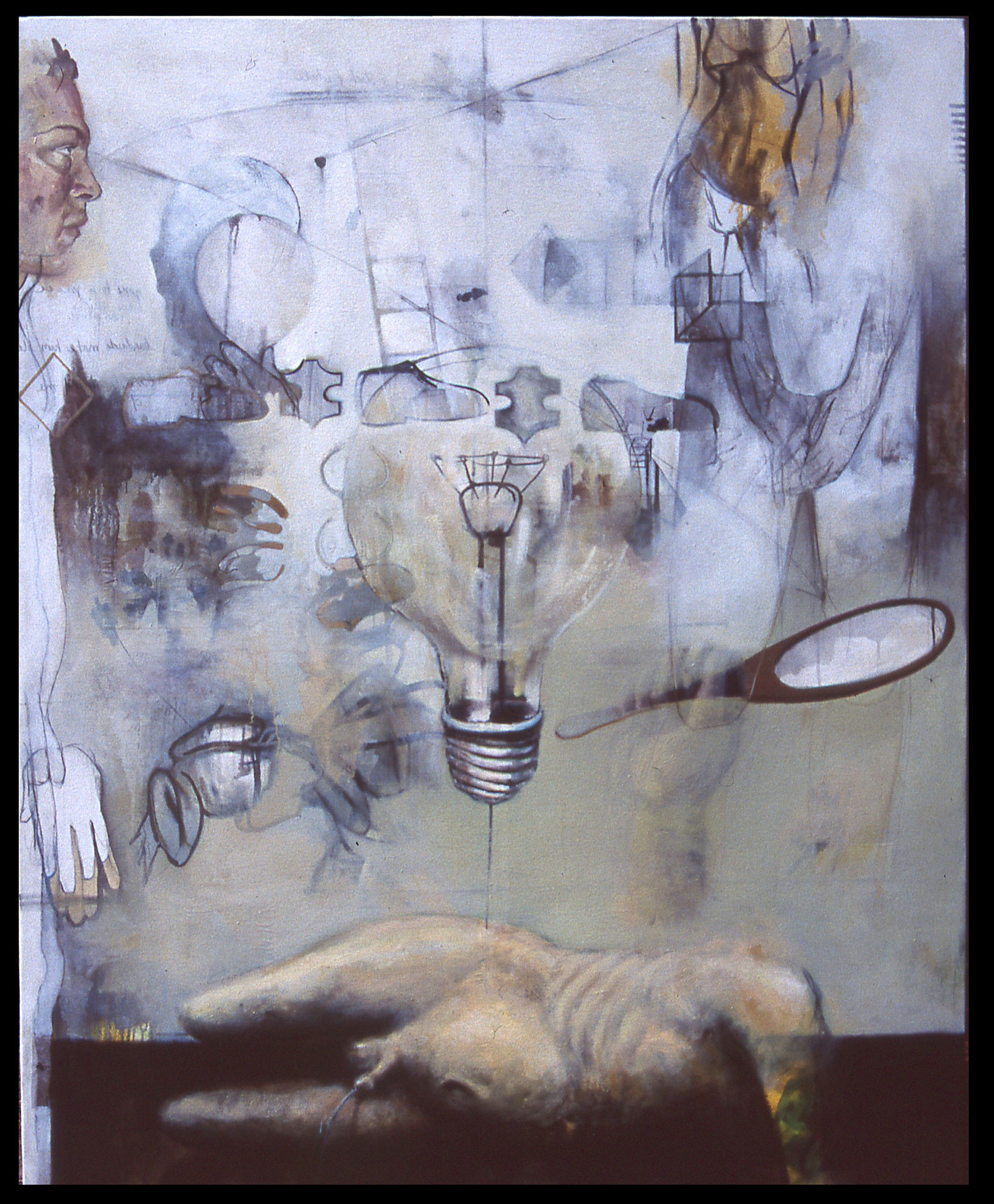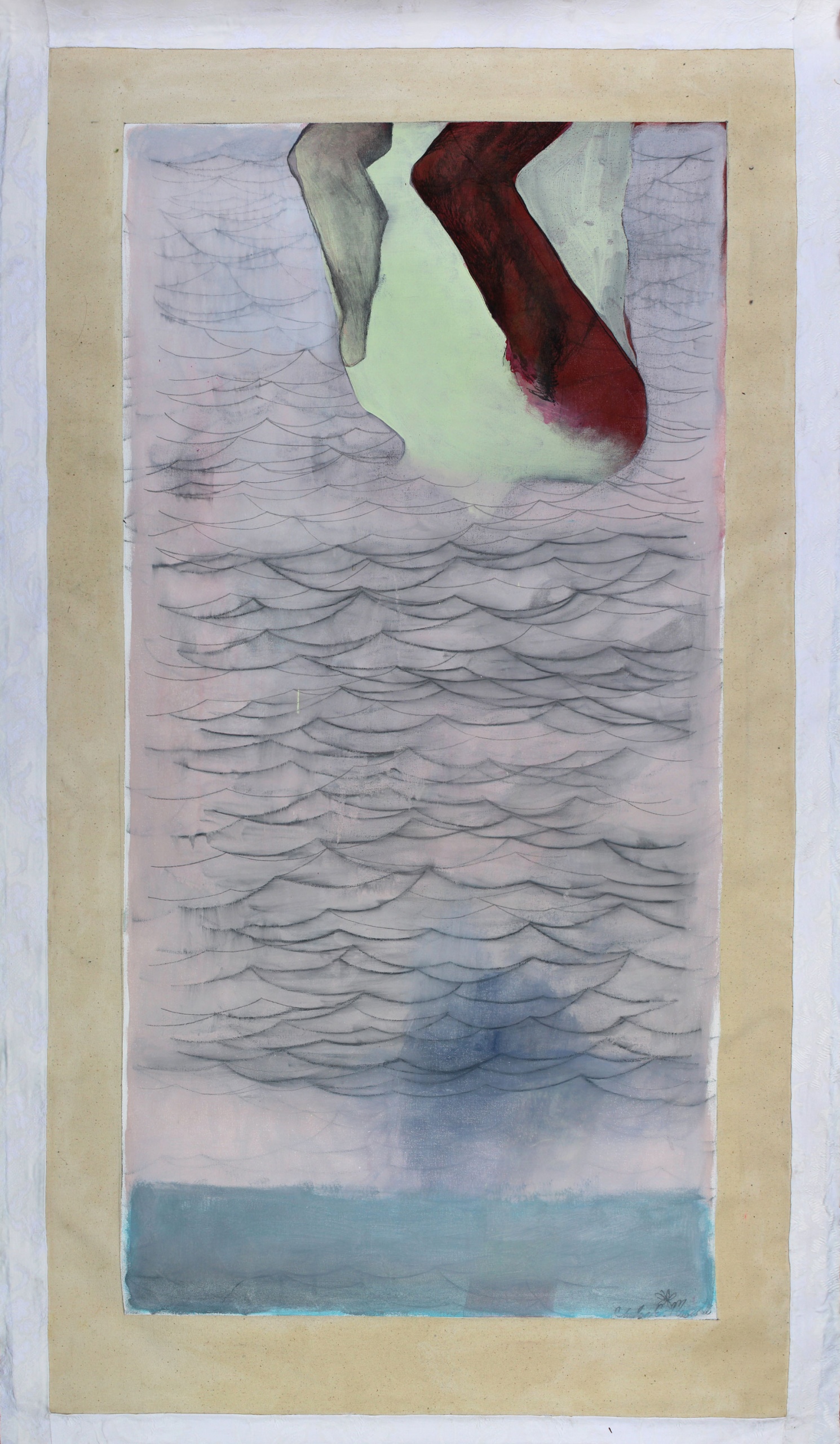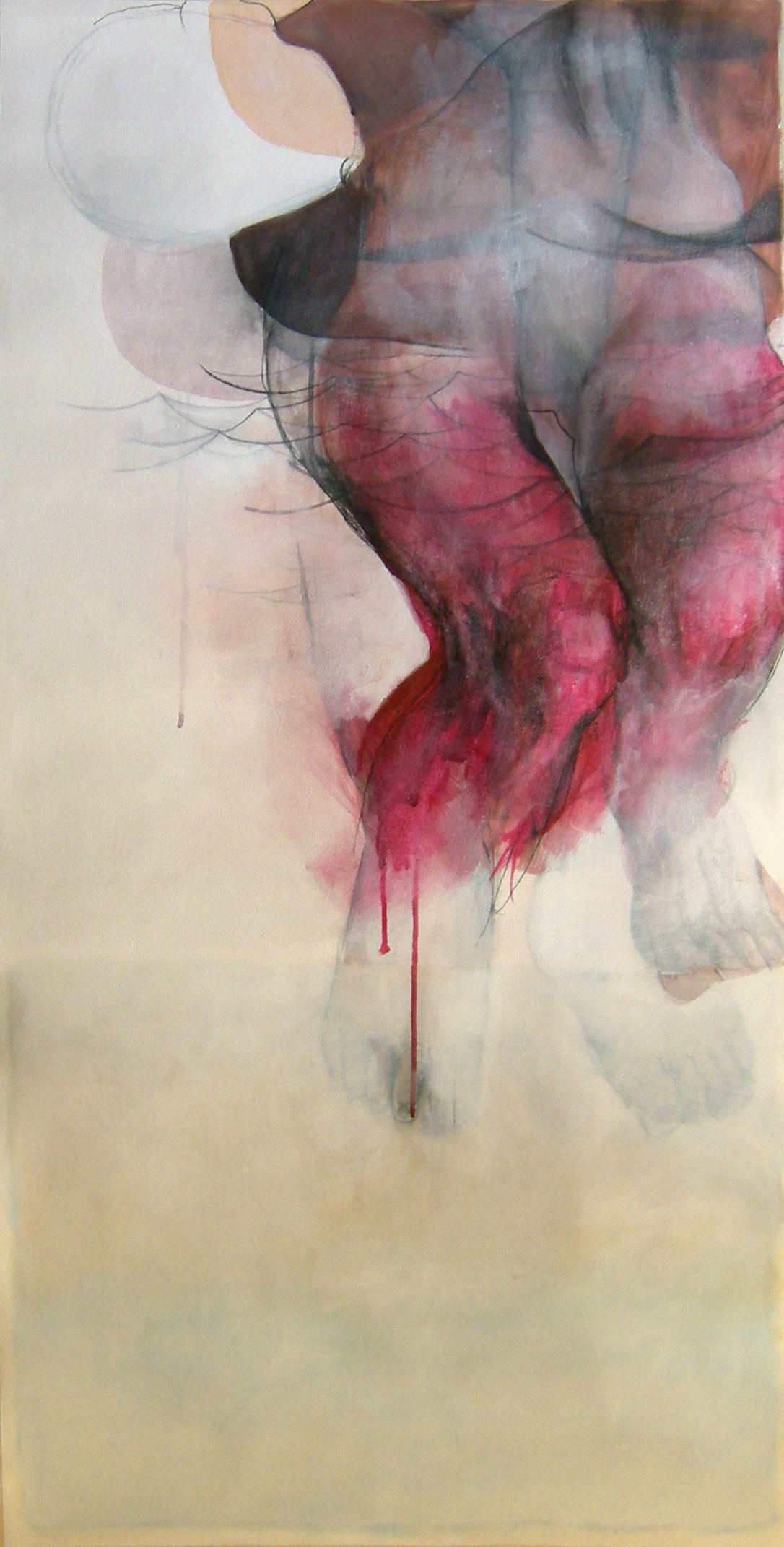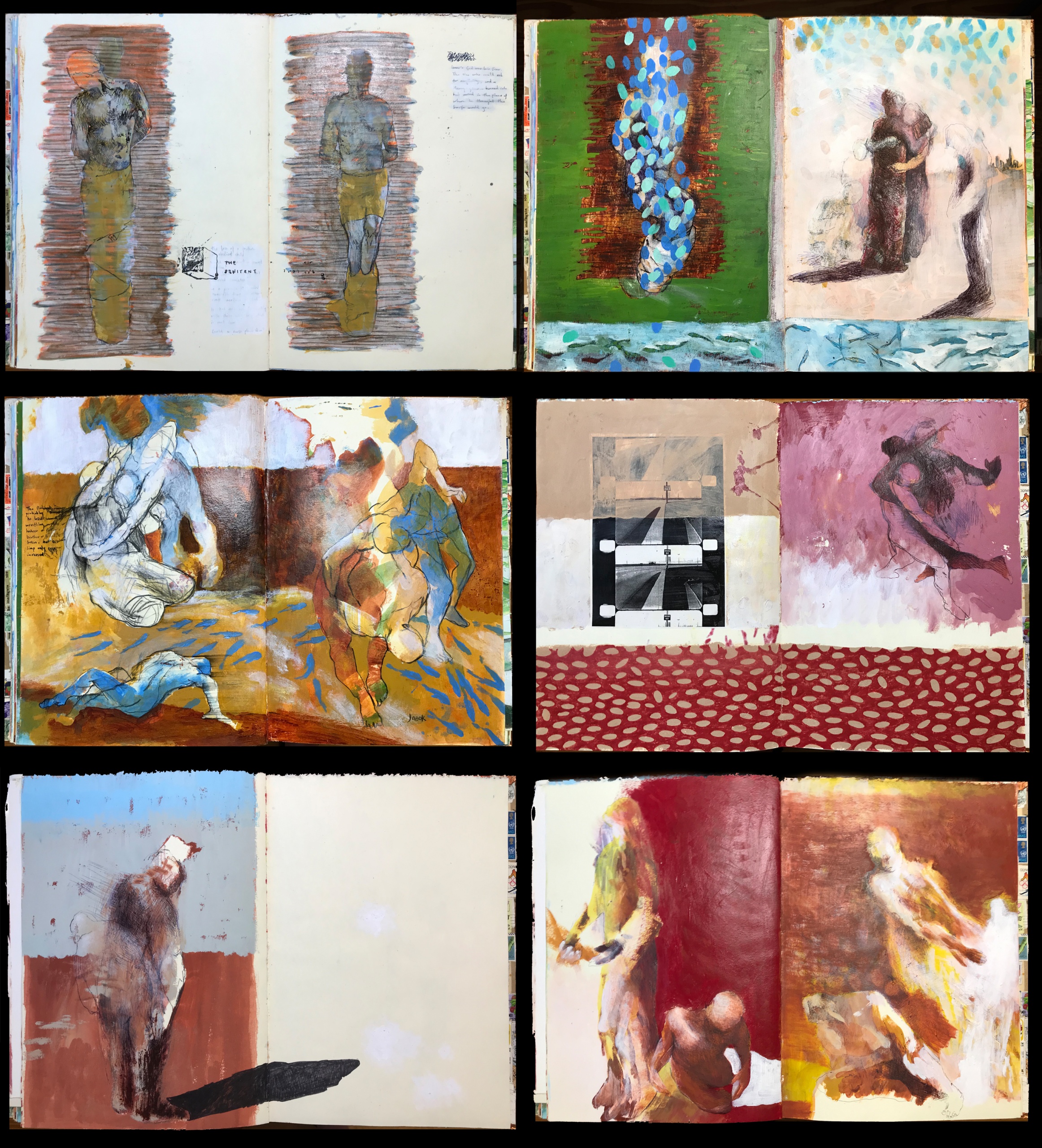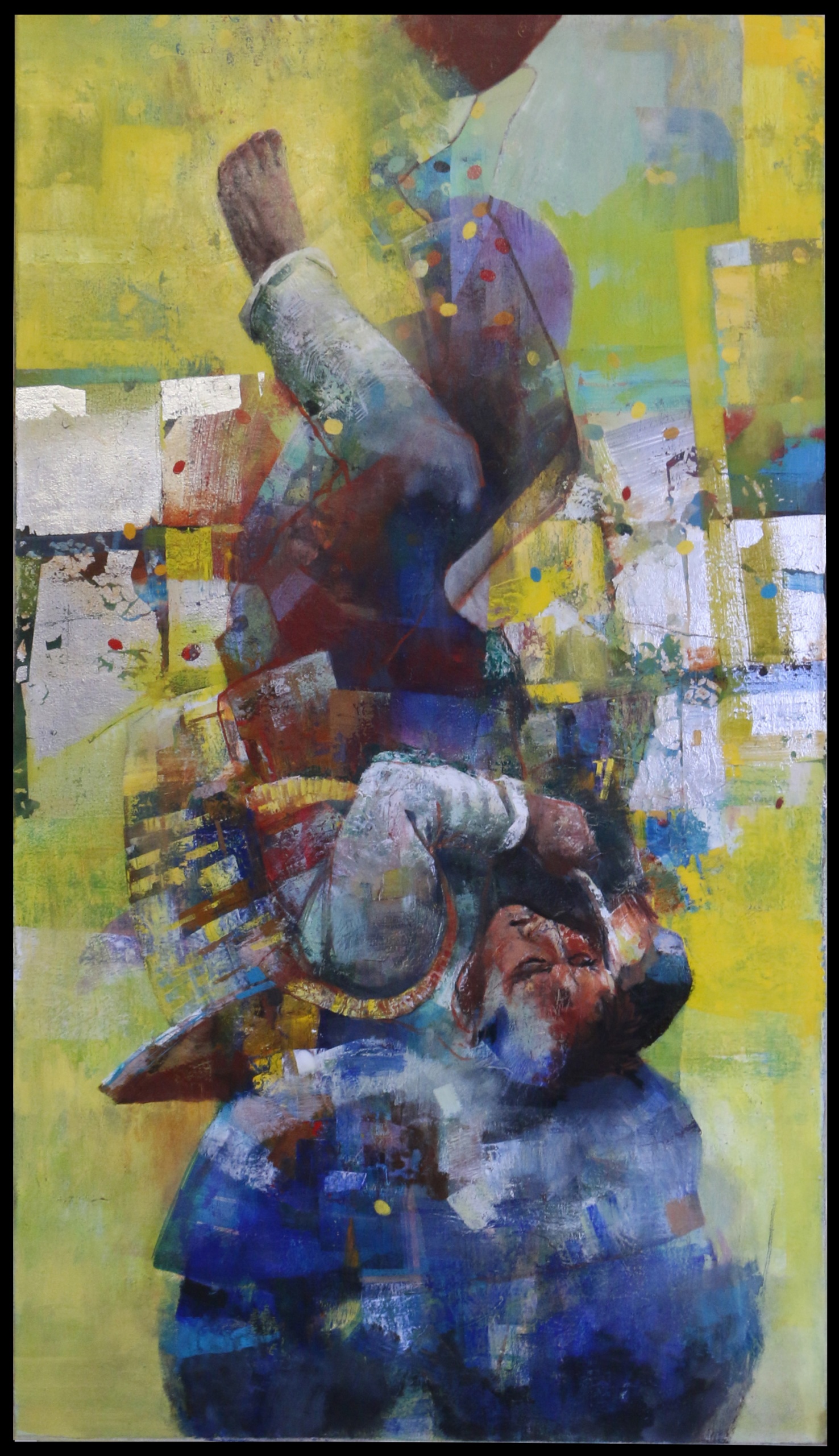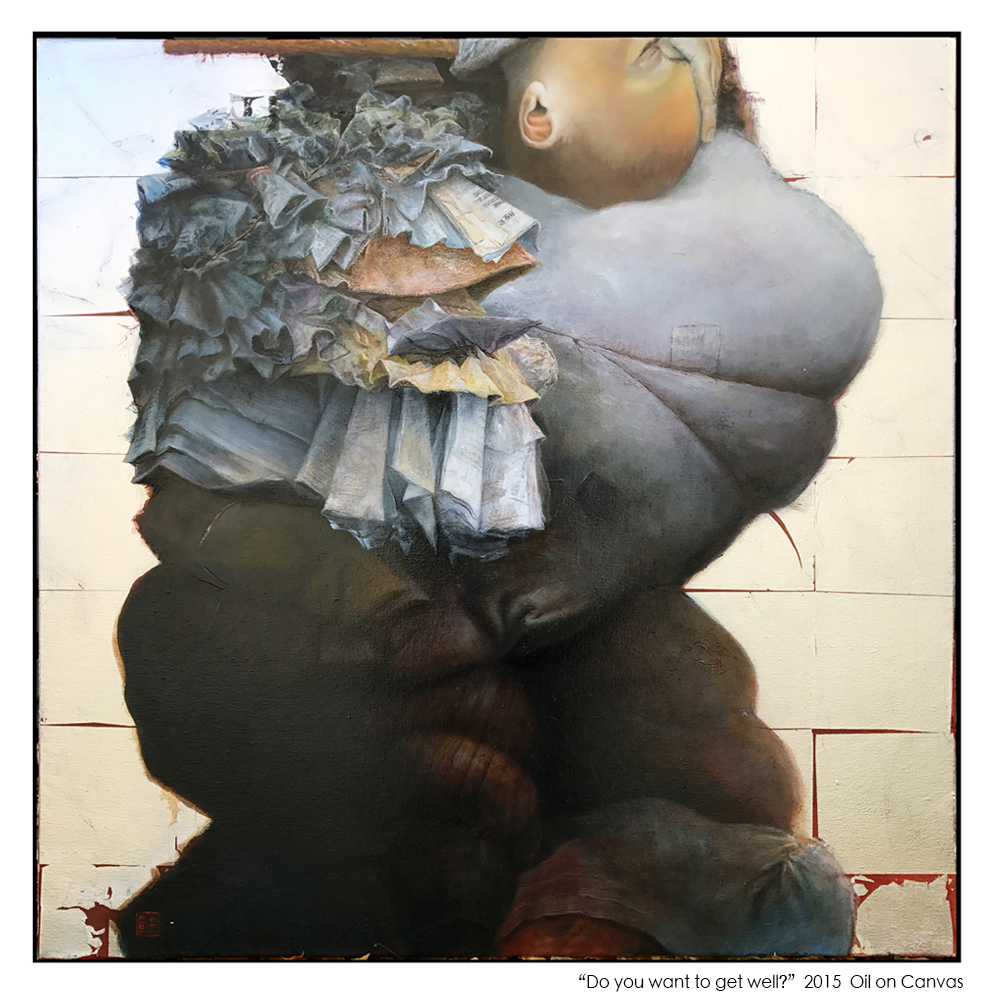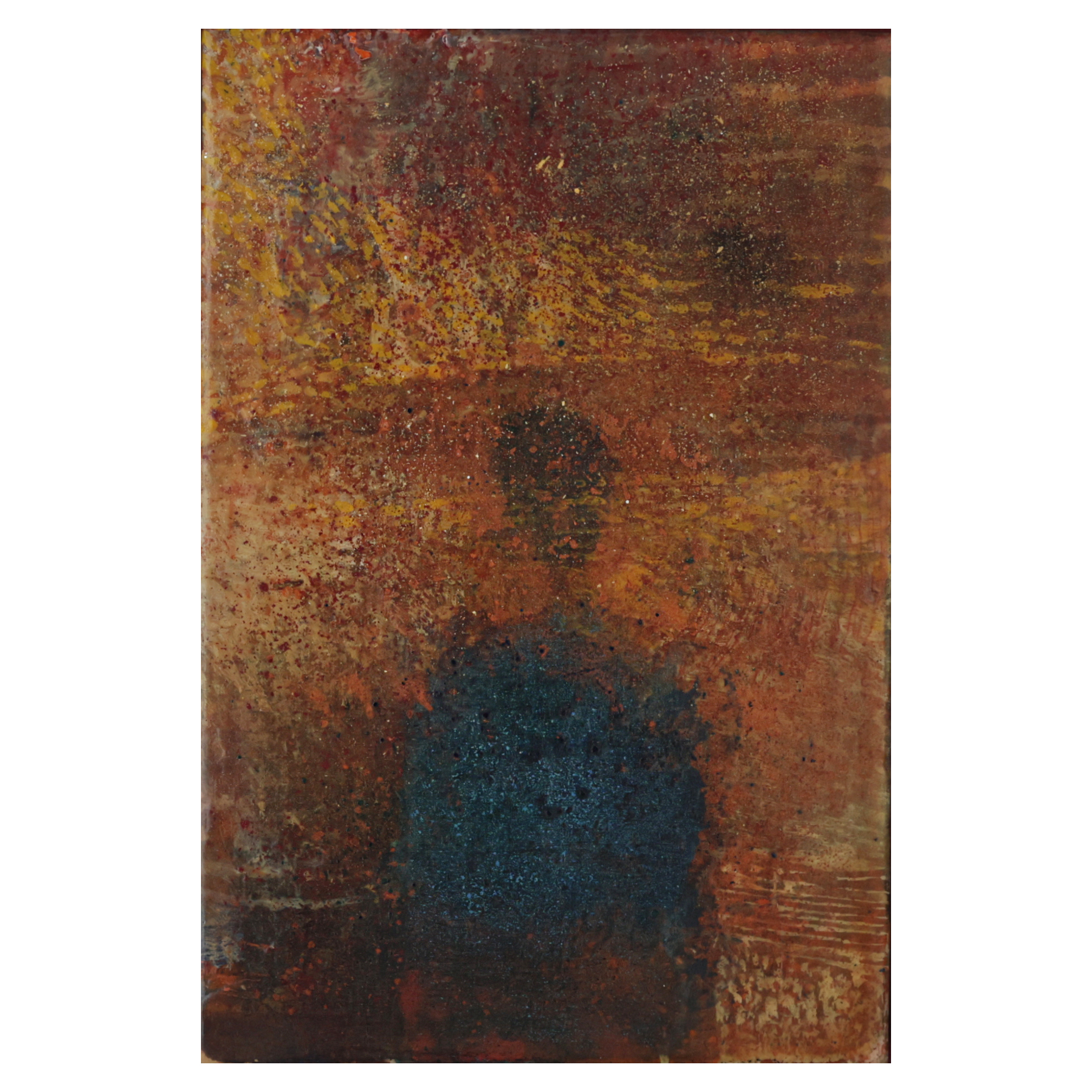Jun 2024 [GROUP 4]
This semester, my studio goals included focus on oil painting and expansion of drawing practice, but engaged increasingly with time-based work. Over the past four months I have been exploring forms and materials including and departing from last semester’s ink collages, panoramas, and projections through various materials and drawing processes.
Studio time in January began with stacks of paper for quick exploratory drawings. Drawing practice has a pliable and expansive root system, with energetic branches of aesthetic physicality and discursive branches for degrees of narrative. This became three overlapping veins: one figurative, one structural/landscape, and one semiotic. The figurative drawings continued from the “In Transition” residency, which I left with a sculptural idea — a figure with loose narrative associations, manifesting as a sort of butoh entity–a distressed and frenetic bundle of muscle and tendon. Drawing mined this idea and helped expunge and organize its presence behind my thoughts as a sometime masked comic book antihero, or as an evaporating personality, a mere ghost whose skin was the paint itself.

Drawing further elucidated another form—a brain, atom, thought bubble, or weather system, a symbol whose varying forms I grouped together, calling them a series of “bandages.” These drawings became large wall and then floor-based installations consisting of direct drawing and monotypes (drawings made drawings). A yogic process, it wove flow, accumulation, and implosion out of self-induced exquisite corpses into oil paintings, which remained a fluid though much slower medium. Oil canvases and panels began contact improv, merging, disconnecting and printing from each other in both material and form.

“Bandage” painting/monotypes, oil on Canvas, 24 x 24 inches
Looking back at these months of reading, writing, and making, I imagine an apex, one side of which slopes from intention unto fixity, and the other sloping from suggestion unto abstraction. The assumed task is to roll an egg, with perfect attention to its complex simplicity along that conjoined state at the roof’s apex. For me, animation became the mode of this Sisyphusian activity. However I found this new medium a scramble both wonderful and baffling in the scope of labor required to communicate clearly, and the multiplicity of processes available. Moving images and sound waves together create a liminal space where materiality evaporates as ideas distill into other ideas. Yet, as noted by my studio mentor, Matt Saunders, this is part of the practice of conceptual processes where one thing can roll into another while avoiding the illustration of those connections as conclusion. The right mindset lets the tactile fuse and unfurl as a devotion to the doing of the work itself, somewhere between technique and discovery.

Whether rolling, scrambling, or putting the egg back together again, extra-studio time found me editing and evaluating both the unexpected ghost mark and the mature composition among the cloud of drawings, paintings, and prints (finished or otherwise). Hence, I became both artist and viewer. I began to perceive a communicative relationship between artist and work, and work and viewer, and perceive questions around transposition in the one case, and translation in the other. As artist I wanted to transpose one material to another. Alternately I received the outcome of my work in translation, as a viewer. The viewers’ points of interest often initially connect to those fantastic stimulants without committing, or believing, and then gravitate to the pragmatic—some self-evident hand rail whose beginning and end are both obvious. But art harbors a higher medium incarnate in a lower, a polyvalence at once ineffable and vulnerable. The juxtaposition of hybrid forms and new meaning extends an invitation through the mundane, and even through the catastrophic. I have extended here veins of dialogue in and for wall-based and time-based practices — fragile containers for reciprocal, moving, and images living on the verge of discovery.
<PAINTING>
<DRAWING>
<TIME BASED>


Jan 2024 [GROUP 3]
<LUNDER CRIT SPACE 207>
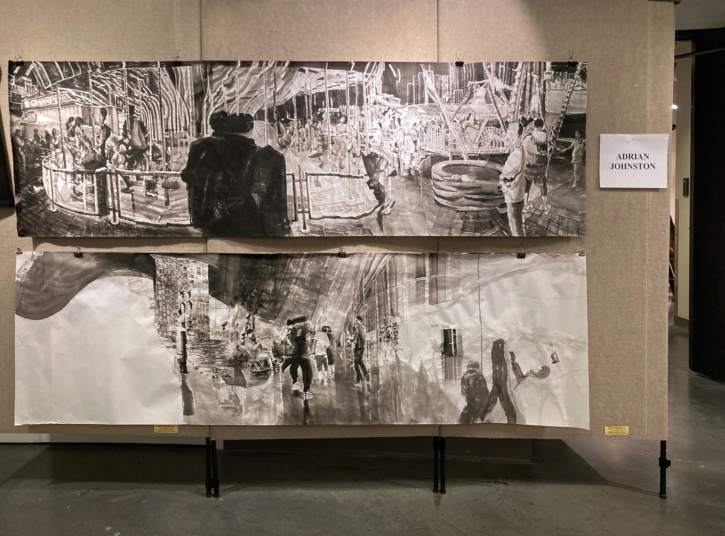
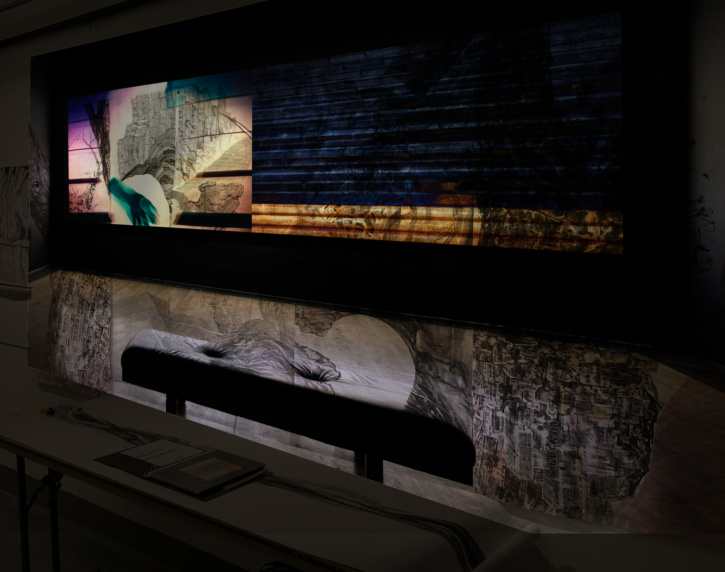
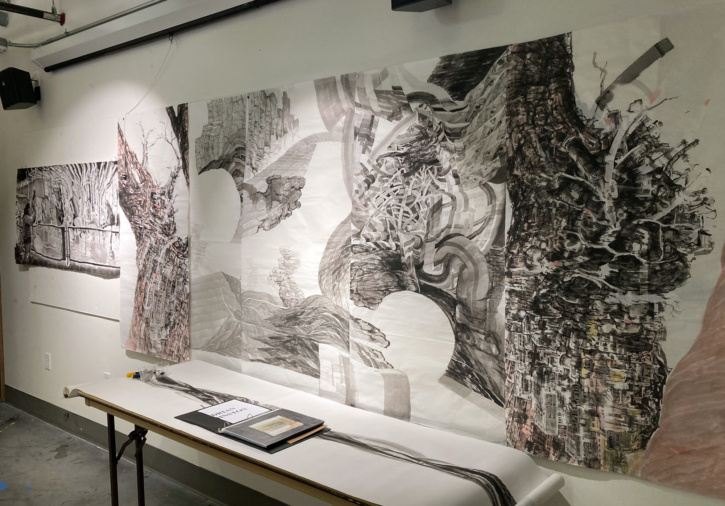
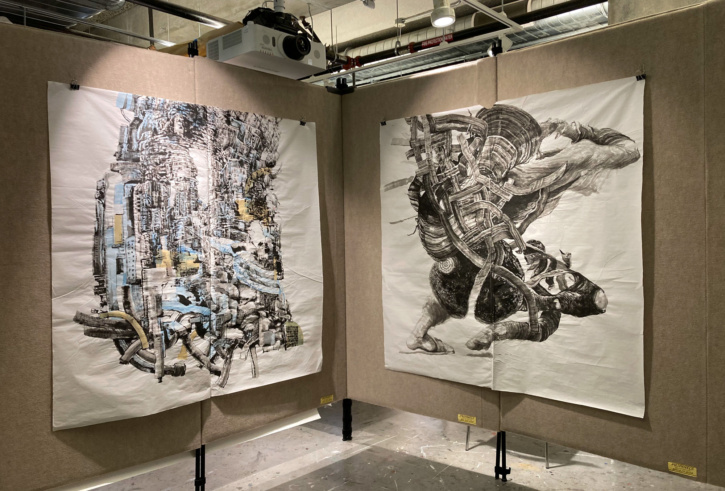
<VIDEO + SOUND>
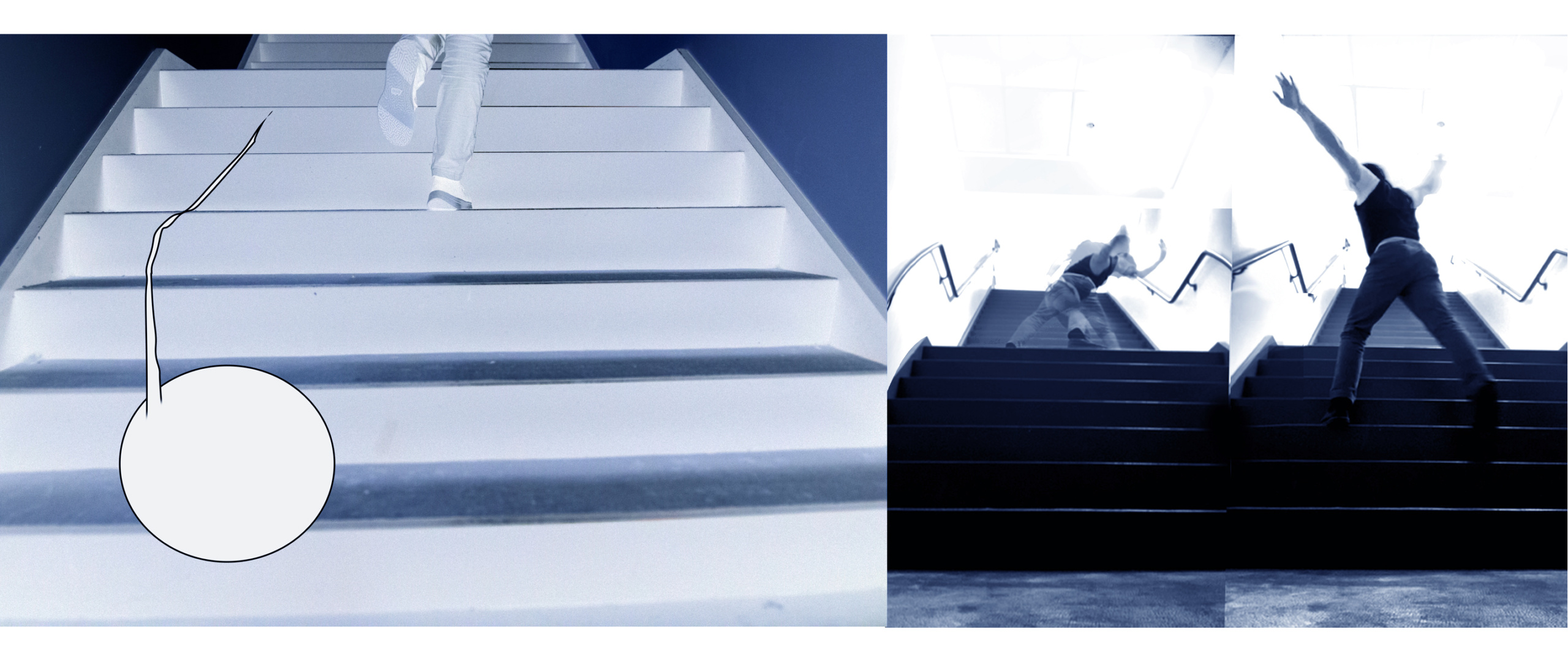
STAIRS
concepts for video installation
Artist’s Summary
“What does it mean to paint something just as it is?”
Diverging from last semester’s work, which was loaded with overlaps of imagery-collapsing suggestions of time and space, I took my studio practice on the road. Over two months, I shifted my mediums to what could be found en route, and in doing so, engaged my advisor’s question materially. Ink became the medium immediate. Ink allows a direct, not wholly controlled, and relatively indelible way of painting. It limits color concerns, and allows for concentration on structure and mark making, which connected to my intuitive exercises from February and March. In digesting the June residency’s presentation on figuration rooted in distortion and whimsy, and attempts to understand how distortion could function to convey presence in the passage of time led me to explore contemporary urban street scenes and countryside vistas. Utilizing a broad field of panoramic vision, I explored ways of preconceiving experience of environments, and reflections on recorded time both instantaneous and extended. In both processes, I found the integration of abstract and representational information. My work was enriched by the Chengdu Biennial which showcased contemporary artists in both traditional and multi-media/cross disciplinary 2, 3, and 4D work, and considered the way Chinese tradition carries through contemporary mediums. The work I produced in the summer includes a group of street scenes, a series of design collages, and a two groups of ink on paper works.
On returning to Boston, I began working with my studio mentor Joel Janowitz. I re-engaged the discipline of oil painting, and continued working in ink and collage. I saw an exhibition of his work in late August, both paintings and monotypes, and he directed me towards several shows, including Gerry Bergstein’s work at Naga Gallery. In studio visits, he noted distinctions between my limited palette charcoal and ink work that were completed in a short timeframe, and oil paintings that tended to lose vitality with extended niggling. I learned that the structure of an image is critical to conveying meaning, whether completed in an hour or in a year. My advisor Alex Jackson confirmed this, sharing a quote from jazz giant Wayne Shorter: “Improv is just Composition sped up, Composition is just improv slowed down.” As with limits in the ink paintings, and while still building out of the clutter, i am trying to be more intentional about the parameters of what spaces i am filling and what they do within the painting. Through Joel’s and Alex’s help, I improved my process of color mixing and using tools that allow for dealing with the whole, instead of approaching the painting and the process in somewhat unrelated “neighborhoods.” While this practice lead to many small (though enjoyable) “neighborhood” works, my larger paintings were prone to re-starts and overpaintings, and several oils I have cooking won’t be presented for the winter residency.
I also explored sound this semester, and engaged audio/visual experiences including John Akomfrah’s six channel video “Purple,” Stone Johnston’s four channel video “Sublimation,” and research into the history and practices of creative visual and aural intersections. From neurophysiologist Nikolai Bernstein, I learned that the brain narrates, or runs projections, and maintains dialogical comparisons with actual consequences. The possibilities of moving simulated interior models into material reality, and inaudible gestures into actual medium lead me to a practice of movement exercises which I began recording. In time lapses and sound pieces, I conceived the beginning of another iteration of improvisation/composition building, a series of distortions and adjustments that evoke the fabric of “passage,” creating intersections connecting internal and external, house and home…things “just as they are.” These artworks are the connective tissue of that passage: the ongoing oil paintings rooted in the poetic tradition of lament (אֵיך eicha and rithā’ رثاء), which recognizes complex voices in discombobulation around a time collapsing experience of loss; a series of ink on paper paintings conveying a shared moment of time. This group of work in oil, ink, and video is an accumulation of intuitive lines, re-contextualized images, and recorded movements in an archive of hopeful marks.
June 2023 [GROUP 2]
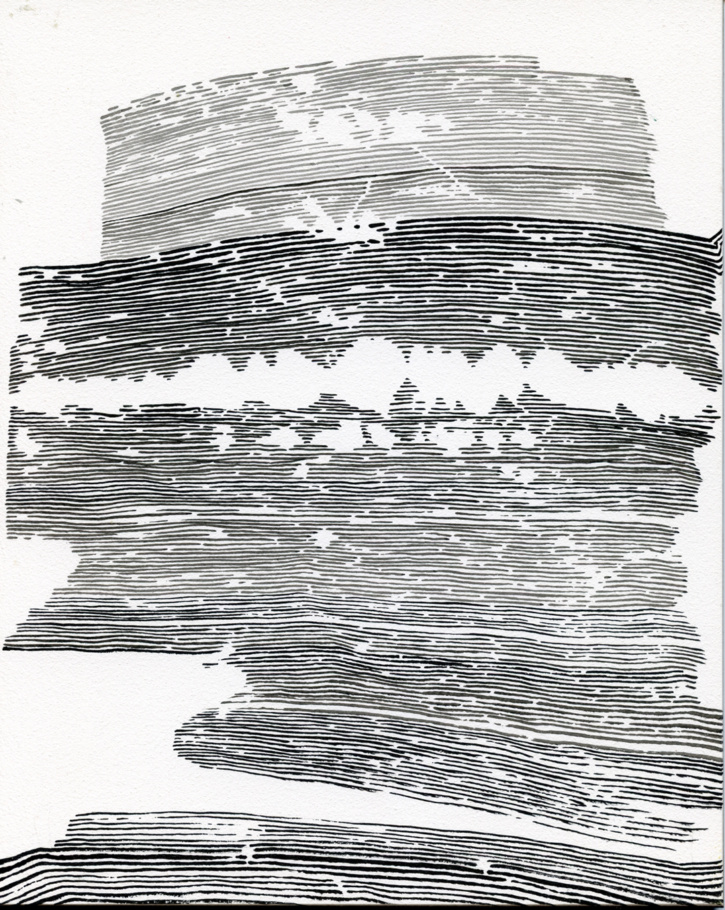
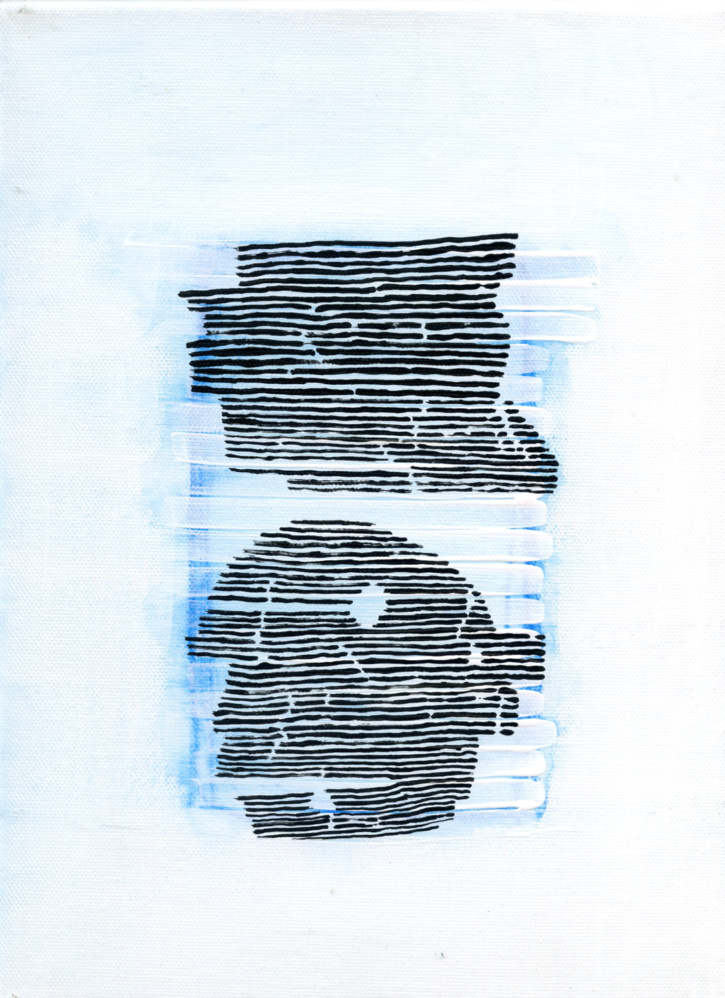
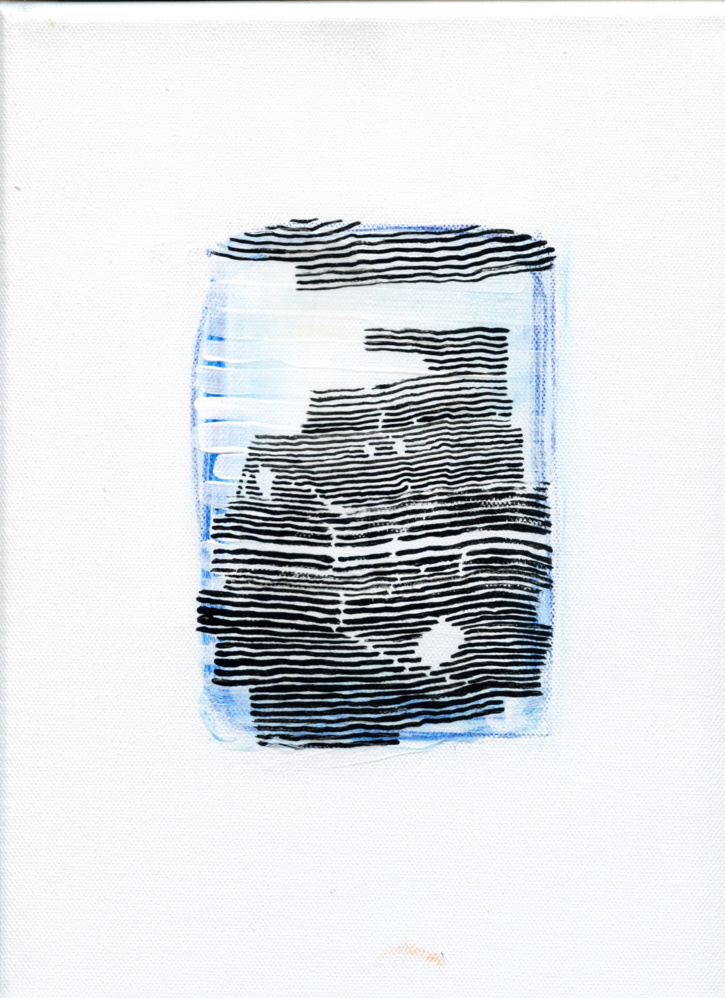
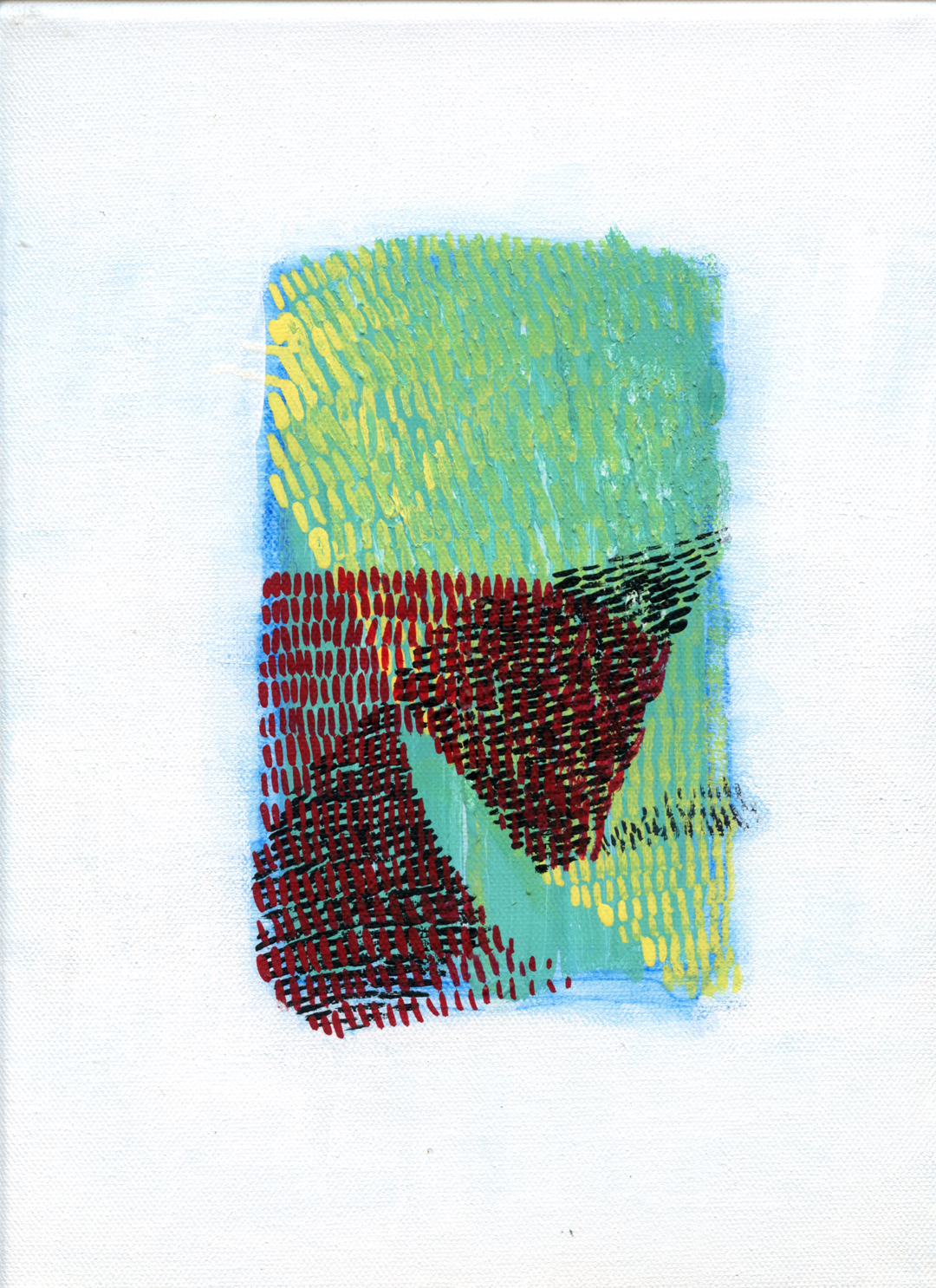
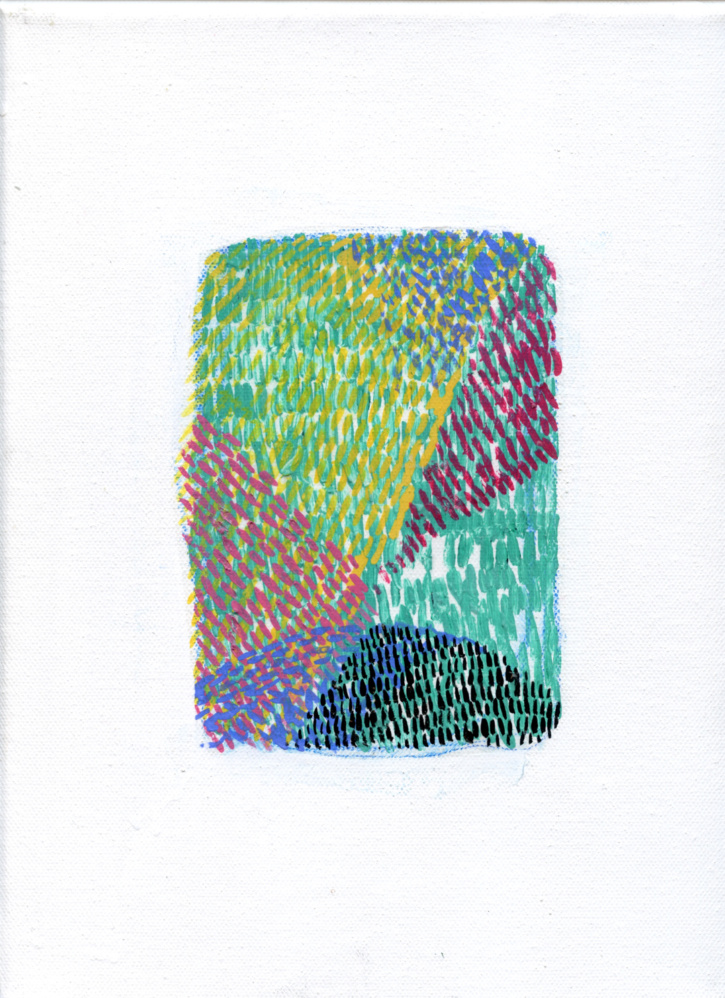
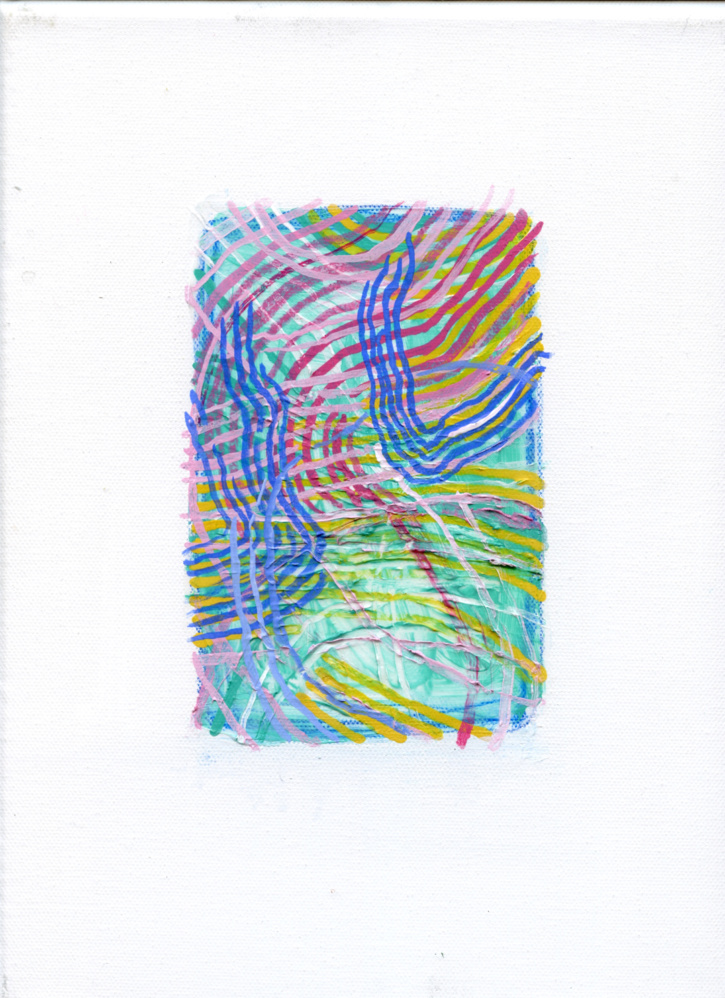
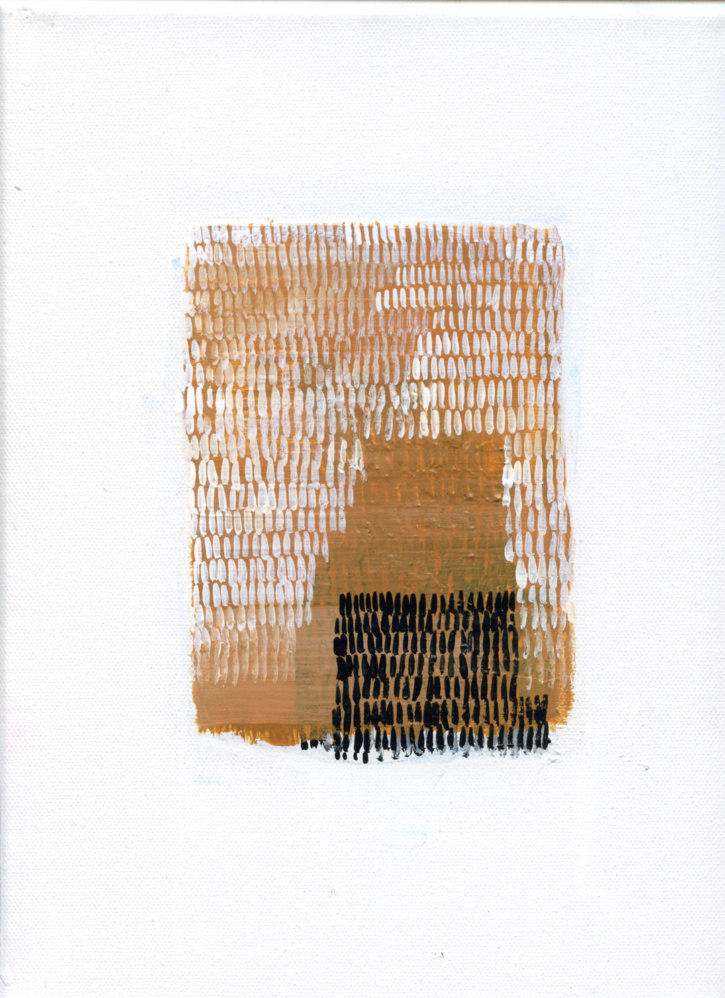
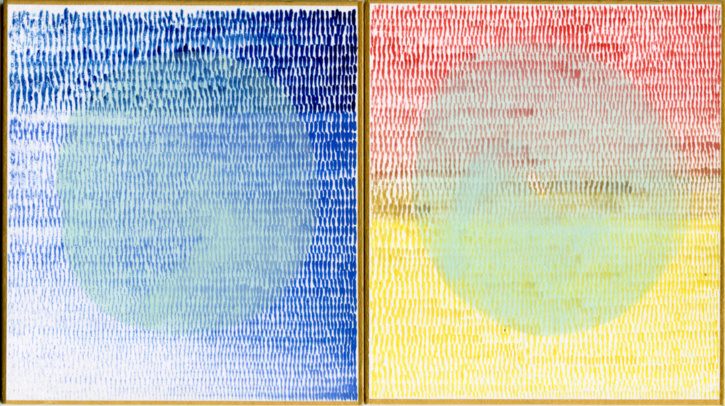
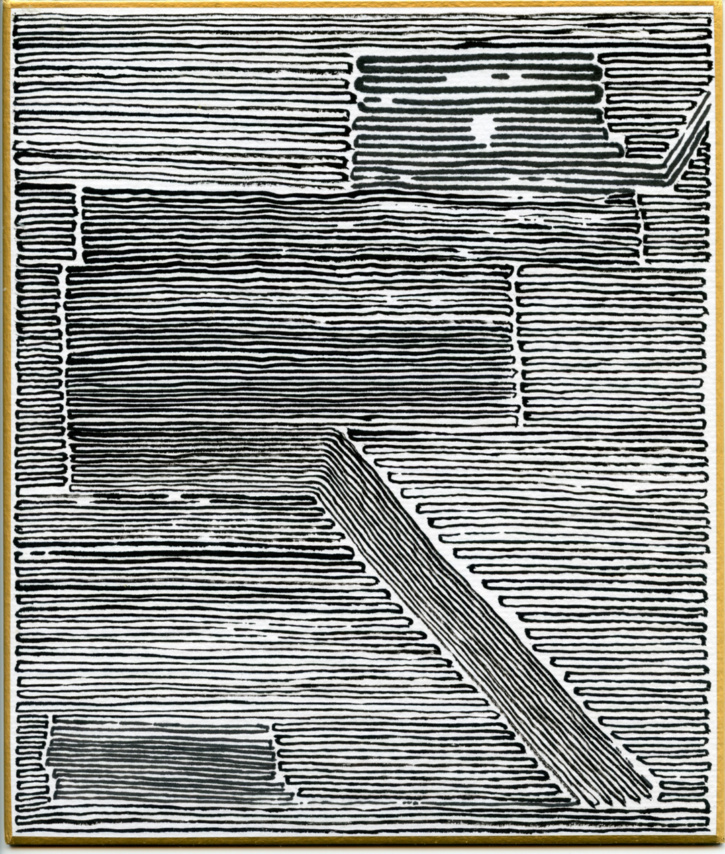
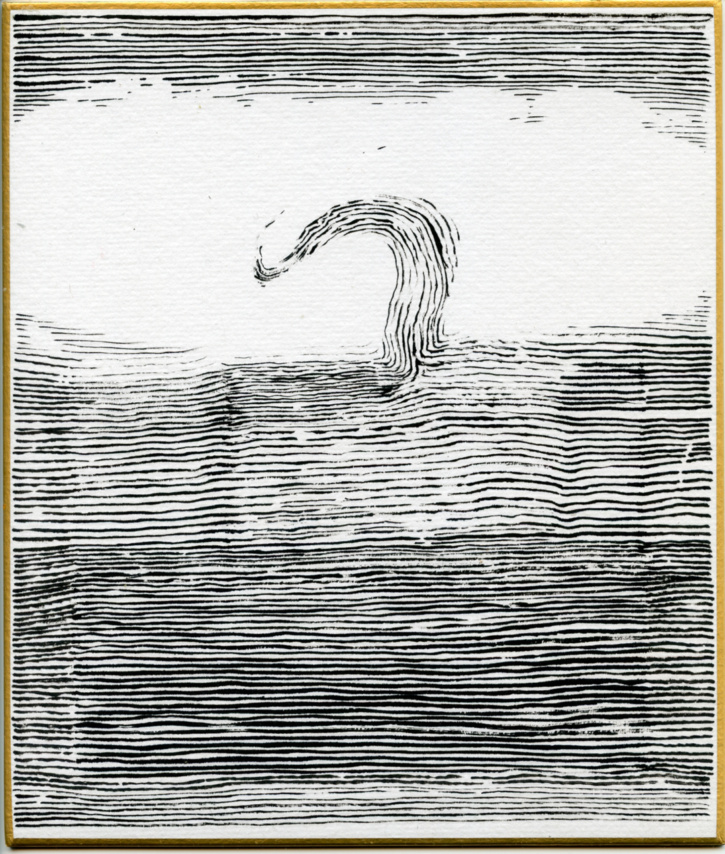
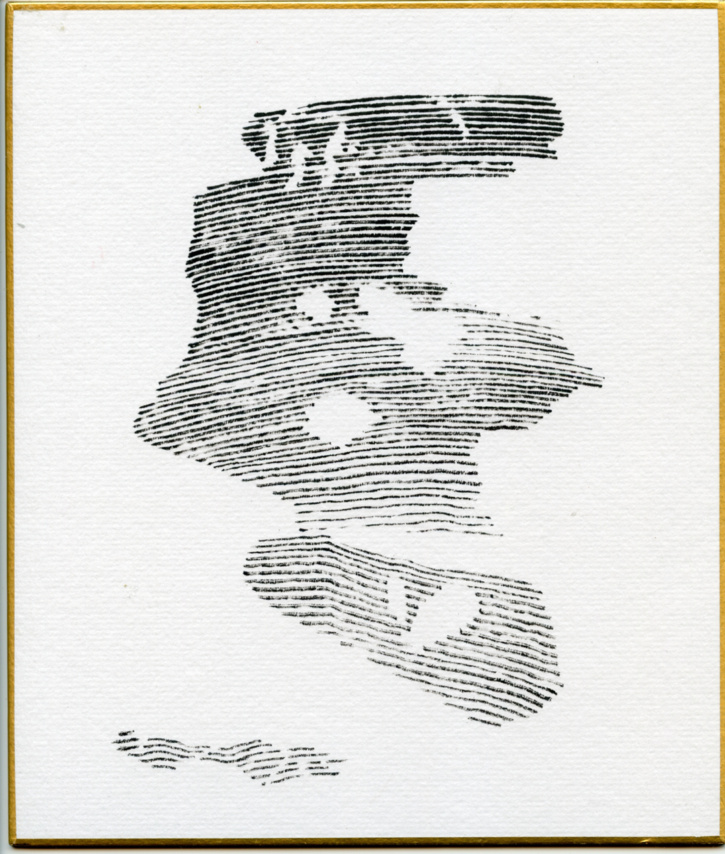
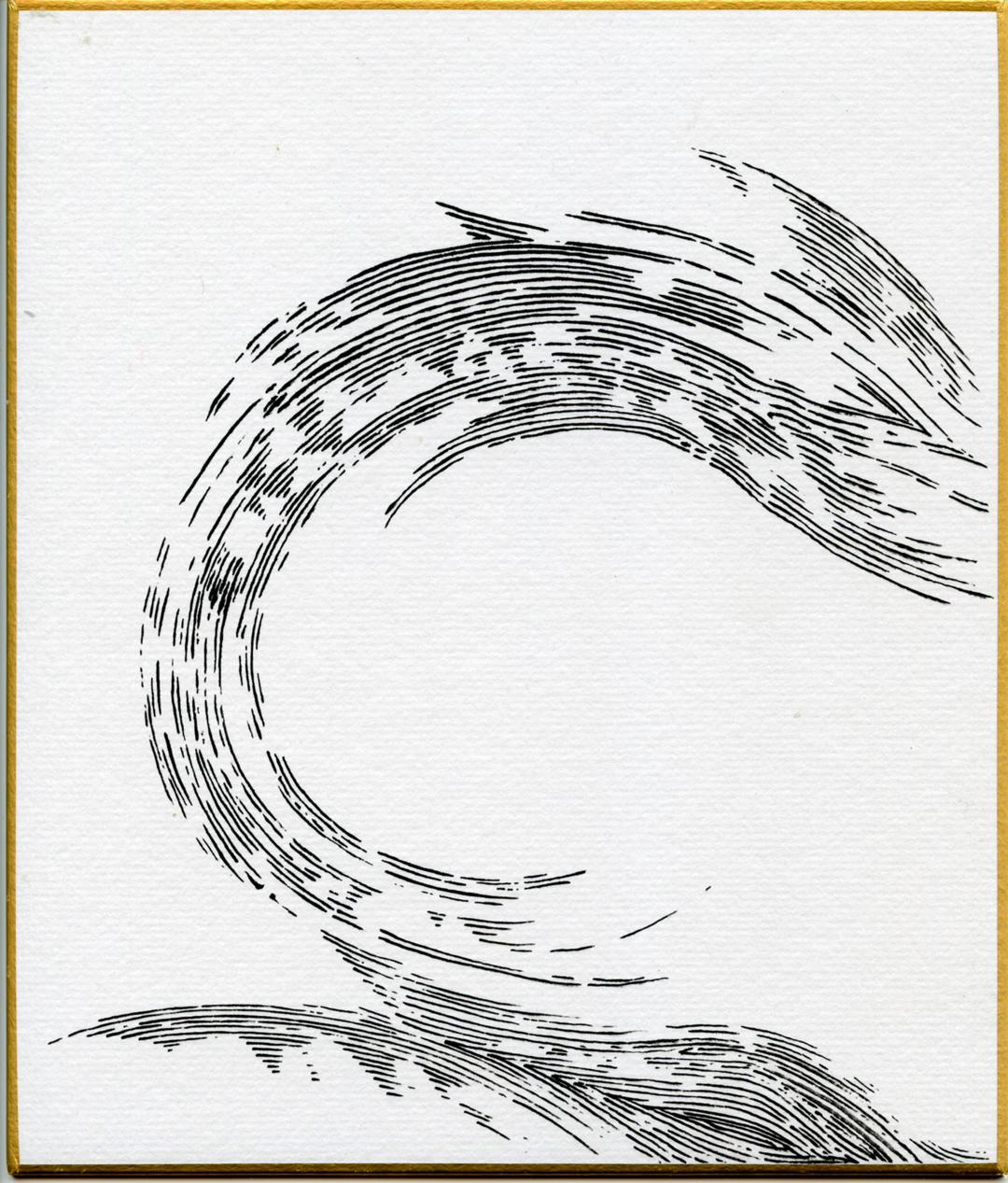
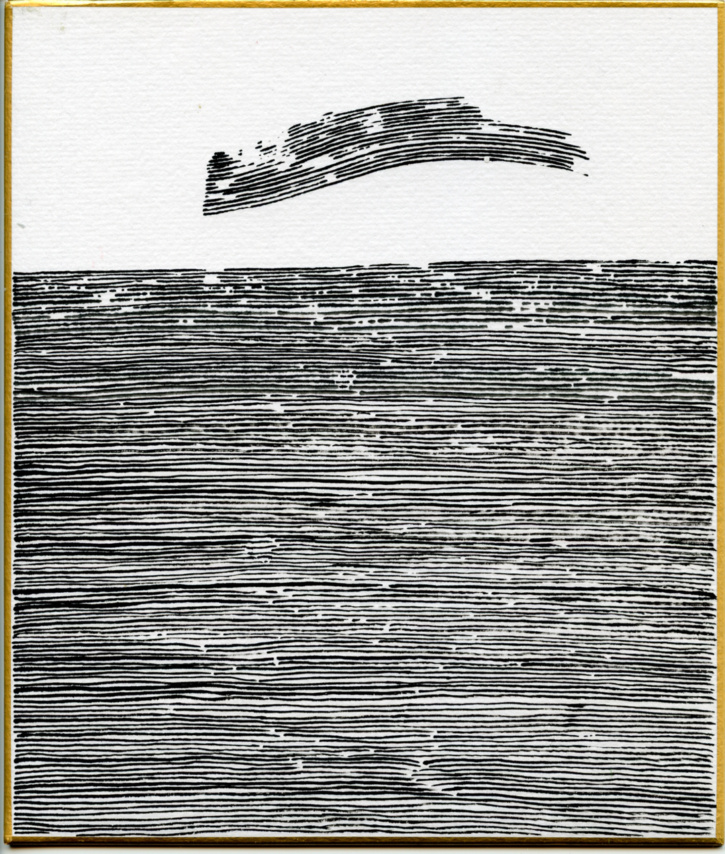
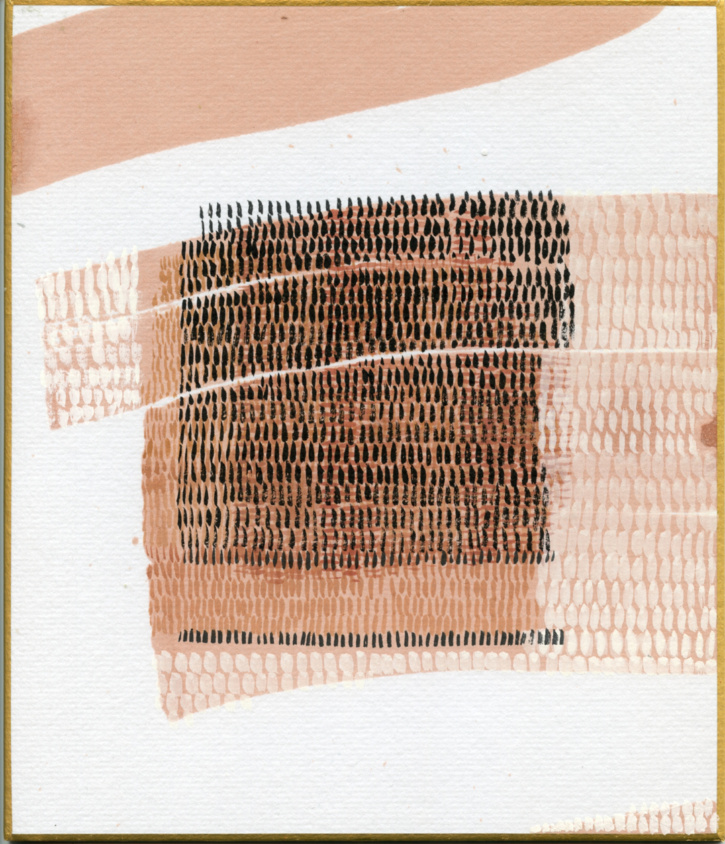
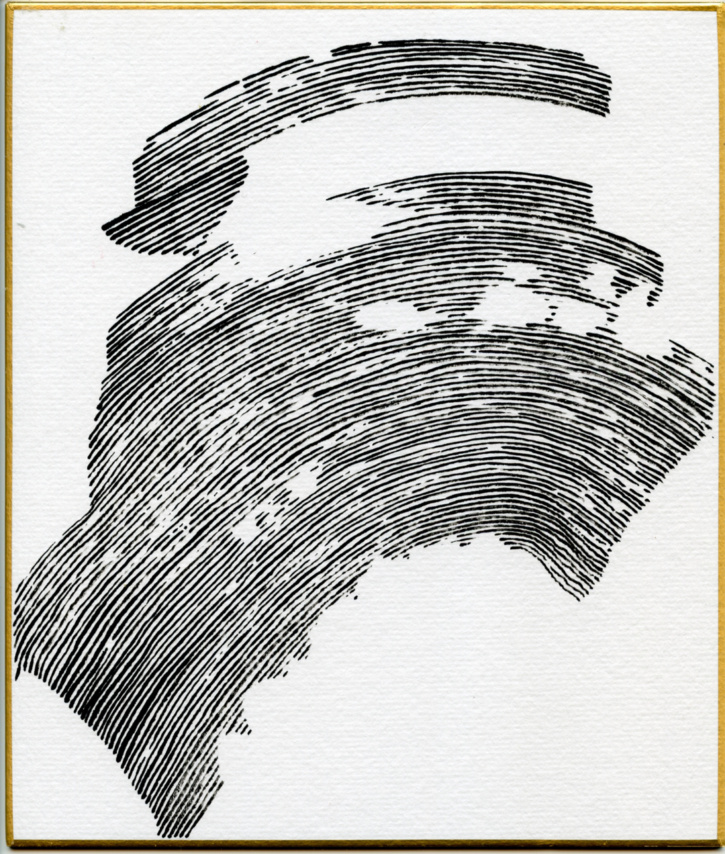
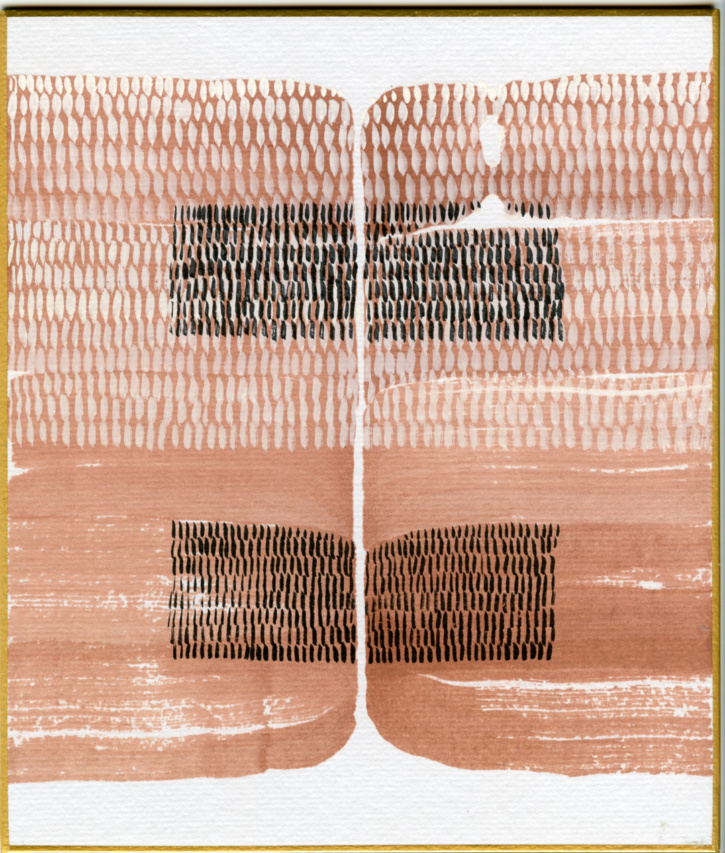
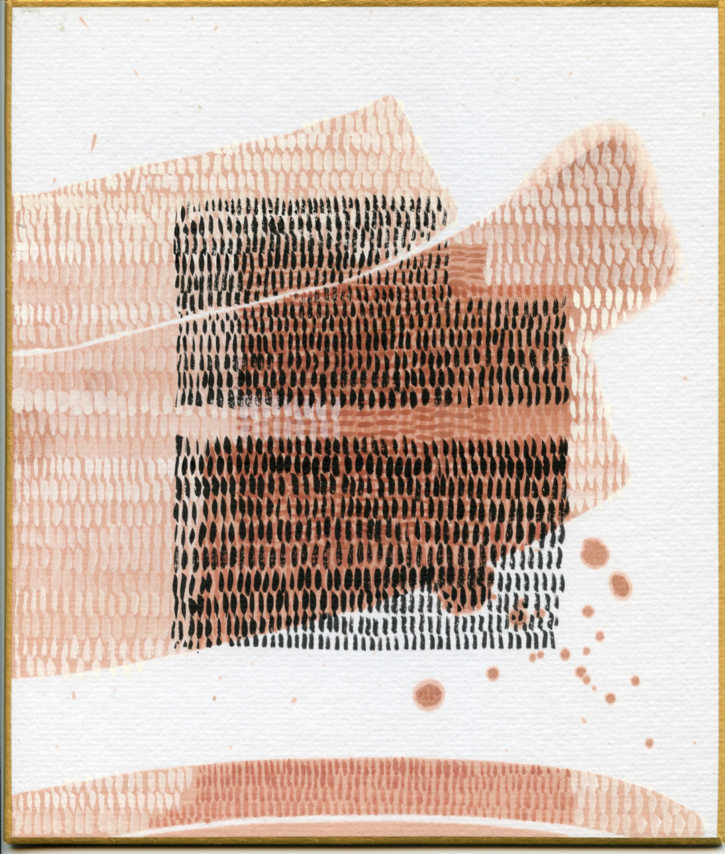
Artist Statement:
In my first semester of the MFA program in Lesley Art + Design, I delighted in the opportunity to expand visual and conceptual language through a consistent practice of drawing, painting, and recording. From previous artworks and illustrations I found continuity in seeking to translate nuanced visual narratives to larger format 2D works. My process continues to function as a means to archive modes of perception, intuitively and analytically. This dual lens finds an abundance of stimuli, from experience in both eastern and western hemispheres to interest in linear abstraction, music, literature, history, theology and myth, leading to imagined spaces where memory mixes with un/fixed notions of the present, and I document my experience of scale and time.
I began in January with a series of visual experiments. These flat, abstract studies focus on isolating intuitive operation in the painting/viewing process. I found that keen awareness of these signals led to form and possibility. I simultaneously engaged with landscape in varied artworks, often returning to Chinese master ink paintings and Korean masked folk dance—a sense of magisterial movement containing blooms of human activity in expansive nature. Surprisingly, I found the aesthetics of 山水 (shanshui) brushwork and 水袖 (shuixiu) dance echoed in Breugel’s “metaphysical objectivity”—his way of placing the ugly and the ordinary in beautiful compositions and natural contexts. Breugel’s work encouraged my interest in representing historical themes in the context of contemporary issues. However, he worked almost entirely within illusionistic space. I still felt tension between abstract vocabulary (which felt direct and authentic as a process) and figural representation (which is my background and inclination). Under the guidance of my mentor, Emily Eveleth, works by Antonio Lopez Garcia, Amy Sillman, and Wangechi Mutu helped frame the trajectory, provide reasonable methods, and define points where abstract and representational impulses coexist. Sillman noted that figuration is the construction of abstraction that operates synthetically on pre-understood forms/colors/lines. As on a cave wall, a line can be itself, or more, or as in the work of the Italian Siennese painters (Duccio, Sasseta). Here, flat space is enchanted, and scale-shifting figure/ground elements can exist magically under construction—the realm of “becoming” and change.
In June, I visited the National Gallery in Washington D.C. and saw “Philip Guston Now.” An artist who constantly changed, Guston consistently endeavored to paint his way through complex concerns. Despite political corruption, social injustice, war, health, personal, and professional identity crises, Guston’s paintings reflect consciousness of paradoxes of thought and action (in his visual vernacular), gain and loss (in the actual process of painting) amongst incongruous but conversant images. Often, the linchpin is irony. Nonetheless, real loss and tragedy are present, evoking sincere lamentation. This lead me to ask if in a culture inundated with visual meaning whether visual lament is an authentic way of responding to loss? The architect and artist Alfred Jaar cautioned that in lieu of depicting a grieving mourner or sensationalizing the body of the victim, art must contain a real personal response. Whether losses of life, speech, ownership, autonomy, purity, diversity, or otherwise, the expression of grief in a relational context can create a shared space unadorned by superficial reaction. Guston sought to place himself within that response. I saw potential in painting to recognize complex voices in lament through re-contextualized images from art history, social media, my own daily commute and dreams in evolving exploratory marks. It is at these intersections that I arrive with three veins of work: oils (“Eicha” paintings), small abstracts that explore the intuitive process, and a developing group of large sequential charcoal drawings (each 42×60”).
January 2023 [GROUP 1]
Critique Space, Lunder 320
Illustration Portfolio
Painting Portfolio
Artist Statement
In my art practice, I maintain tension between process and product. My work employs the figure in empty or imagined environments, hovering between surface and story. I express presence through color, and a sense of time through the history of accumulated line. The hope of realizing an unanticipated visual resonance impels me both towards adding layers, and to subtractive research in the depth of the surface. When I deconstruct the figure, or avoid it altogether, I search for fitting symbols in its place. The weight of the body, its dynamic suspension, ambiguous direction, and presence references communal experience, an archetype of divine or spiritual presence. Scaffolded buildings in urban landscapes—yet another corporation of the human body—create symbolically charged mundane environments, where impermanence and change is a continuum of organic deconstruction and renewal. My works are influenced by songs, literature, and myth, and hence engage the imagination and psyche. As illustrations these paintings are stylized recombinations of physical, cultural, and psychological variables, and seek to create nuanced visual narratives.
The poles of material surface and depth of illusion, perceptions of value and worthlessness, subjectivity and objectivity, identity imposed and reality observed, the painting as book and the book as object—resonate with me visually. I would like to grow in translating these concepts across other mediums and disciplines as well, through narrative and sequential elements that examine inherited stories in ways that enable a renewal in the experience of meaning, perceiving the poetry of multivalent life and the complexity of truth. Hans-Georg Gadamer described art as play, symbol, and festival. I hope my work can become a catalyst for community, a way to share the known and unknown, and a unique and serious kind of playground.
